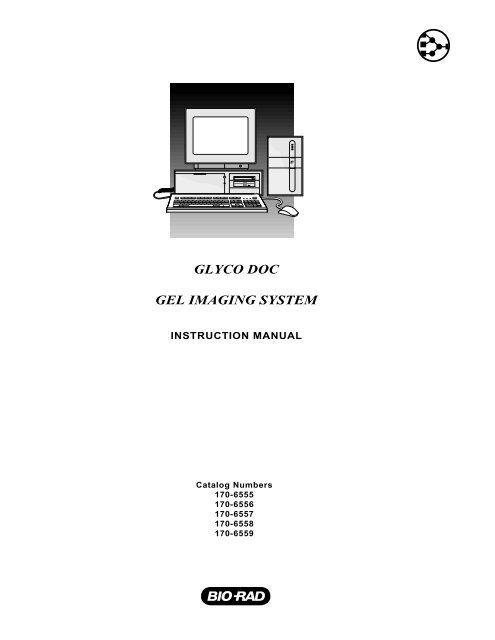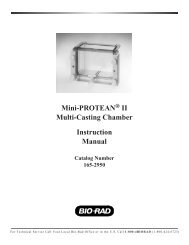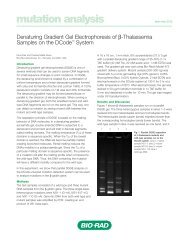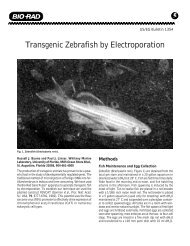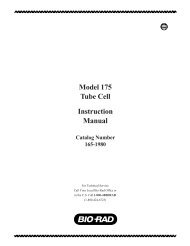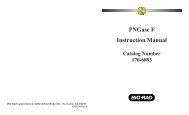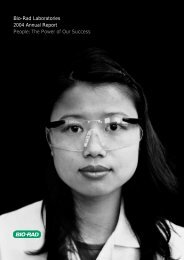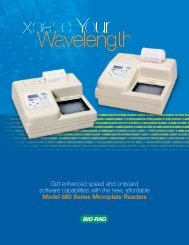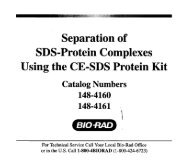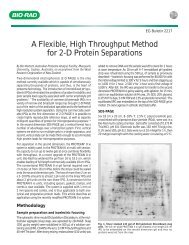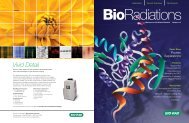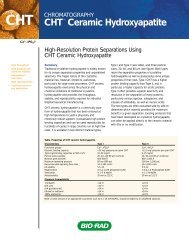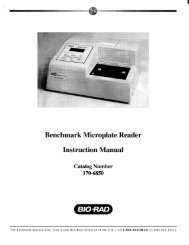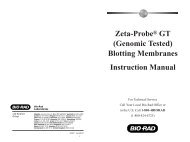GLYCO DOC GEL IMAGING SYSTEM - Bio-Rad
GLYCO DOC GEL IMAGING SYSTEM - Bio-Rad
GLYCO DOC GEL IMAGING SYSTEM - Bio-Rad
Create successful ePaper yourself
Turn your PDF publications into a flip-book with our unique Google optimized e-Paper software.
<strong>GLYCO</strong> <strong>DOC</strong><br />
<strong>GEL</strong> <strong>IMAGING</strong> <strong>SYSTEM</strong><br />
INSTRUCTION MANUAL<br />
Catalog Numbers<br />
170-6555<br />
170-6556<br />
170-6557<br />
170-6558<br />
170-6559
Table of Contents<br />
TABLE OF CONTENTS<br />
Safety<br />
Section 1.0 Installation and Startup ...............................................................................................1<br />
1.1 Unpacking.......................................................................................................................2<br />
1.2 Set-up the Computer and Imager...................................................................................2<br />
1.2.1 Installing the Camera Circuit Board in a Computer..............................................2<br />
1.2.2 Setting Up the System..........................................................................................4<br />
1.2.3 Installing the Glyco Doc Software ........................................................................6<br />
1.3 Verify system Operation .................................................................................................7<br />
1.3.1 Starting the Glyco Doc Software ..........................................................................7<br />
1.3.2 Acquire an Image using the Test Plate.................................................................8<br />
1.4 Image Analysis Using the Image Provided with your System........................................10<br />
1.5 Preparing for Gel Imaging ..............................................................................................13<br />
1.6 Example of a Standard Lane Analysis ...........................................................................14<br />
Section 2.0 Software Reference......................................................................................................15<br />
2.1 Files Menu......................................................................................................................15<br />
2.2 Image Menu ...................................................................................................................18<br />
2.3 Bands Menu ...................................................................................................................21<br />
2.4 Options Menu .................................................................................................................24<br />
2.5 Window Menu.................................................................................................................25<br />
Section 3.0 Theory of Operations...................................................................................................28<br />
Section 4.0 Maintenance And Troubleshooting.............................................................................29<br />
4.1 Replacing the UV Light ..................................................................................................29<br />
4.2 Cleaning the Excitation Filter .........................................................................................31<br />
4.3 Preparing Gel plates.......................................................................................................32<br />
4.4 Creating a New bright field.............................................................................................32<br />
4.5 Imager Troubleshooting..................................................................................................34<br />
4.6 Software Troubleshooting...............................................................................................35<br />
4.6.1 Memory Problems.................................................................................................35<br />
4.6.2 Windows ...............................................................................................................35<br />
Appendix A. Initialization File ...........................................................................................................36<br />
A.1 Window Display Defaults................................................................................................36<br />
A.2 Standard Lane Option Defaults......................................................................................36<br />
A.3 Colors .............................................................................................................................37<br />
A.4 Band Descriptions ..........................................................................................................38<br />
A.5 Last Exposure Time........................................................................................................39<br />
A.6 Bright File Locations.......................................................................................................39<br />
A.7 Default Data Locations...................................................................................................39<br />
Appendix B. Imager Specifications ..................................................................................................40<br />
Appendix C. Warranty and Ordering Information ...........................................................................41
Table of Contents<br />
Figures<br />
1. Glyco Doc Imaging System ............................................................................................................1<br />
2. Installing the Camera Board in the Computer................................................................................3<br />
3. Glyco Doc Imaging System Cable Connections ............................................................................4<br />
4. Imager Power and Filter Indicators ................................................................................................5<br />
5. Glyco Doc Icon ...............................................................................................................................7<br />
6. Test Plate........................................................................................................................................8<br />
7. Image Display, Control, and Status Windows ................................................................................11<br />
8. SE1000 Camera Control Panel ......................................................................................................18<br />
9. Imaging System Functional Diagram .............................................................................................28<br />
10. Inside the Imager............................................................................................................................30<br />
Tables<br />
1. Preparing Gels for Imaging ............................................................................................................13<br />
2. Typical Exposure Strategies...........................................................................................................19<br />
3. Imager Troubleshooting..................................................................................................................34
Safety<br />
SAFETY<br />
!<br />
Warning<br />
Disconnect the Glyco Doc Imager before servicing. Refer servicing to <strong>Bio</strong>-<strong>Rad</strong><br />
service personnel.<br />
This Glyco Doc Imager is certified to meet the I.E.C. 1010* safety standard. Certified products are safe to<br />
use when operated in accordance with the instruction manual. This safety certification does not extend to<br />
other equipment or accessories not I.E.C. 1010 certified, even when connected to this Glyco Doc Imager.<br />
This instrument should not be modified or altered in any way. Alteration of this instrument will void the manufacturer’s<br />
warranty and create a potential safety hazard for the user.<br />
<strong>Bio</strong>-<strong>Rad</strong> is not responsible for any injury or damage caused by the use of this instrument for purposes other<br />
than for which it is intended or by modifications of the instrument not performed by <strong>Bio</strong>-<strong>Rad</strong> or an authorized<br />
agent.<br />
Important: This product conforms to the class A standards for Electromagnetic Emissions, intended for laboratory<br />
equipment applications. It is possible that emissions from this product may interfere with some sensitive<br />
appliances when placed nearby or on the same circuit as those appliances. The user should be aware<br />
of this potential and take appropriate measures to avoid interference.<br />
* I.E.C. 1010 is an internationally accepted electrical safety standard for laboratory instruments.
Installation and Startup<br />
1.0 INSTALLATION AND STARTUP<br />
The Glyco Doc Imaging System simplifies analysis of small format carbohydrate electrophoresis gels. Its<br />
primary components are the Imager, the Glyco Doc analytical software, and a host computer. The Imager is<br />
suitable for both fluorescent and visible dye applications. The Glyco Doc analytical software features automatic<br />
acquisition and analysis of fluorescent labeled oligosaccharide and monosaccharide gels, as well as<br />
DNA and Protein gels and gels stained with visible dyes.<br />
Figure 1. Glyco Doc Imaging System<br />
The Glyco Doc Imaging System provides the following features:<br />
• Integrated, high resolution CCD camera for gel imaging<br />
• Emission Filter switch, located on the Imager’s back panel, allows easy selection between Glyco<br />
Doc 500 nm and 600 nm imaging<br />
• Automatic exposure<br />
• Automatic band detection<br />
• Automatic quantitation and migration analysis<br />
• Support for numerous graphic file formats, including .tiff and .wmf<br />
• Export data and text for universal spreadsheet and word processing use<br />
• Report generator, for printing image display, band data, and densitometer readings<br />
1
Installation and Startup<br />
1.1 UNPACKING<br />
Carefully inspect the shipping cartons for any damage which may have occurred in shipping. Severe damage<br />
to a carton may indicate damage to its contents. If you suspect damage to the contents may have<br />
occurred, immediately file a claim with the carrier in accordance with their instructions before contacting <strong>Bio</strong>-<br />
<strong>Rad</strong> Laboratories.<br />
Open each of the shipping cartons and lift each component out of its packing. Check the contents against<br />
the supplied packing list. Inspect each component for external damage. If any part is missing or damaged,<br />
contact <strong>Bio</strong>-<strong>Rad</strong> Laboratories immediately.<br />
1.2 SET-UP THE COMPUTER AND IMAGER<br />
The setup procedure is organized into the following sections:<br />
• Section 1.2.1 is for those who purchased a system without a computer. This section discusses how<br />
to install the imager circuit board in your computer.<br />
• Section 1.2.2 is for all users. This section discusses how to set up all components in the system.<br />
1.2.1 Installing the Camera Circuit Board in a Computer<br />
Your host computer must be a standard IBM compatible PC, configured with the following minimum hardware<br />
and software:<br />
• 386 computer with math co-processor, running at 20 MHz or better, with at least 1 empty 16-bit<br />
expansion bus slot<br />
• 4 megabytes of RAM<br />
• VGA Display (640 by 480 resolution, 256 colors or shades of gray)<br />
• MS Windows and a compatible pointing device, such as a mouse<br />
In addition, because each Image file is approximately one half megabyte, the following storage devices are<br />
recommended.<br />
• A large-capacity hard disk (200MB or greater).<br />
• An optical disk drive. Although Images can be stored on floppy disks, an optical disk drive provides<br />
much greater storage capacity and provides high reliability. We recommend each user have their<br />
own removable optical disk to be stored in the same manner as other valuable media.<br />
!<br />
Caution/Warning<br />
Turn off and unplug the computer prior to removing its cover.<br />
2
Installation and Startup<br />
To install the camera board, follow the procedure below.<br />
1. Turn off your computer and unplug the power cord.<br />
This procedure assumes the computer was previously set up and used for other applications.<br />
2. Turn off all connected peripheral devices.<br />
Connected devices include printers, monitors, etc.<br />
3. Remove the cover from your computer.<br />
Refer to the documentation supplied with your computer system.<br />
4. Discharge static electricity.<br />
Make sure the computer is turned off and unplugged! Discharge static electricity by touching, with the<br />
back of your hand, a grounded metal surface such as the metal frame of the computer.<br />
5. Locate any unused 16-bit bus expansion slot inside your computer<br />
Expansion slots almost always run from the front of the computer to the back. A 16-bit slot is divided<br />
into two sections. (See Figure 2.)<br />
6. Remove the slot cover, which is located on the back of the computer.<br />
Removing the small slot cover on the back of the computer will allow you to attach a cable to the<br />
Camera board.<br />
Figure 2. Installing the Camera Board in the Computer<br />
3
Installation and Startup<br />
7. Place the Camera board in the slot<br />
The connector on the Camera board must face the back of the computer. Insert the board, pressing<br />
firmly so that it slips into place.<br />
8. Re-mount the screw removed in Step 6.<br />
This screw will hold the board in place.<br />
9. Re-mount the computer cover and its screws.<br />
Proceed to section 1.2.2, Setting up the System.<br />
1.2.2 Setting Up the System<br />
To set up the computer, you will need to make the connections shown below. Be sure to remove the small<br />
metal antistatic plug from the Imager’s computer cable connector. This plug protects the connector during<br />
shipping. Remove and save it for storage or shipment.<br />
Each cable is designed to fit a specific connector; where there is some doubt, note the number and configuration<br />
of the pins in the connector. Refer to Figure 3 and to the computer vendor’s documentation that was<br />
shipped with the computer. If you are using any peripheral computer devices with your system, refer to that<br />
device’s separate documentation for connecting to the computer.<br />
MONITOR<br />
IMAGER<br />
COMPUTER<br />
PRINTER<br />
KEYBOARD<br />
MOUSE<br />
Figure 3. Glyco Doc Imaging System Cable Connections<br />
4
Installation and Startup<br />
To set-up the Imager, you need a Phillips head screw driver. Refer to Figure 4.<br />
1. Locate the Filter Lock Screw on the bottom of the Imager and turn it counter clockwise, two complete<br />
turns.<br />
The Filter Lock Screw is encircled by an orange marker on the bottom of the Imager. The Filter is<br />
locked in place for shipping.<br />
2. Test to see that the filter is now free by twisting the Filter Switch.<br />
The Filter Switch is the black plastic knob on the back of the Imager. Looking from the back of the<br />
Imager, switch positions are 2 o’clock for 600 nm (Ethidium Bromide) and 10 o’clock for 500 nm (ANTS)<br />
labeled gels. Leave the switch at the 10 o’clock position. When the Imager is turned on, the selected<br />
filter will be indicated in the Imager’s front panel.<br />
Check for proper cabling and general system performance:<br />
1. Turn on the Imager.<br />
2. Turn on the computer and any peripheral devices.<br />
3. Check the Imager’s front panel to see that the Power and Filter Lights are lit.<br />
Rotate the Filter Switch to verify both Filter LEDs are working properly. See Figure 4 for the location of<br />
the Filter Switch.<br />
POWER LED<br />
500 nm FILTER LED<br />
600 nm FILTER LED<br />
BUSY LED<br />
ON/OFF<br />
SWITCH<br />
POWER<br />
OUTLET<br />
CONNECTOR<br />
TO COMPUTER<br />
FILTER<br />
SWITCH<br />
FRONT<br />
VIEW<br />
FILTER<br />
LOCK SCREW<br />
(LOCATED UNDER UNIT)<br />
REAR<br />
VIEW<br />
Figure 4. Imager Power and Filter Indicators<br />
5
Installation and Startup<br />
1.2.3 Installing the Glyco Doc Software<br />
Note<br />
If your purchase included a computer, proceed to section 1.3. Your computer<br />
was shipped with the Glyco Doc software installed.<br />
To install the Glyco Doc software, you need the following items:<br />
• 1 Glyco Doc setup disk<br />
• 1 Glyco Doc image disk<br />
To install the Glyco Doc software, follow the procedure below.<br />
1. Insert the Glyco Doc Setup disk into an available floppy drive.<br />
The computer must be turned on and display the DOS prompt or MS Windows startup screen. You may<br />
place the disk in any available 3.5” floppy disk drive. Typically, this is the a: drive. If you use the b:<br />
drive, substitute b: for a: in the following steps.<br />
2. Start the Install software.<br />
If the DOS prompt is displayed, type:<br />
win a:\setup.<br />
If the MS Windows Program Manager is displayed, select Run... from the File menu and then type:<br />
a:\setup<br />
3. Select the desired directory name where the Glyco Doc software files are to be placed.<br />
The installation routine will prompt for a directory name and location. The default is<br />
c:\glycodoc<br />
If a different directory is desired, enter that name instead. If you are re-installing the Glyco Doc software,<br />
the installation routine will overwrite any existing Glyco Doc files in this directory.<br />
4. When prompted, insert the Glyco Doc Image Disk into drive a: .<br />
The installation software will require a data subdirectory where image files will be stored. This will complete<br />
the installation.<br />
Note<br />
If you will not be using a large capacity removable media such as an optical<br />
disk drive, each user or project should have a subdirectory within the Glyco Doc<br />
directory. For example, Bob’s files might be stored in c:\glycodoc\bob.<br />
6
Installation and Startup<br />
1.3 VERIFY <strong>SYSTEM</strong> OPERATION<br />
This section provides a general description of the use of the Glyco Doc system.<br />
1.3.1 Starting the Glyco Doc Software<br />
When you power-up the computer, monitor, and Imager, a series of self-test and configuration status messages<br />
is displayed, followed by the C:\>, which is the indication that the system is ready.<br />
Start the Windows 3.1 interface software (by typing win), and then double click on the Glyco Doc icon to<br />
launch the Glyco Doc application. (Refer to the MS Windows User’s Guide for complete information on the<br />
use of MS-Windows 3.1.)<br />
Glyco Doc<br />
Glyco Doc<br />
Carbohydrate<br />
Analysis<br />
Figure 5. Glyco Doc Icon<br />
7
Installation and Startup<br />
1.3.2 Acquire an Image using the Test Plate<br />
To verify system operation, start by acquiring an image of the Test Plate.<br />
Note<br />
If you did not purchase a computer with the Glyco Doc system: Before doing<br />
any imaging, you must first create a Bright Field file. Refer to the chapter on<br />
Maintenance for discussion of the purpose of the Bright Field and the process<br />
for creating a Bright Field file<br />
IMAGE AREA SETUP PATTERN<br />
SE-1085<br />
Place cassette with the long plate down.<br />
Figure 6. Test Plate<br />
8
Installation and Startup<br />
To acquire an image using the text plate, follow the procedure below.<br />
1. Turn on the Imager and set the Filter Switch to 500 nm.<br />
The Power On/Off and Filter Switches are located on the rear of the Imager. The Filter Switch should<br />
be set to Carbohydrate, which uses a 500 nm filter.<br />
The LEDs on the front of the Imager indicate Power ON and the Filter setting.<br />
2. If you have not already done so, start the Glyco Doc software.<br />
Double-click on the Glyco Doc icon to start the software.<br />
3. Acquire an image.<br />
Select Acquire Options from the Image menu, and from the list that is displayed, select Select Image<br />
Rectangle.<br />
Follow the on-screen prompts. The first prompt instructs you to “Place the gel into the tray and slide the<br />
tray closed.” Place the Test Plate in the tray so that the silver strip along the edge faces into the Imager<br />
and the text printed on the test plate is not up-side-down. (See Figure 6.) Then select OK.<br />
The next prompt instructs you to select the area you want to image. To see the complete image, you<br />
may need to enlarge the display window. To do so, move the mouse so that the cursor is over the border<br />
of the image area; then hold down the left mouse button and move the mouse to enlarge the window.<br />
Then select OK.<br />
4. Acquire an image.<br />
Select Acquire from the Image menu, and from the list that is displayed, select Carbohydrate gel.<br />
5. From the SE1000 Camera Control window,<br />
a. Verify the Percent Saturation... radio button is selected, and it is set to 0.00.<br />
b. Verify the Normal Resolution radio button is selected.<br />
c. Click on the Acquire Image button in the SE1000 Camera Control window.<br />
Use the Up/Down arrows to change the setting.<br />
6. Follow the instructions presented.<br />
a. When prompted, place the Image Area Setup Pattern test plate into the gel holder.<br />
b. Follow the on-screen instructions.<br />
c. The acquired image is displayed. Enlarge the Image window, if necessary.<br />
7. Compare the resulting image with that of the test image printout found in the QC/Shipping packet.<br />
This printout was created using the same Image Area Setup Pattern test plate.<br />
If there are radical differences between the image you see and the test image printout provided with<br />
your imager, refer to the Imager Troubleshooting table in Chapter 4 to determine the problem and the<br />
appropriate corrective action.<br />
9
Installation and Startup<br />
1.4 IMAGE ANALYSIS USING THE IMAGE PROVIDED WITH YOUR <strong>SYSTEM</strong><br />
The key steps to analyzing an image are:<br />
• Open the image file (Use the image file demo1.RAW)<br />
• Adjust the image display<br />
• Find bands<br />
• Perform a standard lane analysis<br />
• Save the data file<br />
To analyze the sample image provided with your system, follow the procedure below.<br />
1. Open an image file.<br />
a. Select the Open command from the Files menu.<br />
b. From the Open File dialog box, select the image file demo1.RAW that has been provided.<br />
c. Press the OK button to open the file.<br />
2. Adjust the Image display’s Contrast and Brightness.<br />
The Image Histogram, shown in Figure 7, offers the following controls:<br />
• Contrast<br />
• Brightness<br />
• Autoscale, for automatically setting Contrast and Brightness.<br />
3. Locate bands using Glyco Doc’s automatic band location functions.<br />
These functions find all bands and mark with a + those bands whose data is displayed in the Band<br />
Tables.<br />
a. From the Bands pull-down menu, select either of the following:<br />
• To locate bands in a region, create a Marking Rectangle. Then, select Find Bands In Marked<br />
Rectangle.<br />
When defining a region, do not “crowd” the boundaries of a lane; include a small bit of the<br />
region beyond the band’s edge.<br />
• To find bands in the entire image, select Find Bands In Complete Image.<br />
b. Verify the number of lanes in the image area.<br />
Glyco <strong>DOC</strong> displays the number of lanes it has identified; if this number is not correct, enter the correct<br />
number.<br />
Note: When imaging the complete gel, not all lanes may be displayed; to see more lanes, pull the<br />
image window’s border to the right.<br />
c. Bands selected for analysis are automatically indicated by a + marker.<br />
To view all detected bands, select Show Band Outlines from the Options menu.<br />
4. Increase/decrease the number of bands marked for analysis.<br />
a. From the Bands menu, select Find More Find Fewer bands.<br />
b. Using the Find More or Less Bands window, point and click on the appropriate scroll bar arrow to<br />
quickly mark or unmark bands within the entire image.<br />
c. Press OK.<br />
10
Installation and Startup<br />
<strong>Bio</strong>-<strong>Rad</strong> Glyco Doc Analytical Software<br />
Files Image Bands Options Window Help<br />
1 2 3 4 5 6 7<br />
Mouse<br />
x=200 y=3<br />
Grey=5451<br />
Zoom<br />
Image Histogram<br />
Quan<br />
0-<br />
AutoScale<br />
Contrast<br />
Brightness<br />
Range: 5376 to 18175<br />
Figure 7. Image Display, Control, and Status Windows<br />
5. Selectively insert and mark a band or remove a marker from a band of no interest:<br />
• To remove a band’s marker, click on the + marker and select Delete in the Bands menu.<br />
When you point and click on a marker, it is highlighted in green.<br />
• To remove the markers from all bands in a selected lane, first select the lane by clicking on its Lane<br />
number. Then, click and drag the mouse to the ASingle Lane command in the Delete drop-down<br />
menu of Bands.<br />
• To insert and mark a band, select Insert Band from the Bands menu. The special cursor allows<br />
you to draw a band outline around the band.<br />
6. Perform analysis of the Standard Lane.<br />
a. From the Bands menu, select Standard Lane Analysis and specify the type of gel.<br />
b. Selecting Oligosaccharides displays the Click on Band window, which instructs you to move the<br />
cursor over the band which marks G4 in the standard lane and click on it. In the Quantification<br />
Value window, enter the number of pMols for the selected band.<br />
Selecting Monosaccharide, Protein, or DNA allows you to specify a standard by selecting from a list<br />
of standards or adding a new standard.<br />
11
Installation and Startup<br />
7. Analyze band data as presented in the Band Tables. The following tables are available:<br />
Band Location<br />
Description<br />
Band Location | Total Gray<br />
Rf<br />
Total Gray<br />
Degree of Polymerization<br />
Peak Gray<br />
Base Pairs<br />
Percent Luminance of Selected Bands<br />
Molecular Weight<br />
Quantity<br />
8. Perform other band analysis operations as desired.<br />
Each row in a band table displays bands which the software has determined are associated based on<br />
their location in the image (as measured in Y-axis pixel counts). In the image, associated bands are displayed<br />
by selecting a band; the crosshair in the selected band is displayed in green, and, when you<br />
select Show Row associations from the Options menu, the crosshairs for associated bands are displayed<br />
in blue.<br />
To change the sensitivity of the setting, select Associations... from the Bands menu and change the<br />
migration distance. The software then automatically re-defines all band associations.<br />
To modify band associations one band at a time, either:<br />
• Click on the band in the image and, while holding down the left mouse button, move the cursor to<br />
promote/demote the band to the next association level.<br />
• Click on the band value in any band table and, while holding down the left mouse button, move the<br />
data to the desired location.<br />
9. Save your work.<br />
Glyco Doc allows you to save both image and image data using the Windows 3.1 interface. When saving<br />
files, use the appropriate file extension, as shown below:<br />
Image file .RAW<br />
Band data file .BDF<br />
To save a file, use either the Save or Save As... command in the Files menu.<br />
• To save a new file, select Save and specify the filename.<br />
• To save changes to an existing file, select Save and do not change the filename.<br />
• To save changes to an existing file and at the same time keep the original file, select Save As... and<br />
enter a new filename. This allows you to save your work without overwriting the original file.<br />
10. Print reports, if you have a printer connected to the computer.<br />
The following printouts are available by selecting Print from the File menu:<br />
• Band Data Reports...<br />
• Densitometer Reports - The Densitometer report can be scaled in two ways:<br />
- Normalized to each Lane<br />
- Normalized to complete Image<br />
• Main Image Window<br />
• Screen<br />
12
Installation and Startup<br />
1.5 PREPARING FOR <strong>GEL</strong> <strong>IMAGING</strong><br />
This section discusses the preparation of gels prior to imaging. The table below provides some examples of<br />
how gels must be prepared before they are placed in the Imager tray.<br />
Table 1.<br />
Preparing Gels for Imaging<br />
FLUORESCENT <strong>GEL</strong>S<br />
CARBOHYDRATE <strong>GEL</strong>S<br />
(TAGGED WITH ANTS)<br />
<strong>GEL</strong> IN CASSETTE<br />
DNA <strong>GEL</strong>S (STAINED WITH<br />
ETHIDIUM BROMIDE)<br />
<strong>GEL</strong><br />
GLASS PLATE<br />
VISIBLE STAINED <strong>GEL</strong>S<br />
(USE PROTEIN SETTINGS)<br />
DNA <strong>GEL</strong>S<br />
( WITH SILVER STAIN)<br />
FLUORESCENT PLATE<br />
<strong>GEL</strong><br />
GLASS PLATE<br />
PROTEIN <strong>GEL</strong>S<br />
(STAINED WITH VISIBLE DYE)<br />
FLUORESCENT PLATE<br />
<strong>GEL</strong><br />
GLASS PLATE<br />
When preparing DNA and protein gels, follow the guidelines described below:<br />
• Inspect the glass plate for scratches and cleanliness.<br />
A glass plate is required with DNA and Protein gels. Hold each plate up to a light source while varying<br />
your viewing angle. If there are scratches, do not use the plate. Clean off any pieces of gel, fingerprints,<br />
liquids, or lint which will appear as artifacts in the image.<br />
• Place the gel onto the glass plate.<br />
Gently slide the gel onto the glass plate. Align the gel so that it is square on the plate. Remove bubbles<br />
from under the gel by running your finger across the top of the gel. Smooth out the wells so that the fluorescent<br />
plate will lay flat on top of the gel. Cut off any high ridge on the gel such as those found at the<br />
bottom of the gel.<br />
• Inspect the fluorescent plates for scratches and cleanliness.<br />
The fluorescent plate is required with Protein gels stained with visible dyes and DNA gels with silver<br />
stain. The purpose of the fluorescent bright field plate is to provide a visible (500 nm) light source for<br />
imaging. The UV light excites the fluorophore doped bright field plate wherever there isn’t a stained<br />
band, and it emits a negative image of visible light directly into the camera.<br />
If the fluorescent plate still has a protective coating, remove it while minimizing contact with its surface.<br />
Starting at one end of the gel, gently lower the plate, touching only one end of the plate down first.<br />
Continue to slowly lower the plate onto the gel, pushing out air bubbles as the plate is laid down.<br />
13
Installation and Startup<br />
1.6 EXAMPLE OF A STANDARD LANE ANALYSIS<br />
In the oligosaccharide sample image (demo1.raw) provided with your Glyco Doc system, there must be at<br />
least nine Band Markers in the oligosaccharide standard lane or the analysis will fail and the error dialog box<br />
is displayed. (More than nine markers may be present, as there are more than nine bands in the glucose<br />
ladder standard.) Standard bands G4 through G12 must have Band Markers. G4 is not as bright as the<br />
other bands in the lane and can be identified by this characteristic. It should have a marker since it is a key<br />
reference band in the oligosaccharide standard.<br />
If the number of bands does not agree with the set standard, then the analysis fails and the error dialog box<br />
appears.<br />
A procedure for a standard lane analysis is provided below.<br />
1. Remove any erroneous band markers from the standard lane.<br />
Shadow bands or blotches in the image are sometimes incorrectly marked during automatic band finding.<br />
Only the main bands in a standard lane should have band markers.<br />
a. Click on the unwanted band’s marker. The selected marker is displayed in green.<br />
b. Select Delete from the Bands menu or use the Delete key.<br />
2. Select a standard.<br />
a. Select Standard Lane Analysis from the Bands menu.<br />
b. In the Select a Standard dialog box, select Oligosaccharides.<br />
3. Select a band from the standard lane to serve as a reference for the lane.<br />
1. From the Click On Bands dialog box, indicate the band to be selected.<br />
2. Find the corresponding band in the image, and mark it by clicking on it. Then, press the OK button.<br />
For Oligosaccharides, the G4 band identifies the standard lane. (G4 is in the lower half of the standard<br />
lane and appears approximately one quarter as bright as the other bands in the lane.) It is used to indicate<br />
a Degree of Polymerization (DP) of 4, and a quantity of 50 pMols. In the default settings G4 is<br />
given an Rf=1, G12 is given an Rf=0.<br />
4. Enter the band’s quantification value.<br />
In the Quantification Value window, enter the number of pMols of sugar for the band selected in step 3.<br />
Then press OK.<br />
For purposes of this demonstration, enter: Oligosaccharide sample: G4 = 50.<br />
A standard lane’s designator is the letter “s”, rather than a number.<br />
14
Software Reference<br />
2.0 SOFTWARE REFERENCE<br />
This chapter discusses each of the software functions. The chapter is organized according to the software’s<br />
menu structure.<br />
2.1 FILES MENU<br />
Each of the Files drop down menu’s selections is discussed below.<br />
Open...<br />
Displays the Open File window, which lists all the files available to Glyco Doc and their location on the computer’s<br />
hard disk.<br />
Close<br />
Closes the currently loaded file. If a new image is currently displayed, or the band data has been changed,<br />
the system prompts with a message asking if you first want to save your work. Selecting Yes displays the<br />
Save Files window, which is discussed below.<br />
Save<br />
Allows you to save both the image and the image’s data. Select Save when saving a new file or saving<br />
changes to an existing file. This displays the Save Files window. When saving a new file, use the appropriate<br />
file extension, as shown below:<br />
Image file .RAW In the Save Files window, point and click on the Gel Image<br />
(.RAW) checkbox.<br />
Band data file .BDF In the Save Files window, point and click on the Band Data<br />
(.BDF) checkbox.<br />
The Save Files window also indicates whether the disk contains a previous version of either file. To prevent<br />
writing over a previous version of the file, press New Name. This displays the Enter Base Filename To<br />
Save As window (a Save As window), which allows you to give the file a new name.<br />
Since an image file is typically 500,000 bytes in size, save files only as necessary; their large size quickly<br />
consumes disk space. The 230 MB rewritable optical disks provided with some systems are intended for<br />
the storage of image files.<br />
Save As...<br />
Selecting Save As... allows you to enter a new filename, so that you can save your work without overwriting<br />
the original file.<br />
Print<br />
Glyco Doc allows you to print band data and densitometer reports, as well as printing the image and all the<br />
windows displayed on the computer screen.<br />
Band Data Reports...<br />
Includes the data from any of the band tables.<br />
15
Software Reference<br />
Densitometer Reports<br />
A printout is generated for each lane, with the Densitometer positioned next to its corresponding lane.<br />
All quantitative and migration data for that lane is included. The Densitometer report can be scaled in<br />
two ways:<br />
- Normalized to each Lane - This report scales the densitometer output so that the brightest peak in<br />
each lane corresponds to the top of the densitometer scale for that lane’s output.<br />
- Normalized to complete Image - This report scales the densitometer output so that the brightest<br />
peak in the gel corresponds to the top of the densitometer scale.<br />
Main Image Window<br />
Prints out the image using the current contrast and brightness settings. The printout does not include<br />
any band markers or highlighted pixels.<br />
Screen<br />
All windows appearing on the screen are printed. Images printed out by this command use the current<br />
brightness, contrast, and reverse palette settings.<br />
Print Setup<br />
This is an MS-Windows function that lets you specify the printer and print quality.<br />
Import Image<br />
This function allows you to import images from other applications of from other imaging systems such as<br />
<strong>Bio</strong>-<strong>Rad</strong>’s Gel Doc systems.<br />
Export<br />
Glyco Doc images and data can be exported to other applications.<br />
Band Data to Spreadsheet...<br />
Band data is exported in a generic, tab separated, text spreadsheet format. The gray values shown in<br />
the Pixel Values window can also be exported in a generic, tab separated, text spreadsheet format. To<br />
export gray values in a marked region, select the Export command’s Marked Rect. Values to<br />
Spreadsheet...option.<br />
Marked Rectangle Values to Spreadsheet...<br />
This function allows you to export the Marked Rectangle gray values to a spreadsheet for analysis.<br />
Copy Marked Rectangle to Clipboard<br />
This function allows you to copy the Image area contained within the Marked Rectangle. That portion of<br />
the image then can be pasted into a paint application.<br />
Copy Band Data to Clipboard<br />
This allows you to export by using MS Windows Clipboard.<br />
16
Software Reference<br />
Image File<br />
To export an image from Glyco Doc, so that it can be incorporated into a report or document created in<br />
a different application. In the Save As window that is displayed,<br />
1. Use the File Name field to change the displayed filename’s extension to .RAW, which is required of<br />
all Image files.<br />
2. From the list of Image files that is displayed, select the file you want to save.<br />
3. From the Save File as Type field, select the file type supported by your software application. The<br />
following file types are available, along with some of the operating systems and software applications<br />
which support each file type. (If you are not sure which type to select, refer to your software<br />
application’s technical documentation.)<br />
• TIFF - Tagged Image File Format • WMF - Windows Meta File<br />
• PCX - ZSoft and Paint Brush • DCX - Multipage pcx<br />
• BMP - MS Windows and OS/2 Bitmap • EPS - Postscript<br />
• T&arga - Truevision • Jpeg - JPEG<br />
• GIF - CompuServe • PCT - Macintosh Pict<br />
• Wpg - Wordperfect<br />
Exit<br />
This selection quits the Glyco Doc application.<br />
17
Software Reference<br />
2.2 IMAGE MENU<br />
To obtain the best image from which both image and band data files are derived, the Image menu offers a<br />
number of setup controls and options.<br />
Acquire<br />
This selection initiates image acquisition. It requires you to specify the type of gel to be imaged:<br />
Carbohydrate, DNA, or Protein, before bringing up the SE1000 Camera Control window.<br />
SE 1000 Camera Control<br />
Acquire using<br />
Percent Saturation... 0.00<br />
(between 0.0 and 5.0)<br />
Exposure time... 1.00<br />
(0.1 secs to 10.0 sec:)<br />
Acquire using<br />
SE 1000 Camera Control<br />
Normal Resolution<br />
High Resolution<br />
(Takes twice as long)<br />
Background Percent of Saturation<br />
(between 5% and 75%)<br />
25<br />
Acquire Image<br />
Cancel<br />
Acquire Image<br />
Cancel<br />
SE 1000 Camera Control for Carbohydrate and DNA Gels<br />
SE 1000 Camera Control for Protein Gels<br />
Figure 8. SE1000 Camera Control Panel<br />
Percent Saturation and Exposure time<br />
Exposure Time is the length of time that the camera requires to acquire an image. Percent Saturation<br />
sets a limit on the percentage of detectors and corresponding pixels that are saturated within a region.<br />
If this is the first time a gel is being imaged, start by setting the Percent Saturation. Refer to Table 2 for<br />
examples of typical Percent Saturation settings. After you have acquired the image, you may see areas<br />
of yellow. This is an indication that saturation of the corresponding CCD detectors has occurred.<br />
Saturation occurs when the individual cells or pixels in the CCD camera can no longer quantify additional<br />
light (they have reached their capacity). You should see little or no yellow in bands to be quantified or<br />
in bands that are being used as a quantification standard. Saturation is a problem only if it affects the<br />
imaging of bands which are to be quantified or are to serve as the basis of measurement. Otherwise,<br />
bands which are not of interest may show signs of saturation without affecting the analysis data.<br />
Continued saturation can lead to “blooming,” an effect in which the CCD detectors surrounding a saturated<br />
detector in turn become saturated; when looking at the image, you can see “blooming” where the<br />
yellow indicating saturation seems to spill over beyond the boundary of the band.<br />
If any of the bands of interest was saturated, note the exposure time used to acquire the saturated<br />
image. Use this time as a starting point for a time exposure. Reduce the exposure time to reduce the<br />
saturation. An optimal exposure can take several iterations.<br />
18
Software Reference<br />
The Exposure Time is influenced by how intensely the fluorophore is emitting light. This, in turn, is proportional<br />
to the concentration of the substance containing the fluorophore in the gel; greater intensity<br />
means shorter exposure. The Exposure time... setting should prevent overexposure of bands of interest;<br />
saturation is acceptable only if it is indicated for bands that will not be quantized.<br />
To see the results of overexposure, select HiLite Saturated Pixels from the Options menu. This selection<br />
functions as a toggle: If a checkmark appears next to your selection, saturated areas are displayed<br />
in yellow in the image and the amount of saturation can be read in the Pixel Table. To turn off the display<br />
of saturated areas, again select HiLite Saturated Pixels.<br />
To detect underexposure, move the Marking Cursor over the centers of the bands of interest. As you<br />
move the cursor watch the Mouse Table. The Gray pixel values should range between 50,000 and<br />
60,000. If the center of the band shows a value below 50,000, the image may be considered underexposed.<br />
If the image shows lanes of differing intensities, adjust the SE1000 Camera Control window’s Percent<br />
Saturation... to limit the percentage of detectors and corresponding pixels that are saturated within a<br />
region. For example, if your band(s) of interest were averaging a 12,000 pixel value at a .8 second<br />
exposure time, you might want to take a second exposure with the exposure time set to 1.6.<br />
The table below provides guidelines for typical gels, and is intended as a starting point for imaging.<br />
Table 2.<br />
Typical Exposure Strategies<br />
Image Type Percent Saturation Exposure Time<br />
Oligosaccharide 0 - 5 –<br />
Monosaccharide - 6 seconds<br />
Protein 25 –<br />
DNA 0 - 5 –<br />
Note that prolonged or repeated exposure of the gel to UV light can lead to bleaching, which is the result<br />
of exposing a fluorescently tagged gel to the UV light source for a period which causes the fluorophore<br />
to diminish its light output.<br />
Image Resolution<br />
The image may be acquired for display at Normal Resolution or High Resolution. To capture the image<br />
and present it as data, a series of exposures is taken whenever the camera is triggered. The data is<br />
averaged to create the final pixel values which are used for display and analysis. Selecting High<br />
Resolution doubles the number of exposures that are taken. This yields a higher image quality, but risks<br />
bleaching the gel. For this reason, Normal resolution is recommended.<br />
19
Software Reference<br />
Acquire Options<br />
These selections must be made before you acquire the image.<br />
Select Image Rectangle<br />
After you acquire the first image of a gel, you may be able to improve the quality of subsequent images<br />
by drawing an Image Rectangle over your area of interest. (The sensitivity of the camera becomes<br />
greater as you reduce the extremes of intensity in the imaging area.) To mark a region using the Image<br />
Rectangle,<br />
1. Place the cursor where you want the first corner of the Image Rectangle. Note that the cursor<br />
becomes the Marking Cursor when it is in the image area of the screen.<br />
2. Click and drag the cursor to draw a rectangle over the desired area.<br />
3. Release the mouse button when the desired region is enclosed.<br />
4. Notice that the histogram information changes to reflect the marked region.<br />
A previously drawn Marking Rectangle remains in effect until a new one is defined.<br />
Image Size<br />
Image size is selected in the Image Display Options window. The image may be acquired for display in<br />
one of the following sizes:<br />
• Medium format. This is the most common since it yields an image which is easily viewed and a<br />
manageable file size.<br />
• Small format. This results in a smaller image on the screen and a smaller image file. (This is<br />
accomplished by the software, which averages the values of four pixels and outputs that averaged<br />
value for a single displayed pixel.) However, the image data available for analysis in the Band<br />
Tables is the same as with other formats.<br />
• Large format. This provides the largest image display, and results in a larger image file size.<br />
However, the data available in the Band Tables is the same as that for the other formats.<br />
Make New Bright Field File<br />
The Bright Field File serves as a reference image for the subsequent imaging of gels. It allows the software<br />
to correct for any imperfections in the optics on the CCD camers. Carbohydrates and Proteins<br />
share the same Bright Field file; DNA imaging requires its own Bright Field file. If any components of<br />
the optical path (such as the lenses, filters, UV light, mirror and camera) are cleaned, moved, replaced,<br />
or altered in some manner, a new Bright Field file must be created. For detailed discussion of the Bright<br />
Field file, refer to Maintenance and Troubleshooting.<br />
Image Information<br />
To enter a description or record notes for any particular image file. In the window that is displayed, enter the<br />
following:<br />
Description: Enter a short description for the information you want to save.<br />
Edit Notes: Click on this button and in the window that is displayed, you can enter and save notes on<br />
the Image.<br />
20
Software Reference<br />
2.3 BANDS MENU<br />
Glyco Doc identifies bands by looking for sudden drop-offs in intensity. Glyco Doc then groups bands<br />
according to the following definitions:<br />
• Lane: Glyco Doc defines a Lane as all bands in the same column.<br />
• Row: Glyco Doc assigns a Row Association to all bands appearing at approximately the same distance<br />
from the top of the image.<br />
Glyco Doc also allows you to insert a band not automatically located by the software and to change a band’s<br />
row association.<br />
Image data for all bands is displayed in the Band Tables. For a band’s image data to be displayed, that<br />
band must be marked. You can use the software to automatically mark bands (Find Bands), or you can<br />
selectively insert or delete a band’s mark. Band tables provide the most detailed representation of image<br />
data. Band tables are organized into lanes and rows, which correspond to the locations of marked bands.<br />
Find Bands in Complete Image<br />
This function automatically locates and identifies all bands in the image and inserts band markers. A band<br />
must first be marked before its data is displayed in the Band Tables. Bands are marked based on size and<br />
intensity criteria.<br />
Find Bands in Marked Rectangle<br />
This selection differs from finding bands in the complete image only in that it allows you to specify your area<br />
of interest before band finding and band marking. To Find Bands in a Marked Rectangle, start by drawing a<br />
Marking Rectangle over your area of interest before selecting Find Bands in Marked Rectangle. When<br />
defining a region, do not “crowd” the boundaries of a lane.<br />
Prompt for Number of Lanes<br />
This is a toggle function which allows you to confirm the number of lanes that the software will label during<br />
the automated band finding routine. Because the number of lanes detected may not always be correct, you<br />
may want to select this function so that you can confirm - or correct - the number of lanes found.<br />
Number of Wells on Gel: Selecting this function allows you to confirm the number of wells on the gel. The<br />
number of wells may be different than the number of lanes.<br />
21
Software Reference<br />
Insert Band<br />
This selection allows you to insert a band which may otherwise have been overlooked by the automatic<br />
band marking function. Selecting Insert Band causes the Outline cursor to be displayed. By pressing the<br />
left mouse button and dragging, you draw the band’s outline. When you release the left mouse button, the<br />
band’s marker appears and the band data is included in the band tables.<br />
Delete<br />
The three choices under this selection delete band data from the band tables. To return a band’s data to the<br />
band tables after a delete operation, you must use the band finding functions (Find Bands in Complete<br />
Image or Find Bands in Marked Rectangle) or use the Insert Band function.<br />
Band<br />
Use this function to delete a band’s data from the band tables. Click on the + marker to select the band<br />
(the mark is green when selected), and then select Delete - Band. Deleting a Band Marker does not<br />
remove that band’s outline, but it does delete that band’s data from the band data tables.<br />
ASingle Lane<br />
To remove all data for a selected lane from the Band Tables. Note that the Lanes are re-numbered.<br />
All Bands and Lanes<br />
Deletes all band and lane data from the band tables.<br />
Find More Find Fewer<br />
This function allows you to adjust the sensitivity of Glyco Doc’s automatic band marking software to automatically<br />
increase or decrease the number of marked bands. Note that it affects the number of bands<br />
marked, but not the number of bands found. From the Find More or Less Bands window, use the appropriate<br />
scroll bar arrow to quickly mark or unmark bands within the entire image.<br />
Standard Lane Analysis<br />
For standard lane analysis, each band must be associated with a standard band before it can be assigned a<br />
quantity. Glyco <strong>DOC</strong> supports the following standard lane analyses. An example of a standard lane analysis<br />
is provided at the end of the previous chapter.<br />
Oligosaccharide<br />
This uses the glucose ladder standard.<br />
Monosaccharide<br />
This uses the monosaccharide ladder standard.<br />
DNA<br />
This allows you to specify your desired standard.<br />
Protein<br />
This allows you to specify your desired standard.<br />
22
Software Reference<br />
Set Quantitive Standard Band...<br />
This allows you to select a band other than the standard.<br />
Display Standard Plot on Log Scale<br />
This allows you to plot Size versus Rf for Protein and DNA gels.<br />
Band Information<br />
This is the data available for analysis and displayed in the band tables. (For a complete discussion of the<br />
Band Tables, refer to that section later in this chapter.) To display a band’s information, double click on its<br />
marker, or click once and select Band Information....<br />
Lane Information<br />
This contains a description of the lane. To display a lane’s information, double click the lane’s number, or<br />
click once and select Lane Information...<br />
• Lane Number: The lane number is displayed at the top of the image.<br />
• Number of Bands: The number of bands in the lane<br />
• Total pmols: The total of all bands in that lane.<br />
• Lane Description: Enter any description for the lane.<br />
Associations...<br />
During automatic band marking, bands in different lanes, having similar migration distances (as measured in<br />
Y-axis pixel counts), are automatically grouped into “Row Associations.” Band associations can be observed<br />
in band tables and in the image display.<br />
To change the sensitivity of this setting, select Associations... from the Bands menu. This changes the<br />
pixel count value used by the software to assign associations. The software then automatically re-defines all<br />
band associations.<br />
Band Associations can be manually adjusted one band at a time by clicking on the band value in any band<br />
table and, while holding down the left mouse button, moving the data to the desired location. Band associations<br />
can also be manually adjusted in the Image window by clicking and dragging the band to its new association.<br />
When a band is clicked on and dragged, a Linking Cursor appears. When you move it, the cursor<br />
changes to an Up or Down arrow until you release the mouse button.<br />
To remove a band from a band association, click on it and drag it from its row. If you drag to the top or bottom<br />
of the image, a new row is created in the band table, with the band placed in that row.<br />
23
Software Reference<br />
2.4 OPTIONS MENU<br />
The Options menu provides a number of display selection, each of which is discussed below.<br />
Reverse Palette<br />
When selected, the displayed image is reversed, so that a negative image becomes positive and a positive<br />
image becomes negative.<br />
HiLite Saturated Pixels<br />
When selected, saturated pixels are displayed in yellow.<br />
Autoscale every image update<br />
When this is selected, the software automatically sets the Contrast and Brightness for the entire image or<br />
Image Rectangle. This is the equivalent of clicking the Auto Scale button in the Image Histogram.<br />
Hide Band Marks<br />
Allows you to hide the band markers without removing the band data from the band tables.<br />
Show Lane Center Line<br />
The band finding function includes the identification of lanes. Along with indicating Lanes by a number, you<br />
can also indicate lanes by a line drawn through their centers. Selecting a lane by clicking once on its number<br />
changes the lane’s center line to green.<br />
Show Row associations<br />
This allows you to turn on/off the display of band associations. Associated bands are displayed in blue.<br />
(See Associations... under the Band menu.)<br />
Show Band Outlines<br />
This function allows you to see each of the bands found by the software. This allows you to verify that all<br />
bands of interest have been identified. Glyco Doc identifies a band’s edge by determining where there is a<br />
rapid drop-off in intensity. Where a band of interest has not been detected, or two adjacent bands are identified<br />
by a single band outline, you can use the Insert Band function in the Band menu to selectively insert<br />
bands.<br />
24
Software Reference<br />
2.5 WINDOW MENU<br />
This menu allows you to specify what type of data you want to display.<br />
Band Table<br />
A band table is a resizable and scrollable window displaying data about each marked band. This selection<br />
is a toggle function for hiding or displaying band tables.<br />
The different band tables are available by clicking on the word “Mode” in any displayed band table. Note the<br />
following:<br />
• This is selected from the upper left corner of any band table. It is not a menu bar item.<br />
• Selecting a mode does not display that band table; you must also have Band Table selected.<br />
Band Location<br />
The location of a band is measured in pixels on an X/Y axis. This table displays the Y-axis value of the<br />
center of each marked band (as indicated by its cross-hair). Since the band is associated with a lane,<br />
its X-axis value is not important. The corrected value refers to the value assigned by the software after<br />
it has accounted for any curving up or down of the gel.<br />
Band Location/Total Gray<br />
The Band Location values are the corrected values from the Band Location table. The Total Gray value<br />
for a band is the total intensity for all pixels in that band.<br />
Total Gray<br />
These values are the same as those presented in the Band Location/Total Gray table.<br />
Peak Gray<br />
This is the largest gray value (up to a value of 65,000) in the selected band. (This value does not necessarily<br />
correspond to the center of the cross-hair.)<br />
Percent luminance of Selected Bands<br />
This presents the relative intensity (percentage of luminance) for each band in a selected lane. The<br />
total for all bands in a lane is 100%. (The data in this table is similar to that in the Total Gray band<br />
table, which presents the data as the total intensity for all pixels in a selected band.)<br />
Quantity<br />
This is the concentration (in picomols) of the marked bands.<br />
Description<br />
This is any text you might choose to enter. To enter text from the band table, double click on the desired<br />
band’s field or on the desired band in the image. Either method displays the Information about<br />
Selected Band window where you can enter the description.<br />
25
Software Reference<br />
Rf<br />
Rf (Relative mobility) are determined by setting the center point of one band to have an Rf = 1 and that<br />
of another band to have an Rf = 0. All bands between those two points are given a value between 1<br />
and 0 based on a linear scale. Bands above Rf = 0 are given a negative value and those below Rf = 1<br />
are given a value greater than 1. These numbers are based on the same scale as the numbers in the 0<br />
to 1 range. For oligosaccharides, the Rf = 1 band is G4 and the Rf = 0 band is G12.<br />
Degree Polymerization (Dp)<br />
Degree of Polymerization is used during carbohydrate gel analysis to provide positional information for<br />
each band based on glycose units. This information is used by the software to establish band associations.<br />
Base Pair<br />
Base Pair is available when evaluating a DNA gel. This measurement provides migration data based on<br />
a base pair standard.<br />
Molecular Weight<br />
Molecular weight data is provided when evaluating Protein gels.<br />
Mouse Table<br />
This table shows the current location (measured in pixels along an X/Y axis) of the cursor in the image area,<br />
and the grayscale intensity of that pixel.<br />
Pixel Table<br />
Shows the grayscale intensity of every pixel in the image. To view the intensity of a pixel, :<br />
• Click once on the value in the Pixel Table and watch that pixel flash in the image.<br />
• Click once on a pixel to display its value in the Pixel Table. Or, you can draw a marking rectangle to<br />
view the pixel values of any number of pixels.<br />
Densitometry Graph<br />
The Densitometer graphically represents changes in intensity across a gel image. Its modes of representation<br />
allow you to display different intensity levels within a lane, between lanes, or within a marked region.<br />
These modes are defined below. You can select a lane by clicking on the lane’s number. Select multiple<br />
lanes by clicking on successive lane numbers while holding down the key.<br />
Densitometry Modes<br />
The densitometer offers two modes:<br />
Show Marked Rectangle<br />
In this mode, the Densitometer displays a graph showing the average intensities in the marked region.<br />
The size of the graph will change to reflect the height and location of the region.<br />
26
Software Reference<br />
Show Selected Lanes<br />
This mode displays the intensity levels within a lane or compares between two or more lanes. Include<br />
the first lane by clicking on the number found at the top of the lane. Include additional lanes by holding<br />
down the key and clicking on each additional lane number. Each lane will have its fluorescent<br />
intensity plotted in the graph. Each lane number is displayed in a different color at the top of the image<br />
display and matches the color of the lane number in the densitometer graph .<br />
Histogram<br />
Once an image has been acquired, there are a number of adjustments that can be made using the Image<br />
Histogram to improve the quality of the display. Changing the display using the Image Histogram has NO<br />
EFFECT on image data<br />
The Image Histogram window provides the following controls and display information:<br />
• A curve showing the relationship between the number of pixels in the entire image or the Image<br />
Rectangle versus the intensity of that image area evaluated for 65,535 shades of gray.<br />
• AutoScale button: Pressing this button automatically sets the Contrast and Brightness for the entire<br />
image or the Image Rectangle. It does this by setting the histogram curve’s cursors (indicated by<br />
red, dashed vertical lines) to the region of greatest activity, which is much narrower than the full<br />
range of 0 to 65,535. This function will provide a good image for most gels; the Brightness and<br />
Contrast controls then can be used to improve the quality of the display.<br />
• Range: These numbers are the lower and upper limits of the boundary defined by the histogram<br />
cursors.<br />
• Contrast and Brightness: These can be controlled either by using the sliders or the vertical cursors<br />
(indicated by red, dashed lines) in the histogram curve. Use Contrast to change the distance<br />
between the cursors, as indicated by the difference between the upper and lower range values.<br />
(Note: The difference between the range values cannot be less than 256, since that would degrade<br />
the monitor’s performance.) Use Brightness to shift the cursors left or right.<br />
Click on and drag directly on a slider to increase or decrease a setting, or click on an arrow to move<br />
the box back and forth in incremental steps.<br />
Zoom Window<br />
This window allows you to zoom in on the image under an image rectangle. This function can be considered<br />
as a magnifying glass, where magnification is controlled by the size of the Zoom window. To zoom in,<br />
draw an image rectangle over the area of interest and then click on it. You can also zoom in by clicking and<br />
holding down the right mouse button; .<br />
27
Theory of Operation<br />
3.0 THEORY OF OPERATIONS<br />
During exposure, the Imager’s CCD (Charge Coupled Device) detector collects photons emitted by the fluorophore<br />
in a prepared gel. The detector is a semiconductor grid of approximately 180,000 cells for collecting<br />
these photons. Each cell in the grid can collect up to 65,535 charge units per exposure. If a cell receives<br />
more than 65,535 charge units, the excess charge units spill into the surrounding grid squares (in a phenomena<br />
called “blooming”), and that area of the gel is considered saturated. These values serve as the raw<br />
data for band analysis.<br />
Because computer monitors typically display a maximum of 256 shades of gray, the computer must scale<br />
each grid cell’s value to a value between 0 and 256, where 0 is absolute white, and 256 is absolute black.<br />
Each “pixel” (picture element) on the monitor is illuminated at a corresponding level of brightness. This<br />
value is a pixel’s grayscale value.<br />
UV SOURCE<br />
(350nm to 400 nm)<br />
EXCITATION FILTER<br />
(NOT USER-SELECTABLE)<br />
<strong>GEL</strong><br />
EMISSION FILTER<br />
(FILTER TYPE IS SELECTED<br />
USING THE SWITCH ON THE<br />
BACK OF THE IMAGER)<br />
CCD CAMERA/<br />
DETECTOR<br />
Figure 9. Imaging System Functional Diagram<br />
28
Maintenance and Troubleshooting<br />
4.0 MAINTENANCE AND TROUBLESHOOTING<br />
In this chapter, the following Imager hardware maintenance procedures are given:<br />
• Replacing the UV Light<br />
• Cleaning the Excitation Filter<br />
• Creating a New bright field<br />
A trouble-shooting chart for the Imager is provided in Section 4.5. For trouble-shooting computer problems,<br />
consult the appropriate computer vendor’s documentation. For difficulties with memory storage limitations,<br />
see Section 4.6.<br />
!<br />
Warning<br />
Disconnect the Glyco Doc Imager before servicing. Refer servicing to <strong>Bio</strong>-<strong>Rad</strong><br />
service personnel.<br />
4.1 REPLACING THE UV LIGHT<br />
The UV light should be replaced after 6 months of continuous use. For this procedure, you will need a<br />
Phillips head screw driver.<br />
1. Turn off the computer and the Imager.<br />
2. Unplug the power cord from the back of the Imager.<br />
3. Disconnect the Imager Interface Cable.<br />
4. Remove the Imager’s Top Cover.<br />
Slide out the gel holder to reveal two Phillips head screws obscured by the holder’s front panel. Four<br />
more Phillips head screws are located on the outer edges of the rear panel. Remove all six screws and<br />
then lift off the Top Cover. Save the screws.<br />
5. Detach the two Wire Bundles from the Reflector.<br />
Be careful not to bend or distort the Reflector.<br />
6. Remove the Reflector.<br />
Locate and remove the shiny tent-like reflector held in place by two thumb screws. Be careful not to<br />
bend or distort the reflector.<br />
At this time you may wish to inspect the Excitation Filter and clean if necessary.<br />
7. Remove the UV Tube.<br />
Grasp and twist the UV tube 90° to release and remove it from the holder. Applying outward pressure to<br />
the back of the Imager Chassis may help. When inserting a new tube, be sure to align it so that the<br />
manufactures label faces upward toward the top of the reflector.<br />
29
Maintenance and Troubleshooting<br />
8. Perform the previous steps in reverse to install the new tube and close-up the Imager.<br />
9. Create a new Bright Field file.<br />
Refer to Section 4.4.<br />
EXCITATION<br />
FILTER<br />
EMISSION<br />
FILTER<br />
Figure 10. Inside the Imager<br />
30
Maintenance and Troubleshooting<br />
4.2 CLEANING THE EXCITATION FILTER<br />
The Excitation Filter is located immediately above the gel holder and just below the UV lamp. It is a glass<br />
square approximately 3.75” and is a metallic brown color. Follow the procedure below to replace the<br />
Excitation Filter.<br />
Note<br />
Wear lint and powder free gloves while holding the filter.<br />
1. Turn off the Computer and the Imager.<br />
2. Unplug the power cord from the back of the Imager and disconnect the Imager Interface Cable.<br />
3. Remove the Imager’s Top Cover.<br />
Slide out the gel holder to reveal two Phillips head screws obscured by the holder’s front panel. Four<br />
more Phillips head screws are located on the outer edges of the rear panel. Remove all six screws and<br />
then lift off the Top Cover. Save the screws.<br />
4. Detach the two Wire Bundles from the Reflector.<br />
Be careful not to bend or distort the Reflector.<br />
5. Remove the Reflector.<br />
Locate and remove the shiny tent-like reflector held in place by two thumb screws. Be careful not to<br />
bend or distort the reflector. You may wish to inspect the Excitation Filter and clean if necessary.<br />
6. Remove the UV Tube.<br />
Grasp and twist the UV tube 90° to release and remove it from the holder. Applying outward pressure to<br />
the back of the imager chassis may help.<br />
7. Remove the Excitation Filter.<br />
Locate and remove the thumb screws which hold the filter in place. Then, grasp the filter by its edges<br />
and remove it from the Imager.<br />
8. Clean the Excitation Filter.<br />
Use dry oil free compressed gas to blow particulates off the filter.<br />
The filter at this time should be free of any residue. If not, clean with 50% alcohol in water which has<br />
been stored in glass only. Alcohol which has been stored in plastic will leave a fluorescent residue on<br />
the filter.<br />
9. Replace the Excitation Filter with the most blemish free side facing downwards.<br />
10. Insert the new tube and close up the Imager.<br />
11. Create a new Bright Field file to complete this procedure.<br />
Refer to Section 4.4.<br />
31
Maintenance and Troubleshooting<br />
4.3 PREPARING <strong>GEL</strong> PLATES<br />
The gel plates should be free of smudges, blotches, or any film on both sides. Clean off any pieces of acrylamide,<br />
fingerprints or lint which will appear as artifacts in the image. If the glass needs to be cleaned, we<br />
recommend using Kimwipes EX-L Lens Cleaning Station, sold as Kimwipes No. 34662, consisting of two<br />
boxes of Kimwipes EX-L delicate Task Wipers and 1 bottle of Kimwipes EX-L Lens Cleaning Solution. If not<br />
wiped completely dry, this solution leaves a film on the plate.<br />
4.4 CREATING A NEW BRIGHT FIELD<br />
Components of the optical path include the lenses, filters, UV light, mirror and camera. If any of these items<br />
are cleaned, moved, replaced, or altered in some manner, a new Bright Field file must be created. The purpose<br />
of the Bright Field File is to obtain a reference image using the current optical path.<br />
Changes to the optical path include:<br />
• Changing the UV light<br />
• Cleaning a Filter<br />
• Cleaning and realigning the mirror<br />
• Changing the Lens<br />
You will need the following materials:<br />
• 1 Clean, scratch free, Bright Field Plate<br />
• 1 Test Plate<br />
Note<br />
Handle the Bright Field Plate by its edges only. Once finished immediately<br />
place the plate in the supplied bag. Store the plate in a manner which will keep<br />
it free of scratches.<br />
To create a new bright field, follow the procedure below.<br />
1. Inspect the Bright Field Plate. (This is the green glass plate supplied with your system.) To create<br />
a new Bright Field file you will need a clean Bright Field Plate with no scratches.<br />
If the plate still has the protective coating, remove it while minimizing contact with its surface. Hold the<br />
plate up to a light source while varying your viewing angle. If scratches are seen, dispose of the plate.<br />
The plate should be free of smudges, blotches, or film . <strong>Bio</strong>-<strong>Rad</strong> recommends Kimwipes EX-L Lens<br />
Cleaning Station. Sold as Kimwipes No. 34662, it consists of two boxes of Kimwipes EX-L Delicate Task<br />
Wipers and 1 bottle of Kimwipes EX-L Lens Cleaning Solution. If not wiped completely this solution will<br />
leave a film on the plate.<br />
32
Maintenance and Troubleshooting<br />
2. From the Image menu’s Acquire Options, select Make New Bright Field File.<br />
Follow the on-screen instructions, directing you to insert the Bright Field Plate. After the Bright field<br />
image is acquired, remove the plate.<br />
3. Save the Bright Field file.<br />
After selecting OK at the prompt to save, the file is stored as se1000.brt.<br />
The Bright Field file is stored in the directory specified by the line shown below, written in the glyco.ini<br />
Glyco <strong>DOC</strong> initialization file:<br />
DefaultBrightFileDir=c:\glycodoc\data\<br />
The text to the right of the equals sign is determined during installation and should not be changed<br />
unless the Bright Field file is moved.<br />
The text to the left of the equal sign should always indicate the location of the Bright Field file. (Refer to<br />
the appendix on the Glyco <strong>DOC</strong> system file structure.)<br />
4. Inspect the image display for scratches and other artifacts.<br />
Open the Bright Field file, which is stored as the file se1000.brt.<br />
View the entire image.<br />
• If scratches are seen in the bright field image, then a new Bright Field image must be acquired<br />
using a new clean, scratch free Bright Field Plate. Replacement Bright Field Plates can be ordered<br />
from <strong>Bio</strong>-<strong>Rad</strong>.<br />
• If blotches, smudges or film are seen, then try to clean the plate.<br />
33
Maintenance and Troubleshooting<br />
4.5 IMAGER TROUBLESHOOTING<br />
Try all appropriate actions in the chart below for the imaging problem you are experiencing, before calling a<br />
<strong>Bio</strong>-<strong>Rad</strong> technical representative (Appendix D).<br />
Table 3<br />
Imager Troubleshooting<br />
Indication Problem Action<br />
Image is solid black in normal Imager is turned off. Turn on imager.<br />
palette and the acquire time is<br />
approximately 4 seconds. UV light has burned out. Replace UV light.<br />
Image is solid black in normal Loose or disconnected cable. Check for secure cable<br />
palette and the acquire time is<br />
connections at the computer<br />
0 seconds. and the imager.<br />
Image is mostly black in normal Filter Switch is between Check that the Filter Switch<br />
palette and the acquire time is positions. is at either 10 o’clock or 2<br />
approximately 20 seconds.<br />
o’clock. The switch should<br />
Neither Filter light is on,<br />
easily stop at these two<br />
but the power light is.<br />
positions. Forcing the switch<br />
should never be necessary.<br />
Image is mostly black in normal Gel was left in imager Remove gel when prompted<br />
palette, except for saturated areas. during background acquire. by the software during acquire.<br />
Do not select OK in the dialog<br />
box until the gel has been<br />
removed and the compartment<br />
closed.<br />
Acquired image is unusually Imager and/or camera board is Turn on Imager and PC a<br />
bright and of poor quality. not warmed up. minimum of two minutes<br />
prior to operation.<br />
Acquired image appears to Acquire time is too long. Reduce the acquire time.<br />
have a “snowy” background.<br />
Acquired image has bright Gel glass has lint or acrylamide Clean gel glass to remove all<br />
blob-like spots. particles. lint or acrylamide.<br />
34
Maintenance and Troubleshooting<br />
Table 3 (continued)<br />
Imager Troubleshooting<br />
Indication Problem Action<br />
Too little or too much of the Incorrect Image Rectangle. Reselect the Image Rectangle<br />
gel is being acquired.<br />
using the Select Image<br />
Rectangle command in the<br />
Image menu’s Acquire<br />
Options.<br />
Unable to acquire one side Mirror is out of position. Call for service.<br />
of the gel. When selecting the<br />
Image Rectangle, that side of<br />
the gel is also not visible.<br />
Acquired image is unusually Camera is out of focus. Call for service.<br />
blurry.<br />
4.6 SOFTWARE TROUBLESHOOTING<br />
4.6.1Memory Problems<br />
Glyco Doc analytical software works with large image files which take up a lot of hard disk and system memory.<br />
Its operations are impaired if there is less than 4MB of system memory available, or if the hard disk is<br />
full. Use About in the Help menu to check for available memory and disk space.<br />
MS Windows’ Virtual Memory -Permanent Swap File is a large hidden file which acts as a buffer for data<br />
storage. It serves the same function as RAM memory. We recommend you have a permanent swap file.<br />
Generally, it needs to be set-up only once. Closely follow the instructions in the MS Windows User’s Guide<br />
to determine if your system has a permanent swap file and, if not, how to create one.<br />
4.6.2Windows<br />
If a particular window can not be located on the screen, check to see if it is toggled off in the Glyco Doc<br />
Windows menu. A window will only be seen if it is toggled on in the menu. A checkmark, next to the<br />
option’s name, indicates the window is toggled on. A Band Table window, however, is only displayed if<br />
bands have been found.<br />
A window may be obscured by the Image Display . For example, if the Zoom Window is placed over the<br />
Image Display, it will be quickly covered by the display. Decrease the size of the image display until the<br />
Zoom Window is found. Then, move the Zoom Window away from the Image Display region by grabbing<br />
and dragging the title bar with the mouse. Because of its size, the Image Display may obscure any other<br />
windows in this way.<br />
35
Initialization File<br />
APPENDIX A.<br />
INITIALIZATION FILE<br />
The <strong>GLYCO</strong><strong>DOC</strong>.INI initialization file defines the default options an application automatically selects when it<br />
is first envoked. Because it is a text file, it can be easily edited by the user. The Glyco Doc Imaging initialization<br />
file specifies:<br />
• Window display defaults<br />
• Standard Lane Options<br />
• Colors<br />
• Band descriptions<br />
• Last Exposure Time<br />
• Bright File locations<br />
• Default data locations<br />
Note: The software must be restarted in order for the .INI file changes to take affect.<br />
A.1 WINDOW DISPLAY DEFAULTS<br />
The default settings shown below determine whether various windows appear at startup. Unless otherwise<br />
specified, “0” designates “off” and “1” designates “on” at startup.<br />
Image Histogram IGROn=1<br />
Densitometer<br />
Pixel Table<br />
Mouse Table<br />
Band Table<br />
Zoom Table<br />
DenOn=1<br />
DenMode=0 ; 0 for Marked region, 1 for Selected Lane<br />
TBVBlockOn=0<br />
TBVMouseOn=1<br />
TBVBandsOn=1<br />
TBVBandsMode=0 ; cycles through the various modes 0-8<br />
ZoomOn=1<br />
A.2 STANDARD LANE OPTION DEFAULTS<br />
Option default are the startup settings for the items in the Options menu:<br />
Reverse Palette ReversePalette=1<br />
Show Lane Center LaneStyle=0<br />
Show Saturated Pixels HiliteSaturatedPix=1<br />
Autoscale on image update AutoScale=1<br />
Show Associations ShowRows=1<br />
36
Initialization File<br />
A.3 COLORS<br />
Colors are designated by their Red, Green, and Blue contents. Some common colors are:<br />
• Red 255 0 0<br />
• Green 0 255 0<br />
• Blue 0 0 255<br />
• Yellow 255 255 0<br />
• Tourquise 0 255 255<br />
• Aqua 0 128 128<br />
• Blueberry 0 0 128<br />
• Magenta 255 0 255<br />
• White 255 255 255<br />
• Black 0 0 0<br />
• SaturatedPixsColor=255 255 0<br />
• IGRBkColor=0 255 255<br />
• IGRBorderColor=192 192 192<br />
• IGRRangeMarkColor=255 0 0<br />
• ZoomBorderColor=0 128 128<br />
• DenBkColor=0 255 255<br />
• DenBorderColor=0 0 255<br />
• MenuHelpBkColor=0 0 128<br />
• MenuHelpTextColor=255 255 255<br />
• BandNormalColor=255 0 0<br />
• BandSelectColor=0 255 0<br />
• BandHiLiteColor=0 255 255<br />
• BandHiSelColor=0 255 0<br />
• LaneNormalColor=255 0 255<br />
• LaneSelectColor=0 255 0<br />
• LaneHiLiteColor=0 255 255<br />
• LaneHiSelColor=0 255 0<br />
• LtGrayBackground=1<br />
• DenSolidBlack=0<br />
37
Initialization File<br />
A.4 BAND DESCRIPTIONS<br />
The value set in the Band Associations Dialog Box is the band association pixel distance. It determines<br />
whether or not two bands are associated.<br />
• BandLinkOverlap=6<br />
Band description settings are used by the Band Descriptions pulldown item.<br />
• G2=<br />
• G3=<br />
• G4=<br />
• G5=<br />
• G6=<br />
• G7=<br />
• G8=<br />
• G9=<br />
• G10=<br />
• G11=<br />
• G12=<br />
• GalNAc=<br />
• Glucose=<br />
• Galactose=<br />
• Fucose=<br />
• Mannose=<br />
• Sialic Acid=<br />
• GlcNAc=<br />
KeyBand specifies which name(s) will appear in the Standard Lane Analysis Dialog Boxes. It is the only<br />
descriptor needed for Standard Lane Analysis. Dp is the Degree of Polymerization for that band. The RF<br />
descriptors specify which bands to use for setting Rf values. Quantity is the pmol value to assign to the<br />
band named in the QuantBand description.<br />
38
Initialization File<br />
[Monosaccharides]<br />
• KeyBand=GlcNAc<br />
• RF0Band=GlcNAc<br />
• RF1Band=GalNAc<br />
• BandNames=GlcNAc 50.00,Galactose 50.00,Glucose 50.00,Fucose 50.00,Mannose 50.00,GalNAc<br />
50.00<br />
[Oligosaccharides]<br />
• KeyBand=G4<br />
• RF0Band=G12<br />
• RF1Band=G4<br />
• DP=4<br />
• Quantity=50.0<br />
• QuantBand=G4<br />
• BandNames=G2,G3,G4,G5,G6,G7,G8,G9,G10,G11,G12,G13,G14<br />
[Lane Descriptions]<br />
• Monosaccharides=<br />
• Oligosaccharides=<br />
• StandardsNames=Monosaccharides,Oligosaccharides<br />
A.5 LAST EXPOSURE TIME<br />
This reflects the last user-entered exposure time.<br />
A.6 BRIGHT FILE LOCATIONS<br />
The location of the Bright Field file (SE1000.brt) is given in the .INI file and therefore, should be placed in<br />
the directory specified in that file. The .INI specification for default Bright Field file is used for the bright field.<br />
A.7 DEFAULT DATA LOCATIONS<br />
File defaults, where files are saved to and important files located are:<br />
• DefaultDataDir=c:\face\data\<br />
• DefaultBrightFileDir=c:\face\data\<br />
39
Imager Specifications<br />
APPENDIX B.<br />
IMAGER SPECIFICATIONS<br />
Imaging Type:<br />
Detector Type:<br />
Light Source:<br />
Fluorescence, Transmittance<br />
CCD array, 753 x 244 pixels<br />
UV lamp filtered for maximum output at 368 nm<br />
Imaging Resolution: Vertical resolution of 320 µm<br />
Excitation:<br />
Imaging Area:<br />
Imager Dimensions:<br />
Interface:<br />
File Formats:<br />
Reports Formats:<br />
Minimum Computer &<br />
Display Requirements<br />
Wavelength maximum output at 368 nm<br />
10 x 10 cm cassette holder, 8 x 8 cm imaging area<br />
12.25 (H) x 7 (W) x 12 (D) inches<br />
ISA PC card (included)<br />
Exports TIFF, WMF, BMP, PCX, GIF, and PICT file formats<br />
Image, band data, densitometer, and integrated reports<br />
Computer: IBM ® -compatible 386 25 MHz computer; 256 gray scale or<br />
256 color video output<br />
Display: 800 x 600 pixel resolution<br />
Power requirements<br />
(switch selectable)<br />
120 volt setting: 100-120 V, 50/60 Hz; Fuse*: 250 mA, Time Delay<br />
240 volt setting: 220-240 V, 50/60 Hz; Fuse*: 160 mA, Time Delay<br />
*Note: User must ensure correct fuse is in place for selected voltage setting.<br />
Environmental<br />
Operating Temperature:<br />
Humidity:<br />
4° to 40° C<br />
0 to 95%, in the absence of condensation<br />
40
Warranty and Ordering Information<br />
APPENDIX C.<br />
WARRANTY AND ORDERING INFORMATION<br />
The Glyco Doc Imaging System is warranted for 1 year against defects in materials and workmanship. If<br />
any defects should occur during this warranty period, <strong>Bio</strong>-<strong>Rad</strong> Laboratories will replace the defective parts<br />
without charge. However, the following defects are specifically excluded:<br />
1. Defects caused by improper operation.<br />
2. Repair or modification done by anyone other than <strong>Bio</strong>-<strong>Rad</strong> Laboratories or their authorized agent.<br />
3. Use with other spare parts not specified by <strong>Bio</strong>-<strong>Rad</strong> Laboratories.<br />
4. Damage caused by deliberate or accidental misuse.<br />
5. Damage caused by disaster.<br />
6. Damage due to use of improper solvent or sample.<br />
For inquiry or request for repair service, contact your local <strong>Bio</strong>-<strong>Rad</strong> office.<br />
<strong>Bio</strong>-<strong>Rad</strong> Laboratories Belgium Italy Spain<br />
2000 Alfred Nobel Drive <strong>Bio</strong>-<strong>Rad</strong> Laboratories S.A.-N.V. <strong>Bio</strong>-<strong>Rad</strong> Laboratories S.r.l <strong>Bio</strong>-<strong>Rad</strong> Laboratories, S.A.<br />
Hercules, California 94547 Begoniastraat 5 Via Cellini, 18A Avda, Valdelaparra, 3<br />
Phone: (510) 741-1000 B-9810 Nazareth Eke 20090 Segrate - Milano Poligono Industrial de Alcobendas<br />
1-(800) 4-BIORAD Phone: 091-85-55-11 Phone: 02/21609.1 E-28100 Alcobendas (Madrid)<br />
1-(800) 424-6723 Fax: 091-85-65-54 Fax: 02/21609.399 Phone: (91) 661 70 85<br />
Fax: (510) 741-1060 or (900) 100 204<br />
1-(800) 879-2289 Fax: (91) 661-96-98<br />
Telex: 335-358<br />
Eastern Regional Office Peoples Republic of China Japan Switzerland<br />
85A Marcus Drive <strong>Bio</strong>-<strong>Rad</strong> Pacific (Beijing Office) Nippon <strong>Bio</strong>-<strong>Rad</strong> Laboratories KK <strong>Bio</strong>-<strong>Rad</strong> Laboratories, A.G.<br />
Melville, New York 11747 Yanshan Hotel Office Tower #1307 Sumitomo Seimei Kachidoki Bldg. Kanalstrasse 17<br />
Phone: (516) 756-2575 138A Haidian Road 5-3-6 Kachidoki 8152 Glattbrugg<br />
1-(800) 4-BIORAD Beijing 100086 Chuo-Ku Tokyo 104 Phone: 01-810-16 77<br />
1-(800) 424-6723 Phone: 2563146 Phone: 03-3534-7515 Fax: 01-810-19 33<br />
Fax: (516) 756-2594 or Fax: 2564308 Fax: 03-3534-8027<br />
1-(800) 756-4246<br />
Canada France Netherlands United Kingdom<br />
<strong>Bio</strong>-<strong>Rad</strong> Laboratories Ltd. <strong>Bio</strong>-<strong>Rad</strong> S.A. <strong>Bio</strong>-<strong>Rad</strong> Laboratories B.V. <strong>Bio</strong>-<strong>Rad</strong> Laboratories, Ltd.<br />
5149 Bradco Boulevard 94/96 rue Victor Hugo Fokkerstraat 10 <strong>Bio</strong>-<strong>Rad</strong> House<br />
Mississauga, Ontario L4W 2A6 B.P. 220 3905 KV Veenendaal Maylands Avenue<br />
Phone: (416) 624-0713 94203 Ivry Sur Seine Cedex Phone: 08385-40666 Hemel Hempstead<br />
1-(800) 268-0213 Paris Fax: 08385-42216 Hertfordshire HP2 7TD<br />
Fax: (416) 624-3019 Phone: 01-4960-6834 Phone: 0442-232552<br />
Fax: 01-4671-2467 0800-181134<br />
Fax: 0442-259118<br />
Australia Germany New Zealand<br />
<strong>Bio</strong>-<strong>Rad</strong> Laboratories Pty., Ltd. <strong>Bio</strong>-<strong>Rad</strong> Laboratories GmbH <strong>Bio</strong>-<strong>Rad</strong> Laboratories Pty., Ltd.<br />
Unit 11 Heidemannstrasse 164 Unit 15 Poland Court<br />
112-118 Talavera Rd. Postfach 45 01 33 21 Poland Road<br />
P.O. Box 371 D-8000 Munchen 45 P.O. Box 100-051<br />
North Ryde Phone: 089 318 84-0 North Shore Mail Centre<br />
New South Wales 2113 Fax: 089 318 84-100 Glenfield, Auckland 10<br />
Phone: 02-805-5000 Phone: 09-443 3099<br />
008-224-354 0800-805 500<br />
Fax: 02-805-1920 Fax: 09-443 3097<br />
Telex: 79070166<br />
Austria Hong Kong Scandinavia<br />
<strong>Bio</strong>-<strong>Rad</strong> Laboratories Ges.m.b.H. <strong>Bio</strong>-<strong>Rad</strong> Pacific Ltd. <strong>Bio</strong>-<strong>Rad</strong> Laboratories<br />
Auhofstrasse 78D Unit 1111, 11/F., New Kowloon Plaza Kanalvagen 10C<br />
A-1130 Wien 38 Tai Kok Tsui Road 19461 Upplands Vasby<br />
Phone: 0222-877 89 01 Tai Kok Tsui , Kowloon Phone: 46 (0)8 590-734 89<br />
Fax: 0222-876-56-29 Phone: 7893300 Fax: 46 (0)8 590-717 81<br />
Telex: 13-6565 Fax: 7891257<br />
Telex: 42814<br />
41
Warranty and Ordering Information<br />
WARRANTY INFORMATION<br />
Model: ______________________________________________________________________<br />
Serial Number:________________________________________________________________<br />
Date of Delivery: ______________________________________________________________<br />
Warranty Period: ______________________________________________________________<br />
ORDERING INFORMATION<br />
Prices and part numbers are subject to change. Call for current prices.<br />
Catalog<br />
Number<br />
Description<br />
170-6555 Glyco Doc Imager, 100/240 V, includes Glyco Doc imager, Glyco Doc analytical<br />
software, and Glyco Doc imager interface card and cable.<br />
170-6557 Glyco Doc Imaging System, 100/240 V, includes Glyco Doc imager, Dell 486<br />
computer with 8 MB RAM, 1.08 GB internal hard drive, and 230 MB internal optical<br />
drive, pre-loaded Glyco Doc analytical software, DOS 6.0, MS Windows 3.1, preinstalled<br />
Glyco Doc imager interface card, 15: Enhanced Super VGA monitor,<br />
keyboard, MS mouse, and HP Laserjet printer.<br />
170-6559 Glyco Doc Analytical Software<br />
170-6575 UV Lamp (1)<br />
170-6642 Test Plate (1)<br />
170-6641 Bright Field Plate (1)<br />
170-6576 Glyco Doc Glass Back Plate<br />
42
?O2@6K ?O2<br />
?O2@@@@@@@@@6K<br />
?O2@@@@<br />
?O2@@@@@@0M?I4@@@@@@6K<br />
?O2@@@@@@0M<br />
O2@@@@@0M?hI4@@@@@6K?<br />
O2@@@@@0M?e?<br />
O2@@@0M?eO2@@@@@@@6K?eI4@@@@6X<br />
?W2@@@@0M?eO2@@@<br />
O2@@0MeO2@@@@@@@@@@@@@@@6K??I4@@)K?<br />
O&@@0MeO2@@@@@@@<br />
?O2@@0M??O2@@@@@@@@0M?I4@@@@@@@@6KeI4@6K?<br />
O2@0M??O2@@@@@@@@0M<br />
?W2@@0M?O2@@0M ?I4@@6K?I4@6X? W2@0M?O2@@0Mh?<br />
W&(MeO2@0M??O2@@?e?O2@6Kf@@6KeI4@6K?I')X<br />
?W&(M?O2@0M??O2@@?e?O2<br />
?W&(Y?W20MeO2@@0M?O2@@@@@@@@@6K?I4@@6K??I46XV')X?<br />
W&(YW20MeO2@@0M?O2@@@@<br />
W&(Y?W.M?O2@@@0Me@@@@@@@@@@@@@@@??I4@@@6K?I/XV')K<br />
?O&(YW.M?O2@@@0Me@@@@@@@<br />
?W&(Y?W.YW2@@0M?hI4@@@0M?hI4@@6XV/XV4@6X<br />
?W2@0YW.YW2@@0M?hI4@<br />
W&(Y?W.YW&(MeO2@@@@@@@@g?@@@@@@@@6K??I')XV/X?I')X?<br />
W&(M?W.YW&(MeO2@@@@@@@@e?<br />
?W&(Y?W.YW&0Y?W2@@@@@@@(M??O2@6KeI'@@@@@@@6X?V4)XV/X?V')Xhf?W&(Y?W.YW&0Y?W2@@@@@@@(M??O2<br />
W&(Y?W.YW.M?e&@@@@@@@0YW2@@@@@@@6XV4@@@@@@@)?eI/XV/X?V')X?heW&(Y?W.YW.M?e&@@@@@@@0YW2@@@<br />
?W&(Y?W.Y?.Y &@@@@@@@@@)?hf?V/?V/X?V')Xh?W&(Y?W.Y?.Y &@@@@<br />
W&(Y?W.Yf?O2@@@@@@?W26KeI4@@@0M??O26X?@@@@@@6Kf?V/X?V')X?gW&(Y?W.Yf?O2@@@@@@?W26KeI4@<br />
?W&(Y?W.Y?e?W2@@@@@(M?O&@@@@@g?@@@@@)K?I'@@@@@6XfV/X?V')Xf?W&(Y?W.Y?e?W2@@@@@(M?O&@@@@@e?<br />
W&(Y?W.Yf?&@@@@@0Y?'@@@@@@5eO@K??3@@@@@@(?V4@@@@@)f?V/X?V')X?eW&(Y?W.Yf?&@@@@@0Y?'@@@@@@5eO<br />
?W&(Y?W.Y? V4@@@@(YW2@@@6XV'@@@@0Y? V/X?V')X?W&(Y?W.Y? V4@@@@(YW2@<br />
W&(Y?W.YfO2@@@@@(?@@6K?eI(Y?7@@@@@1?V'M?eO2@@?'@@@@@6K?e?V/X?V')?&(Y?W.YfO2@@@@@(?@@6K?eI(Y?7@@<br />
?W&(Y?W.Y?eW2@@@@@@(YJ@@@@@@(f@@@@@@@?e?'@@@@@@LV'@@@@@@6X?eV/X?V'@(Y?W.Y?eW2@@@@@@(YJ@@@@@@(f@@@<br />
W&(Y?W.Yf&@@@@@@0Y?'@@@@@0YW26K?I'@(M?O26XV4@@@@@,?V4@@@@@@)?e?V/X?V+Y?W.Yf&@@@@@@0Y?'@@@@@0YW26K?I'<br />
?W&(Y?W.Y? V4@@0M?O&@@@@?V'Y?@@@@)K?I4@@0Y? V/X?eW.Y? V4@@0M?O&@@@@?V<br />
W&(Y?W.Yf?O2@@@@(?@@6K?f'@@@@@5?f3@@@@@(?fO2@@?'@@@@6Kf?V/X?W.Yf?O2@@@@(?@@6K?f'@@@@@5??<br />
?W&(Y?W.Y?e?W2@@@@@(YJ@@@@@(?eS@@@@(YW2@6XV'@@@@U?e'@@@@@LV'@@@@@6KfV/T.Y?e?W2@@@@@(YJ@@@@@(?eS@@@@(YW2<br />
W&(Y?W.Yf?&@@@@@0Y?'@@@@(YW2@@UI40YW&@@@)XV40MS@@6XV'@@@@,?V4@@@@@@@?e?V+Yf?&@@@@@0Y?'@@@@(YW2@@UI40YW&@<br />
?W&(Y?W.Y? S@@@0YW&@@@1f&@@@@@(?e?7@@@)XV4@@@U? S@@@0YW&@@@1f&@@<br />
W&(Y?W.Yg@@@@@(?@@@@Yf&@@@@5?W-XV'@@@(YW-X?3@@@@,?e?V@@@@?'@@@@@?he@@@@@(?@@@@Yf&@@@@5?W-XV'@<br />
?W&(Y?W.Y?e?W&?@@@@(YJ@@@@@(?eV4@@(YW&@)XV'@(YW&@)XV'@@0Y?e'@@@@@LV'@@@5?he3@@@(YJ@@@@@(?eV4@@(YW&@)XV'<br />
W&(Y?W.Yf?7@?@@@(Y?'@@@@(YW26K?I(Y?7@@@)XV+YW&@@@1?V'M?O26XV'@@@@,?V'@(Y?e?W-XfV'@(Y?'@@@@(YW26K?I(Y?7@@@)XV<br />
?W&(Y?W.Y?fJ@@?@@(YeV4@@@HW&@@@@f3@@@@(e?&@@@@5?e?@@@@)XN@@@0Y??V'YeW&?7@1?)X??V+YeV4@@@HW&@@@@f3@@@@(?<br />
W&(Y?W.Ye?W&?7@@?@(Y?@6K??I@?&@@@@5?W-XV'@@(YW-XV'@@(YW-X?3@@@@,?@MeO26Xf&@?3@5?@)?e?W26K??I@?&@@@@5?W-XV'@@(YW<br />
?W&(Y?W.Y?e?7@?@@@?(Ye3@@@(?eV4@@(YW&@)XV40YW&@)XV40YW&@)XV'@@0Y?e@@@@@,g?V+Yg?*@@@@@?eV4@@(YW&@)XV40YW&<br />
W&(Y?W.YfJ@@?@@@??O)XN@@(YW26K?I(YW&@@@)XeW&@@@)X??W&@@@)XV+M?O26XN@@@(Ye?O26X?eW26Ke?V'@@@HW26K?I(YW&@@@)XeW&@<br />
?W&(Y?W.Y?f7@@?@@5?@@@1?@(YW&@@@6X??&@@@@@,e*@@@@@,??*@@@@@,eW2@@@1?3@(Y?e@@@@1?e7@@@@?eV'@5?7@@@6X??&@@@@@,e*@@<br />
?7(Y?W.YW.f@@@?@(Y?@@@@?(YW&@@@@@(??V'@@@(YeV'@@@(Y??V'@@@(Ye*@@@@@LV+YfN@@@5?@?3@@@H?e?V+YJ@@@@@(??V'@@@(YeV'@<br />
J@H?W.YW.Y?W&?@@@?(Ye@@@@L?W&@@@@@(YW-XV'@(YW26XV'@(YW26XV'@(YW-XV'@@@@1?f@@?3@@HJ@LN@@5?@@?f7@@@@(YW-XV'@(YW26XV'<br />
7@?W.YW&H??7@?@@@??O)T@@@@@?7@@@@@(YW&@)XV+YW&@@)XV+YW&@@)XV+YW&@)XV'@@@5?e?J@@LV4@?7@1?@0YJ@@Lf3@@@(YW&@)XV+YW&@@)XV<br />
@5?7HW&5eJ@@?@@5?@@@@Y@(Me3@@@@(YW&@@@1?e&@@@@1e?7@@@@,?e7@@@)XN@@@H?e?7@@)XeJ@@@L??W&@@1fN@@@HW&@@@1?e&@@@@1?<br />
?J@HJ5?7(Ye7@@?@(Y?@@@@?(YW-XN@@@(YW&@@@@5?eV'@@@5e?3@@@(Y?e3@@@@1?3@5f?@@@@1e7@@@1??7@@@@f?3@5?7@@@@5?eV'@@@5?<br />
?75?7HJ@H?e@@@?(Ye3@@@eW&@1?3@(YW&@@@@(YW26XV'@(YW-XV'@(YW26XV'@@@@LV+Yf?@@@@5e@@@@@??3@@@@f?V+YJ@@@@(YW26XV'@(YW<br />
J@HJ@?7@?W&?@@@??O)XN@@5e7@@@LV+YW&@@@@(YW&@@)XV'YW&@)XV+YW&@@)XV'@@@1?g?3@@@He3@@@5??N@@@5h7@@@(YW&@@)XV'YW&<br />
7@?75?@5?7@?@@5?@@@1?@(Ye3@@@,??W&@@@@(YW&@@@@)X??7@@@1eW&@@@@)XV'@@5?f?)XV'@@?)XV'@(YW&?@@(YW&g3@@(YW&@@@@)X??7@<br />
?J@5?@HJ@HJ@@?@(Y?@@@@?(YW-XN@@(Y??*@@@@(YW&@@@@@@,??3@@@5e*@@@@@@)XV40Y?fJ@)XN@5?@)XN@HW&@?3@HW&@L?fV40YW&@@@@@@,??3@<br />
?7@HJ@?7@?7@@?@He3@@@eW&@1?@0YW-XV'@@(YW&@@@@@@(Y??V'@(YeV'@@@@@@)Xh7@@1?(YJ@@1?@?7@@LV'?7@@1?g?W&@@@@@@(Y??V'<br />
?@@?75?@5?@@@?@?)XN@@5e7@@@L??W&@)XV40YW&@@@@@@(YW26XV+YW26XV'@@@@@@)g?J@@@@L?W&@@@L?J@@@)X?J@@@@Lg?*@@@@@@(YW26XV<br />
J@5?@HJ@H?@@@??J@1?@@He@@@@(?W&@@@)X??W&@@@@@@(YW&@@1e?7@@)XV'@@@@@Hg?7@@@@@?*@@@@@?@@@@@)?@@@@@1g?N@@@@@(YW&@@1?<br />
7@HJ@?75e@@@?W&@@?@5?)T@@@(Y?&@@@@@,??7@@@@@@(YW&@@@@e?@@@@)XV'@@@5?g?3@@@@H?N@@@@H?N@@@@H?N@@@@5h3@@@(YW&@@@@?<br />
@@?7@?@He@@@?7@@@?(YJ@@R40YeV'@@@(Y??3@@@@@(YW&@@@@5?@?3@@@@)XV'@@H?g?V'@@@?@?3@@5?@?3@@5?@?@@@(YhN@@(YW&@@@@5?<br />
@@?@@?@?@?@@5?3@@@L?W&@@L??W26XV'@(YW-XV'@@@(YW&@@@@@HJ@LN@@@@@)XV'@h)XN@@5?@LN@@HJ@LN@@HJ@?3@@HW&?g?@(YW&@@@@@HJ<br />
?J@5?@@??J@?@(Y?N@@@(?7@@@1?W&@@)XV+YW&@)XV'@(YW&@@@@@5?7@1?3@@@@@)XV'L?f?J@1?3@HJ@1?3@?7@1?@5?7@LN@5?7@?gJ(YW&@@@@@5?7<br />
?7@HJ@@??7@?@HW&?@@(Y?3@@@5?&@@@@1e?7@@@)XV+YW&@@@@@(YJ@@@LN@@@@@@1?V/XfW&@@LN@?7@@LV'?@@@?(YJ@@1?@HJ@@Lf?W.Y?7@@@@@@HJ@<br />
?@@?7@@??@@?@?7@?@0YeN@@(Y?V'@@@5e?3@@@@,?e7@@@@@(YW&@@@1?3@@@@@@L?V/X?e7@@@1?@?@@@1eJ@@@L??7@@@?@?7@@1fW.Y?J@@@@@@5?7@<br />
?@@?@@@??@@Le@@L??W2@?@0YW-XV'@(YW-XV'@@(Y?e3@@@@0YW&@@@@@LN@@@@@V/X?V/Xe3@@@@L?J@@@@e7@@@1??@@@@L?J@@@@e?W.Y?W.Y@@@@@HJ@@<br />
J@5?@@5?J@@1?J@@1??7@@L??W&@)XV'YW&@)XV40YW26XV4@0M?O&@@@@@@1?3@@@@LV/X?V/X?V'@@@,?@@@@@e3@@@5??@@@@@?@@@@@eW.Y?W.YJ@@@@5?7@@<br />
7@H?@@H?7@@@?7@@@?J@@@)X?7@@@)X?W&@@@)X??W&@@)X?eO2@@@@@@@@@LV'@(R/XV/X?N1??N@@(Y?N@@@@eN@@@H??@@@@H?N@@@5e7H?W.YW.R'@(YJ@@@<br />
@@e@@e@@@@?@@@@?@@@@@(?@@@@@,?*@@@@@,??*@@@@,??@@@@@@@@@@@@)XV'U?V/XV/X?3=e3@H?@?3@@5?@?@@@?@?3@@5?@?3@@H?C5?W.YW.Y?S(YW&@@@<br />
3@L?@@L?3@@@?3@@@?N@@@(Y?3@@@(Y?V'@@@(Y??V'@@(Y?eI4@@@@@@@@@@)XV/X?V/XV/XN@@?N@?J@LN@@HJ@?3@5?@LN@@HJ@LN@5?@@HW.YW.Y?W.YW&@@@@<br />
N@1?@@1?N@@5?N@@5??3@@H??V'@(YW-XV'@(YW26XV40YW2@6K?I4@@@@@@@@@)XV/X?V/XN1?@@L?@?7@1?@@?7@LN@HJ@1?@@?7@1?@HJ@@?7HW.Y?W.YW&@@@@@<br />
?@@?@@@??@@He@@H??V4@?@6XV'YW&@)XV+YW&@@)X?e7@@@@6K?I4@@@@@@@@)XV/X?N1?3X@@1?@?@@@L??J@@1?@?7@@LeJ@@@?@?7@@W5?7H?W.YW&@@@@@@<br />
?@@?3@@??@@?@?3@?@6XeJ@@)X?W&@@@1e?7@@@@(?e3@@@@@@6K?I'@@@@@?I/XV/X?3LN@@@@?@?@@@1?W&@@@L?J@@@)X?7@@@?@?@@@@HJ5?W.YW.M?@@@@@<br />
?3@LN@@??3@?@LV'?@@)X?7@@@1?*@@@@5e?3@@@(YW-XV'@@@@@@@6XV'@@@@??V/XV/XN1?@@@@L?J@@@@?7@@@@1?7@@@@1?@@@@L?J@@@@?7HW.YW.Y?J@@@@@<br />
?N@1?@@??N@?@)X?J@@@)?3@@@5?V'@@(YW-XV'@(YW&@)XV'@@@@@@@)XV'@?fN1?N1?3X@@@@@?@@@@5?3@@@@5?3@@@@5?@@@@@?@@@@@W5?7H?7H?W.Y@@@@<br />
@@?@@?@?@?@@1?7@@@H?V'@@H??V40YW&@)XV'YW&@@@)XV'@@@@@@@)XV'Lf?3L?3LN@@@@@H?N@@@H?V'@@@H?N@@@(Y?3@@@H?N@@@@@HJ5?J5?W.YJ@@@@<br />
@@?3@?@Le@@@?3@@@?)XN@@T26XeW&@@@)X??7@@@@@)XV'@@@@@(R/XV/X?e?V/XN1?@@@@@?@?@@@e?N@@@?@?@@@HeN@@@?@?@@@@@?7HW.YW.YW.Y@@@<br />
3@LN@?31e@@@?V'@@?@1?(R@@@)X?*@@@@@,??3@@@@@@)XV'@@@@U?V/XV/KfN1?39??@@5?@?3@@?@@?3@5?@?3@@?@@?@@5?@?3@@e:5?7HW.YW.YJ@@@<br />
N@1?@LN@L?@@@??N@5?@@Le@@@@)?V'@@@(Y??V'@@@@@@)XV4@XI/X?V/XV46Xe?3LN@@?3@HJ@LN@5?@@?N@HJ@LN@5?@@?3@HJ@LN@5?@@HJ5?7H?7HW.Y@@<br />
?@@?31?@1?@@@?@?(YJ@@1e3@@@H??V'@(YW26XV'@@@@@@)X?I/XV/X?V/X?I/K??N1?@@LN@?7@1?@HJ@@L?@?7@1?@HJ@@LN@?7@1?@HJ@@?7HJ5?J5?7H?@@<br />
?3@LN@?3@?3@@?@Le7@@@eV'@5?@6XV'YW&@@)XV'@@@@@@)X?V/XV/X?V/K?V46K?@?@@1?@?@@@?@?7@@1?@?@@@?@?7@@1?@?@@@?@?7@@?@?7H?7HJ5?J@@<br />
?N@1?@LN@LN@@?@)X?@@@@?)XV'YJ@@)X??&@@@@)XV'@@0M?I/X?V/XV/K?V46K?I4@@?@@@?@?@@@Le@@@@?@?@@@?@?@@@@??J@@@?@?@@@W5?@?J5?7HW.Y@<br />
@@?31?@1?3@?@@1?@@@5?@)Xe7@@@)??V'@@@@)XV+MfV/X?V/XV46K?I46Kf@@@L?J@@@1?J@@@@L?J@@@L?J@@@@L?7@@@L?J@@@@HJ5?7HJ5?7H?@<br />
3@LN@?3@?V'?@@@??I(YJ@@1e3@@@HW-XV'@@@@1?g?V/X?V/K?I46K?;@@@@@@@@1?7@@@@?7@@@@1?7@@@1?7@@@@1?@@@@1?7@@@@?7HJ5?7HJ5?J@<br />
V'1?3LN@L?e@@@?)Xe7@@@eV'@5?7@)XV4@@@5?hV/K?V46K?V@@?@@@@@@@@@?3@@@@?3@@@@5?3@@@5?3@@@@5?@@@@5?@@@@5?@?7HJ5?7HW.Y<br />
?N@LN1?3)Xe3@@?@)X?@@@@?)XV'YJ@@@)K?I40Y?h?V46K?V@@@@@eI4@@@@@@?N@@@5?N@@@@H?N@@@H?N@@@@H?@@@@H?@@@@HJ5?@?7HJ5?7H?<br />
31?3LV'1eN@@?@@1?@@@@X@)Ke7@@@@@6X<br />
?B@@@@@@@@@6K??I4@@@e@@@He3@@@?@?@@@?@?@@@5??3@@@??3@@@?7HJ5?@?7HJ5?J<br />
N@LV/XV'L??3@?@@@??I(R@@@@@?3@@@@@@,heW26Xe@@@@@@@@@@@@@?g3@@?eN@@@?@?@@@?@?@@@H??N@@5??N@@@?@?7HJ5?@?7HW&<br />
?3)XV/XV/X?V'?@@@?)Xe@@@@H?V4@@@@0Yh?O&@@)K??I4@@@@@0Me?O26K?e?@@?@@?@@5?@?@@@?@?3@@?@@?@@HW&?@@5?@?@?7HJ5?@?7Y<br />
?V')XV/XV/f@@@?@)X?@@@@?@K?I40Mhe'@@@@@@6K?eI@M??O2@@@@@@@6?&@@?@@?@@HJ@?3@5?@LN@@?@@?@@?7@?@@HJ@W5?@?7HJ5?@?<br />
V')XV/X?f3@@?@@1?@@@5?@@6X?hO26XV4@@@@@@@@@@e?@@@@@@@@@@@@@@@@?@@?3@?7@LN@HJ@1?@5?@@?@@?@@?3@?7@@HJ5?@?7HJ@?<br />
?V'1?V/XfN@@?@@@??I(YJ@@@,?gO2@@@)K?I4@@(MfO@K??I4@@@@@@@@@@@@?@@LN@?@@1?@?7@@?@HJ@@LeJ@@LN@?@@@?7HJ5?@?75?<br />
N@L?V/X?e?3@?@@@?)Xe7@@(Y?f?'@@@@@@@6K?I(Y?O2@@@@@@6KeI4@@0Mg@@1?@?@@@?@?@@@?@?7@@1e7@@1?@?@@@?@?7HJ5?@HJ<br />
?3)X?V/Xe?V'?3@@?@)X?3@(Yg?V'@@@@@@@@@e?@@@@@@@@@@@@@g?@@@@@@@@L?J@@@?@?@@@L?J@@@@e@@@@eJ@@@W5?@?7HJ@W&<br />
?V')X?V/X?fN@@?@@)XV+Y?eO2@@6XV4@@@@0MeO@K?I4@@@@@@@0M??O26K??@@@@@@@@1?7@@@L?J@@@1?7@@@@?J@@@@L?7@@@@HJ5?@?7@@@<br />
V')X?V/Xf?3@?@@@,f?@@@@@@)K?I@M??O2@@@@6K?I4@0M?eO2@@@@@6K?eI4@@@@?@@@@1?7@@@@?@@@@@?7@@@@1?@@@@@?7HJ5?@?I'<br />
?V')X?V/X?e?N@?@@(Yf?@@@@@@@@(e?@@@@@@@@@@@g@@@@@@@@@@@@@6K?I4@@?@@@@5?3@@@@?3@@@@?3@@@@5?@@@@@?@?7HJ5e?<br />
V')X?V/Xf@?@0Y?e?@K?I'@@@@0YW&K?I4@@@@@@@@?W26X?@@@@@@@@@@@@@@@@f?@@@@H?N@@@5?N@@@@?N@@@@H?@@@@@?@?@?7H?O&<br />
?V')X?V/X?heJ@@6XV40M??O&@@6K?I4@@@0M?O&@@)KeI4@@@@@@@0M?eO2@@@@@@@?@?@@@He@@@@e@@@@e@@@@@?@?@?@W2@@<br />
V')X?V/Xg?W&?7@@@1?e?'@@@@@@@6X?fO2@@@@@@6Ke?I40M?eO2@@@@@@@@@@@?@?@@@?@?@@@5e3@@5e3@@@@W5?@?@@@@@<br />
?V')X?V/X?f?&@?3@@@@?e?V'@@@@@@@)?e?@@@@@@@@@@@@@@?e?@@@@@@@@@@@@@@@@?@?@@@?@?@@@HeN@@HeN@@@@@HJ@T(?4@@<br />
V')X?V/XhV40M?O2@6XV4@@@0M??O26K??I4@@@@@0Me?O26K?e?I4@@@@@@@@@@?@?@@@?@?3@@?@@?@@?@@?@@@@@?7R@H??I'<br />
?V')X?V/X?eW26Xe?O2@@@@)K?I@M?O2@@@@@@6K?I40M??O2@@@@@@@@@6Ke?I40M?f@?3@5?@LN@@?@@?@@?@@?@@@@@?@?@fV<br />
?@,??S,?e*@@,e@@@@@@@@@@e?@@@@@@@@@@@@?e?@@@@@@@@@@@@@@@@@@?e?@@@@@@?N@HJ@1?@5?@@?@@?@@?@@@@@?@?@eO2@<br />
?W&(Y?W.Y?eV40Ye?I4@@@@(M?O@K?I4@@@@@@0M?O26K??I4@@@@@@@@@0Me?O26K?g?@?7@@?@HJ@@?@5?@@?@@@@@?@?@W2@@@<br />
W&(Y?W.YhW26K?I4@0YW2@@@6K??I40M??O2@@@@@6Ke?I40M?e?O2@@@@@@@@@@6K??@?@@@?@?7@@?@HJ@@?@@@@@W5?@@@@@@<br />
?W&(Y?W.Y?f?'@?7@@@@?e?W&@@@@@@@(?e?@@@@@@@@@@@@@@?e?@@@@@@@@@@@@@@@@@@@@@?@@@?@?@@@?@?7@@?3@@@@@HJ(?4@@@<br />
W&(Y?W.Yg?V'?3@@@5?e?&@@@@@@@0Y?fI4@@@@@@@0M??O26K?eI4@@@@@@@@@@@0M?e?@@@?@?@@@L??@@@LN@@@@@?7HeI4@<br />
?W&(Y?W.Y?heN@@0YW26K??I'@@0M?O2@@@6K?I'@@(MeO2@@@@@@@6K?eI4@@0MfO2@@@@@@L??@@@1??@@@1?@@@@@?@?fW<br />
W&(Y?W.Yg@6X?e?@M?O&@@@@6XV+M?O2@@@@@@@@?V40Y?@@@@@@@@@@@@@@@@g@@@@@@@@@@@@1??@@@@??@@@@?@@@@@W5?e?O&<br />
?W&(Y?W.Y?e?W&?@@)Xf?@@@@@@@@)e?@@@@@@@@@@@g@@@@@@@@@@@@@0M?O2@6K?e?I4@@@@@@@@??@@@@??@@@@?@@@@@@H??O2@@<br />
W&(Y?W.Yf?7@?@@@(f?@@@@@@(M?O@K??I4@@@@0M?O2@@6KeI4@@@@@0M?eO2@@@@@@@@6Kf?I4@@??@@@@??@@@@?@@@@@@?O2@@@@<br />
?W&(Y?W.Y?fJ@@?@@(YW-X?eI4@@0YW2@@@@6KeI@M?O2@@@@@@@6K??I40M??@@@@@@@@@@@@@@@@@@@@?f?@@@@??@@@@?@@@@@@@@@@@@@<br />
?7(Y?W.Ye?W&?7@@?@(Y?7@)Xg?W&@@@@@@@@@e?@@@@@@@@@@@@@g?@@@@@@@@@@@@@@@0Mh?@@@@??@@@@?3@@@@@@@@@@@@<br />
J@H?W.Y?e?7@?@@@?(Ye3@@)X?f?&@@@@@@@0M?O@K?I4@@@@@@0MeO2@@@6K?eI4@@@@@@0Me?O2@@@@@@@@@@@@??@@@@?N@@@@@?I4@@@@<br />
?W&5?W.YfJ@@?@@@??O)XN@@@,?gI4@@@(M?O2@@@6K?eI@M??O2@@@@@@@@@@@he@@@@@@@@@@@@@@@@@L?@@@@??@@@@@e?I4@@<br />
W&(YW.Y?f7@@?@@5?@@@1?@@0Y?hI40YW2@@@@@@@@@@e?@@@@@@@@@@@@@@@e?O26K?e@@@@@@@@@@@@@@@@@1?@@@@??@@@@@f?I'<br />
?W&(YW.YW.f@@@?@(Y?@@@@?@M?O26Khe&@@@@@@@0MeO@K??I4@@@@@@@0MeO2@@@@@@6KgI4@@@@@@@@@@?@@@@??@@@@@gV<br />
?7(YW.YW.Y?W&?@@@?(Ye@@@@L?W2@@@@6XheI4@@0M?O2@@@@@6Ke?I40M??W2@@@@@@@@@@@@@@@@@hI4@@@@@@@@@@@@@@@@@@@@@<br />
J@HW.YW&H??7@?@@@??O)T@@@@@?7@@@@@@,<br />
@@@@@@@@@@@@@?f?&@@@@@@@@@@@@@@@0M?he?@@@@@@@@@@@@@@@@@@@@<br />
75?7HW&5eJ@@?@@5?@@@@Y@(Me3@@@@@0Y ?C@@@@@@@@@0M??O2@@6K?eI4@@@@@@0MfO2@@@@@@@@@@@@@? ?<br />
?J@HJ5?7(Ye7@@?@(Y?@@@@?(YW-XN@@@(M?O26X?h?W20M?W@@@@@eO2@@@@@@@@@6K??I40M?e@@@@@@@@@@@@@@@@@@@? ?<br />
W&5?7HJ@H?e@@@?(Ye3@@@eW&@1?3@(YW2@@@1?hW.M?W20M?W@@?@@@@@@@@@@@@@@@h@@@@@@@@@@@@@@@@@@@? ?<br />
7@HJ@?7@?W&?@@@??O)XN@@5e7@@@LV+YW&@@@@5?g?W.Y?W.M?O20M?:@@@@@@@@@@0M?eO2@@@@6KgI4@@@@@@@@@@@?e@@@@@@@@@@@@@@@<br />
@@?75?@5?7@?@@5?@@@1?@(Ye3@@@,??W&@@@@(YW&KfW.Y?W.YW20M?O20MeW@@0M?eO2@@@@@@@@@@@@@@@6K?h?@@?e@@@@@@@@@@@@@@@<br />
?J@5?@HJ@HJ@@?@(Y?@@@@?(YW-XN@@(Y??*@@@@(YW&@@6K?O.Y?W.YW.M?W20M?O2@0MeO2@@@@@@@@@@@@@@@@@@@@@@@@@@6Ke?@@?e@@@@@@@@@@@@@@@<br />
?7@HJ@?7@?7@@?@He3@@@eW&@1?@0YW-XV'@@(YW&@@@@@@(Y?W.YW.Y?W.M?W20M??O2@0MeW@@@@@@@@@@@@@@@@@@@@@@@@@@@@@@?e@@@?he?<br />
?@@?75?@5?@@@?@?)XN@@5e7@@@L??W&@)XV40YW&@@@@@@(Y?O.YW.Y?W.Y?O.M?O2@0M??O2@0MeW@@@@@@@@@@@@@@@@@@@@@@@@@@?e@@@?he?<br />
J@5?@HJ@H?@@@??J@1?@@He@@@@(?W&@@@)X??W&@@@@@@(YW2@YO.Y?W.YW20YW20MeO2@0M??O2@0MfW@@@@@@@@@@@@@@@@@@@@?e@@@?he?<br />
7@HJ@?75e@@@?W&@@?@5?)T@@@(Y?&@@@@@,??7@@@@@@(YW&@@@@U?W.YW.M?W.MeO20MeO2@0M??O2@@@0MfW@@@@@@@@@@@@@@?e@@@?he?<br />
@@?7@?@He@@@?7@@@?(YJ@@R40YeV'@@@(Y??3@@@@@(YW&@@@@@)T.YW.Y?W.Y?O20M?O2@0MeO2@0M?e?O2@@@0MeW@@@@@@@@@@?e@@@?he?<br />
@@?@@?@?@?@@5?3@@@L?W&@@L??W26XV'@(YW-XV'@@@(YW&@@@@@@@(YW&H?W.YW20M?O20M??O2@0MeO2@@@@U?e?O2@0M?@@?e?@@?e@@@?he?<br />
?J@5?@@??J@?@(Y?N@@@(?7@@@1?W&@@)XV+YW&@)XV'@(YW&@@@@@@@(YW&@?O.YW.M?O20M?O2@0M??O2@0Me?S@@@@@(M?eJ@@Le?@@?e@@@?he?<br />
?7@HJ@@??7@?@HW&?@@(Y?3@@@5?&@@@@1e?7@@@)XV+YW&@@@@@@@0YW&@@@@YO.YW20M?O20MeO2@0M??O2@@(M??W@?f7@@1e?@@?e@@@?he?<br />
?@@?7@@??@@?@?7@?@0YeN@@(Y?V'@@@5e?3@@@@,?e7@@@@@@0M?O&@@@@@@@YO.M?W20M?O2@0MeO2@0MW@?e?7@1e?J@@@@L??@@?e@@@?he?<br />
?@@?@@@??@@Le@@L??W2@?@0YW-XV'@(YW-XV'@@(Y?e3@@@@0M?O2@@@@@@@@@@@Y?O.M?W20M??O2@@@e?7@1eJ@@@L??7@@@@1??@@?e@@@?he?<br />
J@5?@@5?J@@1?J@@1??7@@L??W&@)XV'YW&@)XV40YW26XV4@0M?O2@@@@@@@@@@@@@@@@Y?O.M?W2@@0MW@L?J@@@L?7@@@1?J@@@@@@L?@@?e@@@?he?<br />
7@H?@@H?7@@@?7@@@?J@@@)X?7@@@)X?W&@@@)X??W&@@)X?eO2@@@@@@@@@@@@@@@@@@@@@Y?O&Ye?O&@)?&@@@)X@@@@@W&@@@@@@)X@@?e@@@?he?<br />
@6K? O2@6K? O2@6K? O2@6K? O2@6K? O2@6K? O2@6K? O2@6K? O2@6K? O2@6K? O2@6K? O2@6K? O2@6K? O2@6K? O2@6K? O2@6K? O2@6K? O2@6K? O2<br />
@@@@@6K? O2@@@@@@@@@6K? O2@@@@@@@@@6K? O2@@@@@@@@@6K? O2@@@@@@@@@6K? O2@@@@@@@@@6K? O2@@@@@@@@@6K? O2@@@@@@@@@6K? O2@@@@@@@@@6K? O2@@@@@@@@@6K? O2@@@@@@@@@6K? O2@@@@@@@@@6K? O2@@@@@@@@@6K? O2@@@@@@@@@6K? O2@@@@@@@@@6K? O2@@@@@@@@@6K? O2@@@@@@@@@6K? O2@@@@@@@@@6K? O2@@@@<br />
?I4@@@@@@6K? O2@@@@@@0M?I4@@@@@@6K? O2@@@@@@0M?I4@@@@@@6K? O2@@@@@@0M?I4@@@@@@6K? O2@@@@@@0M?I4@@@@@@6K? O2@@@@@@0M?I4@@@@@@6K? O2@@@@@@0M?I4@@@@@@6K? O2@@@@@@0M?I4@@@@@@6K? O2@@@@@@0M?I4@@@@@@6K? O2@@@@@@0M?I4@@@@@@6K? O2@@@@@@0M?I4@@@@@@6K? O2@@@@@@0M?I4@@@@@@6K? O2@@@@@@0M?I4@@@@@@6K? O2@@@@@@0M?I4@@@@@@6K? O2@@@@@@0M?I4@@@@@@6K? O2@@@@@@0M?I4@@@@@@6K? O2@@@@@@0M?I4@@@@@@6K? O2@@@@@@0M?I4@@@@@@6K? O2@@@@@@0M<br />
?I4@@@@@6K ?O2@@@@@0Mh?I4@@@@@6K ?O2@@@@@0Mh?I4@@@@@6K ?O2@@@@@0Mh?I4@@@@@6K ?O2@@@@@0Mh?I4@@@@@6K ?O2@@@@@0Mh?I4@@@@@6K ?O2@@@@@0Mh?I4@@@@@6K ?O2@@@@@0Mh?I4@@@@@6K ?O2@@@@@0Mh?I4@@@@@6K ?O2@@@@@0Mh?I4@@@@@6K ?O2@@@@@0Mh?I4@@@@@6K ?O2@@@@@0Mh?I4@@@@@6K ?O2@@@@@0Mh?I4@@@@@6K ?O2@@@@@0Mh?I4@@@@@6K ?O2@@@@@0Mh?I4@@@@@6K ?O2@@@@@0Mh?I4@@@@@6K ?O2@@@@@0Mh?I4@@@@@6K ?O2@@@@@0Mh?I4@@@@@6K ?O2@@@@@0Mf<br />
@@@@6Ke?I4@@@@6X? W2@@@@0Me?O2@@@@@@@6Ke?I4@@@@6X? W2@@@@0Me?O2@@@@@@@6Ke?I4@@@@6X? W2@@@@0Me?O2@@@@@@@6Ke?I4@@@@6X? W2@@@@0Me?O2@@@@@@@6Ke?I4@@@@6X? W2@@@@0Me?O2@@@@@@@6Ke?I4@@@@6X? W2@@@@0Me?O2@@@@@@@6Ke?I4@@@@6X? W2@@@@0Me?O2@@@@@@@6Ke?I4@@@@6X? W2@@@@0Me?O2@@@@@@@6Ke?I4@@@@6X? W2@@@@0Me?O2@@@@@@@6Ke?I4@@@@6X? W2@@@@0Me?O2@@@@@@@6Ke?I4@@@@6X? W2@@@@0Me?O2@@@@@@@6Ke?I4@@@@6X? W2@@@@0Me?O2@@@@@@@6Ke?I4@@@@6X? W2@@@@0Me?O2@@@@@@@6Ke?I4@@@@6X? W2@@@@0Me?O2@@@@@@@6Ke?I4@@@@6X? W2@@@@0Me?O2@@@@@@@6Ke?I4@@@@6X? W2@@@@0Me?O2@@@@@@@6Ke?I4@@@@6X? W2@@@@0Me?O2@@@@@@@6Ke?I4@@@@6X? W2@@@@0Me?O2@@@<br />
@@@@@@@@6KeI4@@)K ?O&@@0M??O2@@@@@@@@@@@@@@@6KeI4@@)K ?O&@@0M??O2@@@@@@@@@@@@@@@6KeI4@@)K ?O&@@0M??O2@@@@@@@@@@@@@@@6KeI4@@)K ?O&@@0M??O2@@@@@@@@@@@@@@@6KeI4@@)K ?O&@@0M??O2@@@@@@@@@@@@@@@6KeI4@@)K ?O&@@0M??O2@@@@@@@@@@@@@@@6KeI4@@)K ?O&@@0M??O2@@@@@@@@@@@@@@@6KeI4@@)K ?O&@@0M??O2@@@@@@@@@@@@@@@6KeI4@@)K ?O&@@0M??O2@@@@@@@@@@@@@@@6KeI4@@)K ?O&@@0M??O2@@@@@@@@@@@@@@@6KeI4@@)K ?O&@@0M??O2@@@@@@@@@@@@@@@6KeI4@@)K ?O&@@0M??O2@@@@@@@@@@@@@@@6KeI4@@)K ?O&@@0M??O2@@@@@@@@@@@@@@@6KeI4@@)K ?O&@@0M??O2@@@@@@@@@@@@@@@6KeI4@@)K ?O&@@0M??O2@@@@@@@@@@@@@@@6KeI4@@)K ?O&@@0M??O2@@@@@@@@@@@@@@@6KeI4@@)K ?O&@@0M??O2@@@@@@@@@@@@@@@6KeI4@@)K ?O&@@0M??O2@@@@@@@<br />
?I4@@@@@@@@6K??I4@6K ?O2@0MeO2@@@@@@@@0M?I4@@@@@@@@6K??I4@6K ?O2@0MeO2@@@@@@@@0M?I4@@@@@@@@6K??I4@6K ?O2@0MeO2@@@@@@@@0M?I4@@@@@@@@6K??I4@6K ?O2@0MeO2@@@@@@@@0M?I4@@@@@@@@6K??I4@6K ?O2@0MeO2@@@@@@@@0M?I4@@@@@@@@6K??I4@6K ?O2@0MeO2@@@@@@@@0M?I4@@@@@@@@6K??I4@6K ?O2@0MeO2@@@@@@@@0M?I4@@@@@@@@6K??I4@6K ?O2@0MeO2@@@@@@@@0M?I4@@@@@@@@6K??I4@6K ?O2@0MeO2@@@@@@@@0M?I4@@@@@@@@6K??I4@6K ?O2@0MeO2@@@@@@@@0M?I4@@@@@@@@6K??I4@6K ?O2@0MeO2@@@@@@@@0M?I4@@@@@@@@6K??I4@6K ?O2@0MeO2@@@@@@@@0M?I4@@@@@@@@6K??I4@6K ?O2@0MeO2@@@@@@@@0M?I4@@@@@@@@6K??I4@6K ?O2@0MeO2@@@@@@@@0M?I4@@@@@@@@6K??I4@6K ?O2@0MeO2@@@@@@@@0M?I4@@@@@@@@6K??I4@6K ?O2@0MeO2@@@@@@@@0M?I4@@@@@@@@6K??I4@6K ?O2@0MeO2@@@@@@@@0M?I4@@@@@@@@6K??I4@6K ?O2@0MeO2@@@@@@@@0M<br />
I4@@6K?I4@6X ?W2@0M?O2@@0M? I4@@6K?I4@6X ?W2@0M?O2@@0M? I4@@6K?I4@6X ?W2@0M?O2@@0M? I4@@6K?I4@6X ?W2@0M?O2@@0M? I4@@6K?I4@6X ?W2@0M?O2@@0M? I4@@6K?I4@6X ?W2@0M?O2@@0M? I4@@6K?I4@6X ?W2@0M?O2@@0M? I4@@6K?I4@6X ?W2@0M?O2@@0M? I4@@6K?I4@6X ?W2@0M?O2@@0M? I4@@6K?I4@6X ?W2@0M?O2@@0M? I4@@6K?I4@6X ?W2@0M?O2@@0M? I4@@6K?I4@6X ?W2@0M?O2@@0M? I4@@6K?I4@6X ?W2@0M?O2@@0M? I4@@6K?I4@6X ?W2@0M?O2@@0M? I4@@6K?I4@6X ?W2@0M?O2@@0M? I4@@6K?I4@6X ?W2@0M?O2@@0M? I4@@6K?I4@6X ?W2@0M?O2@@0M? I4@@6K?I4@6X ?W2@0M?O2@@0M?h<br />
@6K?e?@@6K??I4@6K?I')X? W&(M?O2@0MeO2@@fO2@6K?e?@@6K??I4@6K?I')X? W&(M?O2@0MeO2@@fO2@6K?e?@@6K??I4@6K?I')X? W&(M?O2@0MeO2@@fO2@6K?e?@@6K??I4@6K?I')X? W&(M?O2@0MeO2@@fO2@6K?e?@@6K??I4@6K?I')X? W&(M?O2@0MeO2@@fO2@6K?e?@@6K??I4@6K?I')X? W&(M?O2@0MeO2@@fO2@6K?e?@@6K??I4@6K?I')X? W&(M?O2@0MeO2@@fO2@6K?e?@@6K??I4@6K?I')X? W&(M?O2@0MeO2@@fO2@6K?e?@@6K??I4@6K?I')X? W&(M?O2@0MeO2@@fO2@6K?e?@@6K??I4@6K?I')X? W&(M?O2@0MeO2@@fO2@6K?e?@@6K??I4@6K?I')X? W&(M?O2@0MeO2@@fO2@6K?e?@@6K??I4@6K?I')X? W&(M?O2@0MeO2@@fO2@6K?e?@@6K??I4@6K?I')X? W&(M?O2@0MeO2@@fO2@6K?e?@@6K??I4@6K?I')X? W&(M?O2@0MeO2@@fO2@6K?e?@@6K??I4@6K?I')X? W&(M?O2@0MeO2@@fO2@6K?e?@@6K??I4@6K?I')X? W&(M?O2@0MeO2@@fO2@6K?e?@@6K??I4@6K?I')X? W&(M?O2@0MeO2@@fO2@6K?e?@@6K??I4@6K?I')X? W&(M?O2@0MeO2@@fO2<br />
@@@@@6K?I4@@6KeI46XV')X ?W&(YW20M??O2@@0M?O2@@@@@@@@@6K?I4@@6KeI46XV')X ?W&(YW20M??O2@@0M?O2@@@@@@@@@6K?I4@@6KeI46XV')X ?W&(YW20M??O2@@0M?O2@@@@@@@@@6K?I4@@6KeI46XV')X ?W&(YW20M??O2@@0M?O2@@@@@@@@@6K?I4@@6KeI46XV')X ?W&(YW20M??O2@@0M?O2@@@@@@@@@6K?I4@@6KeI46XV')X ?W&(YW20M??O2@@0M?O2@@@@@@@@@6K?I4@@6KeI46XV')X ?W&(YW20M??O2@@0M?O2@@@@@@@@@6K?I4@@6KeI46XV')X ?W&(YW20M??O2@@0M?O2@@@@@@@@@6K?I4@@6KeI46XV')X ?W&(YW20M??O2@@0M?O2@@@@@@@@@6K?I4@@6KeI46XV')X ?W&(YW20M??O2@@0M?O2@@@@@@@@@6K?I4@@6KeI46XV')X ?W&(YW20M??O2@@0M?O2@@@@@@@@@6K?I4@@6KeI46XV')X ?W&(YW20M??O2@@0M?O2@@@@@@@@@6K?I4@@6KeI46XV')X ?W&(YW20M??O2@@0M?O2@@@@@@@@@6K?I4@@6KeI46XV')X ?W&(YW20M??O2@@0M?O2@@@@@@@@@6K?I4@@6KeI46XV')X ?W&(YW20M??O2@@0M?O2@@@@@@@@@6K?I4@@6KeI46XV')X ?W&(YW20M??O2@@0M?O2@@@@@@@@@6K?I4@@6KeI46XV')X ?W&(YW20M??O2@@0M?O2@@@@@@@@@6K?I4@@6KeI46XV')X ?W&(YW20M??O2@@0M?O2@@@@<br />
@@@@@@@@eI4@@@6K?I/XV')K? O&(YW.M?O2@@@0M??@@@@@@@@@@@@@@@eI4@@@6K?I/XV')K? O&(YW.M?O2@@@0M??@@@@@@@@@@@@@@@eI4@@@6K?I/XV')K? O&(YW.M?O2@@@0M??@@@@@@@@@@@@@@@eI4@@@6K?I/XV')K? O&(YW.M?O2@@@0M??@@@@@@@@@@@@@@@eI4@@@6K?I/XV')K? O&(YW.M?O2@@@0M??@@@@@@@@@@@@@@@eI4@@@6K?I/XV')K? O&(YW.M?O2@@@0M??@@@@@@@@@@@@@@@eI4@@@6K?I/XV')K? O&(YW.M?O2@@@0M??@@@@@@@@@@@@@@@eI4@@@6K?I/XV')K? O&(YW.M?O2@@@0M??@@@@@@@@@@@@@@@eI4@@@6K?I/XV')K? O&(YW.M?O2@@@0M??@@@@@@@@@@@@@@@eI4@@@6K?I/XV')K? O&(YW.M?O2@@@0M??@@@@@@@@@@@@@@@eI4@@@6K?I/XV')K? O&(YW.M?O2@@@0M??@@@@@@@@@@@@@@@eI4@@@6K?I/XV')K? O&(YW.M?O2@@@0M??@@@@@@@@@@@@@@@eI4@@@6K?I/XV')K? O&(YW.M?O2@@@0M??@@@@@@@@@@@@@@@eI4@@@6K?I/XV')K? O&(YW.M?O2@@@0M??@@@@@@@@@@@@@@@eI4@@@6K?I/XV')K? O&(YW.M?O2@@@0M??@@@@@@@@@@@@@@@eI4@@@6K?I/XV')K? O&(YW.M?O2@@@0M??@@@@@@@@@@@@@@@eI4@@@6K?I/XV')K? O&(YW.M?O2@@@0M??@@@@@@@@@@@@@@@eI4@@@6K?I/XV')K? O&(YW.M?O2@@@0M??@@@@@@@<br />
@@0Mh?I4@@6XV/XV4@6X? W2@0YW.YW2@@0Mh?I4@@@0Mh?I4@@6XV/XV4@6X? W2@0YW.YW2@@0Mh?I4@@@0Mh?I4@@6XV/XV4@6X? W2@0YW.YW2@@0Mh?I4@@@0Mh?I4@@6XV/XV4@6X? W2@0YW.YW2@@0Mh?I4@@@0Mh?I4@@6XV/XV4@6X? W2@0YW.YW2@@0Mh?I4@@@0Mh?I4@@6XV/XV4@6X? W2@0YW.YW2@@0Mh?I4@@@0Mh?I4@@6XV/XV4@6X? W2@0YW.YW2@@0Mh?I4@@@0Mh?I4@@6XV/XV4@6X? W2@0YW.YW2@@0Mh?I4@@@0Mh?I4@@6XV/XV4@6X? W2@0YW.YW2@@0Mh?I4@@@0Mh?I4@@6XV/XV4@6X? W2@0YW.YW2@@0Mh?I4@@@0Mh?I4@@6XV/XV4@6X? W2@0YW.YW2@@0Mh?I4@@@0Mh?I4@@6XV/XV4@6X? W2@0YW.YW2@@0Mh?I4@@@0Mh?I4@@6XV/XV4@6X? W2@0YW.YW2@@0Mh?I4@@@0Mh?I4@@6XV/XV4@6X? W2@0YW.YW2@@0Mh?I4@@@0Mh?I4@@6XV/XV4@6X? W2@0YW.YW2@@0Mh?I4@@@0Mh?I4@@6XV/XV4@6X? W2@0YW.YW2@@0Mh?I4@@@0Mh?I4@@6XV/XV4@6X? W2@0YW.YW2@@0Mh?I4@@@0Mh?I4@@6XV/XV4@6X? W2@0YW.YW2@@0Mh?I4@<br />
@@@@@@@@6KeI')XV/X?I')X ?W&(M?W.YW&(M??O2@@@@@@@@?g@@@@@@@@6KeI')XV/X?I')X ?W&(M?W.YW&(M??O2@@@@@@@@?g@@@@@@@@6KeI')XV/X?I')X ?W&(M?W.YW&(M??O2@@@@@@@@?g@@@@@@@@6KeI')XV/X?I')X ?W&(M?W.YW&(M??O2@@@@@@@@?g@@@@@@@@6KeI')XV/X?I')X ?W&(M?W.YW&(M??O2@@@@@@@@?g@@@@@@@@6KeI')XV/X?I')X ?W&(M?W.YW&(M??O2@@@@@@@@?g@@@@@@@@6KeI')XV/X?I')X ?W&(M?W.YW&(M??O2@@@@@@@@?g@@@@@@@@6KeI')XV/X?I')X ?W&(M?W.YW&(M??O2@@@@@@@@?g@@@@@@@@6KeI')XV/X?I')X ?W&(M?W.YW&(M??O2@@@@@@@@?g@@@@@@@@6KeI')XV/X?I')X ?W&(M?W.YW&(M??O2@@@@@@@@?g@@@@@@@@6KeI')XV/X?I')X ?W&(M?W.YW&(M??O2@@@@@@@@?g@@@@@@@@6KeI')XV/X?I')X ?W&(M?W.YW&(M??O2@@@@@@@@?g@@@@@@@@6KeI')XV/X?I')X ?W&(M?W.YW&(M??O2@@@@@@@@?g@@@@@@@@6KeI')XV/X?I')X ?W&(M?W.YW&(M??O2@@@@@@@@?g@@@@@@@@6KeI')XV/X?I')X ?W&(M?W.YW&(M??O2@@@@@@@@?g@@@@@@@@6KeI')XV/X?I')X ?W&(M?W.YW&(M??O2@@@@@@@@?g@@@@@@@@6KeI')XV/X?I')X ?W&(M?W.YW&(M??O2@@@@@@@@?g@@@@@@@@6KeI')XV/X?I')X ?W&(M?W.YW&(M??O2@@@@@@@@?e<br />
@6K??I'@@@@@@@6X?V4)XV/X?V')X?hfW&(Y?W.YW&0Y?W2@@@@@@@(MeO2@6K??I'@@@@@@@6X?V4)XV/X?V')X?hfW&(Y?W.YW&0Y?W2@@@@@@@(MeO2@6K??I'@@@@@@@6X?V4)XV/X?V')X?hfW&(Y?W.YW&0Y?W2@@@@@@@(MeO2@6K??I'@@@@@@@6X?V4)XV/X?V')X?hfW&(Y?W.YW&0Y?W2@@@@@@@(MeO2@6K??I'@@@@@@@6X?V4)XV/X?V')X?hfW&(Y?W.YW&0Y?W2@@@@@@@(MeO2@6K??I'@@@@@@@6X?V4)XV/X?V')X?hfW&(Y?W.YW&0Y?W2@@@@@@@(MeO2@6K??I'@@@@@@@6X?V4)XV/X?V')X?hfW&(Y?W.YW&0Y?W2@@@@@@@(MeO2@6K??I'@@@@@@@6X?V4)XV/X?V')X?hfW&(Y?W.YW&0Y?W2@@@@@@@(MeO2@6K??I'@@@@@@@6X?V4)XV/X?V')X?hfW&(Y?W.YW&0Y?W2@@@@@@@(MeO2@6K??I'@@@@@@@6X?V4)XV/X?V')X?hfW&(Y?W.YW&0Y?W2@@@@@@@(MeO2@6K??I'@@@@@@@6X?V4)XV/X?V')X?hfW&(Y?W.YW&0Y?W2@@@@@@@(MeO2@6K??I'@@@@@@@6X?V4)XV/X?V')X?hfW&(Y?W.YW&0Y?W2@@@@@@@(MeO2@6K??I'@@@@@@@6X?V4)XV/X?V')X?hfW&(Y?W.YW&0Y?W2@@@@@@@(MeO2@6K??I'@@@@@@@6X?V4)XV/X?V')X?hfW&(Y?W.YW&0Y?W2@@@@@@@(MeO2@6K??I'@@@@@@@6X?V4)XV/X?V')X?hfW&(Y?W.YW&0Y?W2@@@@@@@(MeO2@6K??I'@@@@@@@6X?V4)XV/X?V')X?hfW&(Y?W.YW&0Y?W2@@@@@@@(MeO2@6K??I'@@@@@@@6X?V4)XV/X?V')X?hfW&(Y?W.YW&0Y?W2@@@@@@@(MeO2@6K??I'@@@@@@@6X?V4)XV/X?V')X?hfW&(Y?W.YW&0Y?W2@@@@@@@(MeO2<br />
@@@@6XV4@@@@@@@)e?I/XV/X?V')Xhe?W&(Y?W.YW.Me?&@@@@@@@0YW2@@@@@@@6XV4@@@@@@@)e?I/XV/X?V')Xhe?W&(Y?W.YW.Me?&@@@@@@@0YW2@@@@@@@6XV4@@@@@@@)e?I/XV/X?V')Xhe?W&(Y?W.YW.Me?&@@@@@@@0YW2@@@@@@@6XV4@@@@@@@)e?I/XV/X?V')Xhe?W&(Y?W.YW.Me?&@@@@@@@0YW2@@@@@@@6XV4@@@@@@@)e?I/XV/X?V')Xhe?W&(Y?W.YW.Me?&@@@@@@@0YW2@@@@@@@6XV4@@@@@@@)e?I/XV/X?V')Xhe?W&(Y?W.YW.Me?&@@@@@@@0YW2@@@@@@@6XV4@@@@@@@)e?I/XV/X?V')Xhe?W&(Y?W.YW.Me?&@@@@@@@0YW2@@@@@@@6XV4@@@@@@@)e?I/XV/X?V')Xhe?W&(Y?W.YW.Me?&@@@@@@@0YW2@@@@@@@6XV4@@@@@@@)e?I/XV/X?V')Xhe?W&(Y?W.YW.Me?&@@@@@@@0YW2@@@@@@@6XV4@@@@@@@)e?I/XV/X?V')Xhe?W&(Y?W.YW.Me?&@@@@@@@0YW2@@@@@@@6XV4@@@@@@@)e?I/XV/X?V')Xhe?W&(Y?W.YW.Me?&@@@@@@@0YW2@@@@@@@6XV4@@@@@@@)e?I/XV/X?V')Xhe?W&(Y?W.YW.Me?&@@@@@@@0YW2@@@@@@@6XV4@@@@@@@)e?I/XV/X?V')Xhe?W&(Y?W.YW.Me?&@@@@@@@0YW2@@@@@@@6XV4@@@@@@@)e?I/XV/X?V')Xhe?W&(Y?W.YW.Me?&@@@@@@@0YW2@@@@@@@6XV4@@@@@@@)e?I/XV/X?V')Xhe?W&(Y?W.YW.Me?&@@@@@@@0YW2@@@@@@@6XV4@@@@@@@)e?I/XV/X?V')Xhe?W&(Y?W.YW.Me?&@@@@@@@0YW2@@@@@@@6XV4@@@@@@@)e?I/XV/X?V')Xhe?W&(Y?W.YW.Me?&@@@@@@@0YW2@@@@@@@6XV4@@@@@@@)e?I/XV/X?V')Xhe?W&(Y?W.YW.Me?&@@@@@@@0YW2@@@<br />
@@@@@) V/?V/X?V')X?hW&(Y?W.Y?.Y?hf?&@@@@@@@@@) V/?V/X?V')X?hW&(Y?W.Y?.Y?hf?&@@@@@@@@@) V/?V/X?V')X?hW&(Y?W.Y?.Y?hf?&@@@@@@@@@) V/?V/X?V')X?hW&(Y?W.Y?.Y?hf?&@@@@@@@@@) V/?V/X?V')X?hW&(Y?W.Y?.Y?hf?&@@@@@@@@@) V/?V/X?V')X?hW&(Y?W.Y?.Y?hf?&@@@@@@@@@) V/?V/X?V')X?hW&(Y?W.Y?.Y?hf?&@@@@@@@@@) V/?V/X?V')X?hW&(Y?W.Y?.Y?hf?&@@@@@@@@@) V/?V/X?V')X?hW&(Y?W.Y?.Y?hf?&@@@@@@@@@) V/?V/X?V')X?hW&(Y?W.Y?.Y?hf?&@@@@@@@@@) V/?V/X?V')X?hW&(Y?W.Y?.Y?hf?&@@@@@@@@@) V/?V/X?V')X?hW&(Y?W.Y?.Y?hf?&@@@@@@@@@) V/?V/X?V')X?hW&(Y?W.Y?.Y?hf?&@@@@@@@@@) V/?V/X?V')X?hW&(Y?W.Y?.Y?hf?&@@@@@@@@@) V/?V/X?V')X?hW&(Y?W.Y?.Y?hf?&@@@@@@@@@) V/?V/X?V')X?hW&(Y?W.Y?.Y?hf?&@@@@@@@@@) V/?V/X?V')X?hW&(Y?W.Y?.Y?hf?&@@@@@@@@@) V/?V/X?V')X?hW&(Y?W.Y?.Y?hf?&@@@@<br />
@@0MeO26X?@@@@@@6K?fV/X?V')Xg?W&(Y?W.Y?fO2@@@@@@?W26K??I4@@@0MeO26X?@@@@@@6K?fV/X?V')Xg?W&(Y?W.Y?fO2@@@@@@?W26K??I4@@@0MeO26X?@@@@@@6K?fV/X?V')Xg?W&(Y?W.Y?fO2@@@@@@?W26K??I4@@@0MeO26X?@@@@@@6K?fV/X?V')Xg?W&(Y?W.Y?fO2@@@@@@?W26K??I4@@@0MeO26X?@@@@@@6K?fV/X?V')Xg?W&(Y?W.Y?fO2@@@@@@?W26K??I4@@@0MeO26X?@@@@@@6K?fV/X?V')Xg?W&(Y?W.Y?fO2@@@@@@?W26K??I4@@@0MeO26X?@@@@@@6K?fV/X?V')Xg?W&(Y?W.Y?fO2@@@@@@?W26K??I4@@@0MeO26X?@@@@@@6K?fV/X?V')Xg?W&(Y?W.Y?fO2@@@@@@?W26K??I4@@@0MeO26X?@@@@@@6K?fV/X?V')Xg?W&(Y?W.Y?fO2@@@@@@?W26K??I4@@@0MeO26X?@@@@@@6K?fV/X?V')Xg?W&(Y?W.Y?fO2@@@@@@?W26K??I4@@@0MeO26X?@@@@@@6K?fV/X?V')Xg?W&(Y?W.Y?fO2@@@@@@?W26K??I4@@@0MeO26X?@@@@@@6K?fV/X?V')Xg?W&(Y?W.Y?fO2@@@@@@?W26K??I4@@@0MeO26X?@@@@@@6K?fV/X?V')Xg?W&(Y?W.Y?fO2@@@@@@?W26K??I4@@@0M<br />
O26X?@@@@@@6K?fV/X?V')Xg?W&(Y?W.Y?fO2@@@@@@?W26K??I4@@@0MeO26X?@@@@@@6K?fV/X?V')Xg?W&(Y?W.Y?fO2@@@@@@?W26K??I4@@@0MeO26X?@@@@@@6K?fV/X?V')Xg?W&(Y?W.Y?fO2@@@@@@?W26K??I4@@@0MeO26X?@@@@@@6K?fV/X?V')Xg?W&(Y?W.Y?fO2@@@@@@?W26K??I4@@@0MeO26X?@@@@@@6K?fV/X?V')Xg?W&(Y?W.Y?fO2@@@@@@?W26K??I4@<br />
@@@@@)K?I'@@@@@6X?e?V/X?V')X?fW&(Y?W.YfW2@@@@@(M?O&@@@@@?g@@@@@)K?I'@@@@@6X?e?V/X?V')X?fW&(Y?W.YfW2@@@@@(M?O&@@@@@?g@@@@@)K?I'@@@@@6X?e?V/X?V')X?fW&(Y?W.YfW2@@@@@(M?O&@@@@@?g@@@@@)K?I'@@@@@6X?e?V/X?V')X?fW&(Y?W.YfW2@@@@@(M?O&@@@@@?g@@@@@)K?I'@@@@@6X?e?V/X?V')X?fW&(Y?W.YfW2@@@@@(M?O&@@@@@?g@@@@@)K?I'@@@@@6X?e?V/X?V')X?fW&(Y?W.YfW2@@@@@(M?O&@@@@@?g@@@@@)K?I'@@@@@6X?e?V/X?V')X?fW&(Y?W.YfW2@@@@@(M?O&@@@@@?g@@@@@)K?I'@@@@@6X?e?V/X?V')X?fW&(Y?W.YfW2@@@@@(M?O&@@@@@?g@@@@@)K?I'@@@@@6X?e?V/X?V')X?fW&(Y?W.YfW2@@@@@(M?O&@@@@@?g@@@@@)K?I'@@@@@6X?e?V/X?V')X?fW&(Y?W.YfW2@@@@@(M?O&@@@@@?g@@@@@)K?I'@@@@@6X?e?V/X?V')X?fW&(Y?W.YfW2@@@@@(M?O&@@@@@?g@@@@@)K?I'@@@@@6X?e?V/X?V')X?fW&(Y?W.YfW2@@@@@(M?O&@@@@@?g@@@@@)K?I'@@@@@6X?e?V/X?V')X?fW&(Y?W.YfW2@@@@@(M?O&@@@@@?g@@@@@)K?I'@@@@@6X?e?V/X?V')X?fW&(Y?W.YfW2@@@@@(M?O&@@@@@?g@@@@@)K?I'@@@@@6X?e?V/X?V')X?fW&(Y?W.YfW2@@@@@(M?O&@@@@@?g@@@@@)K?I'@@@@@6X?e?V/X?V')X?fW&(Y?W.YfW2@@@@@(M?O&@@@@@?g@@@@@)K?I'@@@@@6X?e?V/X?V')X?fW&(Y?W.YfW2@@@@@(M?O&@@@@@?g@@@@@)K?I'@@@@@6X?e?V/X?V')X?fW&(Y?W.YfW2@@@@@(M?O&@@@@@?e<br />
@Ke3@@@@@@(?V4@@@@@)?fV/X?V')Xe?W&(Y?W.Y?f&@@@@@0Y?'@@@@@@5??O@Ke3@@@@@@(?V4@@@@@)?fV/X?V')Xe?W&(Y?W.Y?f&@@@@@0Y?'@@@@@@5??O@Ke3@@@@@@(?V4@@@@@)?fV/X?V')Xe?W&(Y?W.Y?f&@@@@@0Y?'@@@@@@5??O@Ke3@@@@@@(?V4@@@@@)?fV/X?V')Xe?W&(Y?W.Y?f&@@@@@0Y?'@@@@@@5??O@Ke3@@@@@@(?V4@@@@@)?fV/X?V')Xe?W&(Y?W.Y?f&@@@@@0Y?'@@@@@@5??O@Ke3@@@@@@(?V4@@@@@)?fV/X?V')Xe?W&(Y?W.Y?f&@@@@@0Y?'@@@@@@5??O@Ke3@@@@@@(?V4@@@@@)?fV/X?V')Xe?W&(Y?W.Y?f&@@@@@0Y?'@@@@@@5??O@Ke3@@@@@@(?V4@@@@@)?fV/X?V')Xe?W&(Y?W.Y?f&@@@@@0Y?'@@@@@@5??O@Ke3@@@@@@(?V4@@@@@)?fV/X?V')Xe?W&(Y?W.Y?f&@@@@@0Y?'@@@@@@5??O@Ke3@@@@@@(?V4@@@@@)?fV/X?V')Xe?W&(Y?W.Y?f&@@@@@0Y?'@@@@@@5??O@Ke3@@@@@@(?V4@@@@@)?fV/X?V')Xe?W&(Y?W.Y?f&@@@@@0Y?'@@@@@@5??O@Ke3@@@@@@(?V4@@@@@)?fV/X?V')Xe?W&(Y?W.Y?f&@@@@@0Y?'@@@@@@5??O@Ke3@@@@@@(?V4@@@@@)?fV/X?V')Xe?W&(Y?W.Y?f&@@@@@0Y?'@@@@@@5??O@Ke3@@@@@@(?V4@@@@@)?fV/X?V')Xe?W&(Y?W.Y?f&@@@@@0Y?'@@@@@@5??O@Ke3@@@@@@(?V4@@@@@)?fV/X?V')Xe?W&(Y?W.Y?f&@@@@@0Y?'@@@@@@5??O@Ke3@@@@@@(?V4@@@@@)?fV/X?V')Xe?W&(Y?W.Y?f&@@@@@0Y?'@@@@@@5??O@Ke3@@@@@@(?V4@@@@@)?fV/X?V')Xe?W&(Y?W.Y?f&@@@@@0Y?'@@@@@@5??O@Ke3@@@@@@(?V4@@@@@)?fV/X?V')Xe?W&(Y?W.Y?f&@@@@@0Y?'@@@@@@5?e<br />
@@6XV'@@@@0Y ?V/X?V')X?W&(Y?W.Y ?V4@@@@(YW2@@@6XV'@@@@0Y ?V/X?V')X?W&(Y?W.Y ?V4@@@@(YW2@@@6XV'@@@@0Y ?V/X?V')X?W&(Y?W.Y ?V4@@@@(YW2@@@6XV'@@@@0Y ?V/X?V')X?W&(Y?W.Y ?V4@@@@(YW2@@@6XV'@@@@0Y ?V/X?V')X?W&(Y?W.Y ?V4@@@@(YW2@@@6XV'@@@@0Y ?V/X?V')X?W&(Y?W.Y ?V4@@@@(YW2@@@6XV'@@@@0Y ?V/X?V')X?W&(Y?W.Y ?V4@@@@(YW2@@@6XV'@@@@0Y ?V/X?V')X?W&(Y?W.Y ?V4@@@@(YW2@@@6XV'@@@@0Y ?V/X?V')X?W&(Y?W.Y ?V4@@@@(YW2@@@6XV'@@@@0Y ?V/X?V')X?W&(Y?W.Y ?V4@@@@(YW2@@@6XV'@@@@0Y ?V/X?V')X?W&(Y?W.Y ?V4@@@@(YW2@@@6XV'@@@@0Y ?V/X?V')X?W&(Y?W.Y ?V4@@@@(YW2@@@6XV'@@@@0Y ?V/X?V')X?W&(Y?W.Y ?V4@@@@(YW2@@@6XV'@@@@0Y ?V/X?V')X?W&(Y?W.Y ?V4@@@@(YW2@@@6XV'@@@@0Y ?V/X?V')X?W&(Y?W.Y ?V4@@@@(YW2@@@6XV'@@@@0Y ?V/X?V')X?W&(Y?W.Y ?V4@@@@(YW2@@@6XV'@@@@0Y ?V/X?V')X?W&(Y?W.Y ?V4@@@@(YW2@@@6XV'@@@@0Y ?V/X?V')X?W&(Y?W.Y ?V4@@@@(YW2@<br />
@@@1?V'Me?O2@@?'@@@@@6KfV/X?V')?&(Y?W.Y?e?O2@@@@@(?@@6Ke?I(Y?7@@@@@1?V'Me?O2@@?'@@@@@6KfV/X?V')?&(Y?W.Y?e?O2@@@@@(?@@6Ke?I(Y?7@@@@@1?V'Me?O2@@?'@@@@@6KfV/X?V')?&(Y?W.Y?e?O2@@@@@(?@@6Ke?I(Y?7@@@@@1?V'Me?O2@@?'@@@@@6KfV/X?V')?&(Y?W.Y?e?O2@@@@@(?@@6Ke?I(Y?7@@@@@1?V'Me?O2@@?'@@@@@6KfV/X?V')?&(Y?W.Y?e?O2@@@@@(?@@6Ke?I(Y?7@@@@@1?V'Me?O2@@?'@@@@@6KfV/X?V')?&(Y?W.Y?e?O2@@@@@(?@@6Ke?I(Y?7@@@@@1?V'Me?O2@@?'@@@@@6KfV/X?V')?&(Y?W.Y?e?O2@@@@@(?@@6Ke?I(Y?7@@@@@1?V'Me?O2@@?'@@@@@6KfV/X?V')?&(Y?W.Y?e?O2@@@@@(?@@6Ke?I(Y?7@@@@@1?V'Me?O2@@?'@@@@@6KfV/X?V')?&(Y?W.Y?e?O2@@@@@(?@@6Ke?I(Y?7@@@@@1?V'Me?O2@@?'@@@@@6KfV/X?V')?&(Y?W.Y?e?O2@@@@@(?@@6Ke?I(Y?7@@@@@1?V'Me?O2@@?'@@@@@6KfV/X?V')?&(Y?W.Y?e?O2@@@@@(?@@6Ke?I(Y?7@@@@@1?V'Me?O2@@?'@@@@@6KfV/X?V')?&(Y?W.Y?e?O2@@@@@(?@@6K<br />
?I(Y?7@@@@@1?V'Me?O2@@?'@@@@@6KfV/X?V')?&(Y?W.Y?e?O2@@@@@(?@@6Ke?I(Y?7@@@@@1?V'Me?O2@@?'@@@@@6KfV/X?V')?&(Y?W.Y?e?O2@@@@@(?@@6Ke?I(Y?7@@@@@1?V'Me?O2@@?'@@@@@6KfV/X?V')?&(Y?W.Y?e?O2@@@@@(?@@6Ke?I(Y?7@@@@@1?V'Me?O2@@?'@@@@@6KfV/X?V')?&(Y?W.Y?e?O2@@@@@(?@@6Ke?I(Y?7@@@@@1?V'Me?O2@@?'@@@@@6KfV/X?V')?&(Y?W.Y?e?O2@@@@@(?@@6Ke?I(Y?7@@@@@1?V'Me?O2@@?'@@@@@6KfV/X?V')?&(Y?W.Y?e?O2@@@@@(?@@6Ke?I(Y?7@@<br />
@@@@f'@@@@@@LV'@@@@@@6Xe?V/X?V'@(Y?W.Ye?W2@@@@@@(YJ@@@@@@(?e?@@@@@@@f'@@@@@@LV'@@@@@@6Xe?V/X?V'@(Y?W.Ye?W2@@@@@@(YJ@@@@@@(?e?@@@@@@@f'@@@@@@LV'@@@@@@6Xe?V/X?V'@(Y?W.Ye?W2@@@@@@(YJ@@@@@@(?e?@@@@@@@f'@@@@@@LV'@@@@@@6Xe?V/X?V'@(Y?W.Ye?W2@@@@@@(YJ@@@@@@(?e?@@@@@@@f'@@@@@@LV'@@@@@@6Xe?V/X?V'@(Y?W.Ye?W2@@@@@@(YJ@@@@@@(?e?@@@@@@@f'@@@@@@LV'@@@@@@6Xe?V/X?V'@(Y?W.Ye?W2@@@@@@(YJ@@@@@@(?e?@@@@@@@f'@@@@@@LV'@@@@@@6Xe?V/X?V'@(Y?W.Ye?W2@@@@@@(YJ@@@@@@(?e?@@@@@@@f'@@@@@@LV'@@@@@@6Xe?V/X?V'@(Y?W.Ye?W2@@@@@@(YJ@@@@@@(?<br />
?@@@@@@@f'@@@@@@LV'@@@@@@6Xe?V/X?V'@(Y?W.Ye?W2@@@@@@(YJ@@@@@@(?e?@@@@@@@f'@@@@@@LV'@@@@@@6Xe?V/X?V'@(Y?W.Ye?W2@@@@@@(YJ@@@@@@(?e?@@@@@@@f'@@@@@@LV'@@@@@@6Xe?V/X?V'@(Y?W.Ye?W2@@@@@@(YJ@@@@@@(?e?@@@@@@@f'@@@@@@LV'@@@@@@6Xe?V/X?V'@(Y?W.Ye?W2@@@@@@(YJ@@@@@@(?e?@@@@@@@f'@@@@@@LV'@@@@@@6Xe?V/X?V'@(Y?W.Ye?W2@@@@@@(YJ@@@@@@(?e?@@@@@@@f'@@@@@@LV'@@@@@@6Xe?V/X?V'@(Y?W.Ye?W2@@@@@@(YJ@@@@@@(?e?@@@@@@@f'@@@@@@LV'@@@@@@6Xe?V/X?V'@(Y?W.Ye?W2@@@@@@(YJ@@@@@@(?e?@@@@@@@f'@@@@@@LV'@@@@@@6Xe?V/X?V'@(Y?W.Ye?W2@@@@@@(YJ@@@@@@(?e?@@@@@@@f'@@@@@@LV'@@@@@@6Xe?V/X?V'@(Y?W.Ye?W2@@@@@@(YJ@@@@@@(?e?@@@@@@@f'@@@@@@LV'@@@@@@6Xe?V/X?V'@(Y?W.Ye?W2@@@@@@(YJ@@@@@@(?e?@@@<br />
@(M?O26XV4@@@@@,?V4@@@@@@)fV/X?V+Y?W.Y?e?&@@@@@@0Y?'@@@@@0YW26K?I'@(M?O26XV4@@@@@,?V4@@@@@@)fV/X?V+Y?W.Y?e?&@@@@@@0Y?'@@@@@0YW26K?I'@(M?O26XV4@@@@@,?V4@@@@@@)fV/X?V+Y?W.Y?e?&@@@@@@0Y?'@@@@@0YW26K?I'@(M?O26XV4@@@@@,?V4@@@@@@)fV/X?V+Y?W.Y?e?&@@@@@@0Y?'@@@@@0YW26K?I'@(M?O26XV4@@@@@,?V4@@@@@@)fV/X?V+Y?W.Y?e?&@@@@@@0Y?'@@@@@0YW26K?I'@(M?O26XV4@@@@@,?V4@@@@@@)fV/X?V+Y?W.Y?e?&@@@@@@0Y?'@@@@@0YW26K?I'@(M?O26XV4@@@@@,?V4@@@@@@)fV/X?V+Y?W.Y?e?&@@@@@@0Y?'@@@@@0YW26K?I'@(M?O26XV4@@@@@,?V4@@@@@@)fV/X?V+Y?W.Y?e?&@@@@@@0Y?'@@@@@0YW26K?I'@(M?O26XV4@@@@@,?V4@@@@@@)fV/X?V+Y?W.Y?e?&@@@@@@0Y?'@@@@@0YW26K?I'@(M?O26XV4@@@@@,?V4@@@@@@)fV/X?V+Y?W.Y?e?&@@@@@@0Y?'@@@@@0YW26K?I'@(M?O26XV4@@@@@,?V4@@@@@@)fV/X?V+Y?W.Y?e?&@@@@@@0Y?'@@@@@0YW26K?I'@(M?O26XV4@@@@@,?V4@@@@@@)fV/X?V+Y?W.Y?e?&@@@@@@0Y?'@@@@@0YW26K?I'@(M?O26XV4@@@@@,?V4@@@@@@)fV/X?V+Y?W.Y?e?&@@@@@@0Y?'@@@@@0YW26K?I'@(M?O26XV4@@@@@,?V4@@@@@@)fV/X?V+Y?W.Y?e?&@@@@@@0Y?'@@@@@0YW26K?I'@(M?O26XV4@@@@@,?V4@@@@@@)fV/X?V+Y?W.Y?e?&@@@@@@0Y?'@@@@@0YW26K?I'@(M?O26XV4@@@@@,?V4@@@@@@)fV/X?V+Y?W.Y?e?&@@@@@@0Y?'@@@@@0YW26K?I'@(M?O26XV4@@@@@,?V4@@@@@@)fV/X?V+Y?W.Y?e?&@@@@@@0Y?'@@@@@0YW26K?I'@(M?O26XV4@@@@@,?V4@@@@@@)fV/X?V+Y?W.Y?e?&@@@@@@0Y?'@@@@@0YW26K?I4<br />
'Y?@@@@)K?I4@@0Y ?V/Xe?W.Y ?V4@@0M?O&@@@@?V'Y?@@@@)K?I4@@0Y ?V/Xe?W.Y ?V4@@0M?O&@@@@?V'Y?@@@@)K?I4@@0Y ?V/Xe?W.Y ?V4@@0M?O&@@@@?V'Y?@@@@)K?I4@@0Y ?V/Xe?W.Y ?V4@@0M?O&@@@@?V'Y?@@@@)K?I4@@0Y ?V/Xe?W.Y ?V4@@0M?O&@@@@?V'Y?@@@@)K?I4@@0Y ?V/Xe?W.Y ?V4@@0M?O&@@@@?V'Y?@@@@)K?I4@@0Y ?V/Xe?W.Y ?V4@@0M?O&@@@@?V'Y?@@@@)K?I4@@0Y ?V/Xe?W.Y ?V4@@0M?O&@@@@?V'Y?@@@@)K?I4@@0Y ?V/Xe?W.Y ?V4@@0M?O&@@@@?V'Y?@@@@)K?I4@@0Y ?V/Xe?W.Y ?V4@@0M?O&@@@@?V'Y?@@@@)K?I4@@0Y ?V/Xe?W.Y ?V4@@0M?O&@@@@?V'Y?@@@@)K?I4@@0Y ?V/Xe?W.Y ?V4@@0M?O&@@@@?V'Y?@@@@)K?I4@@0Y ?V/Xe?W.Y ?V4@@0M?O&@@@@?V'Y?@@@@)K?I4@@0Y ?V/Xe?W.Y ?V4@@0M?O&@@@@?V'Y?@@@@)K?I4@@0Y ?V/Xe?W.Y ?V4@@0M?O&@@@@?V'Y?@@@@)K?I4@@0Y ?V/Xe?W.Y ?V4@@0M?O&@@@@?V'Y?@@@@)K?I4@@0Y ?V/Xe?W.Y ?V4@@0M?O&@@@@?V'Y?@@@@)K?I4@@0Y ?V/Xe?W.Y ?V4@@0M?O&@@@@e<br />
?3@@@@@(f?O2@@?'@@@@6K?fV/X?W.Y?fO2@@@@(?@@6Kf?'@@@@@5f?3@@@@@(f?O2@@?'@@@@6K?fV/X?W.Y?fO2@@@@(?@@6Kf?'@@@@@5f?3@@@@@(f?O2@@?'@@@@6K?fV/X?W.Y?fO2@@@@(?@@6Kf?'@@@@@5f?3@@@@@(f?O2@@?'@@@@6K?fV/X?W.Y?fO2@@@@(?@@6Kf?'@@@@@5f?3@@@@@(f?O2@@?'@@@@6K?fV/X?W.Y?<br />
O2@@@@(?@@6Kf?'@@@@@5f?3@@@@@(f?O2@@?'@@@@6K?fV/X?W.Y?fO2@@@@(?@@6Kf?'@@@@@5f?3@@@@@(f?O2@@?'@@@@6K?fV/X?W.Y?fO2@@@@(?@@6Kf?'@@@@@5f?3@@@@@(f?O2@@?'@@@@6K?fV/X?W.Y?fO2@@@@(?@@6Kf?'@@@@@5f?3@@@@@(f?O2@@?'@@@@6K?fV/X?W.Y?fO2@@@@(?@@6Kf?'@@@@@5f?3@@@@@(f?O2@@?'@@@@6K?fV/X?W.Y?fO2@@@@(?@@6Kf?'@@@@@5f?3@@@@@(f?O2@@?'@@@@6K?fV/X?W.Y?fO2@@@@(?@@6Kf?'@@@@@5f?3@@@@@(f?O2@@?'@@@@6K?fV/X?W.Y?fO2@@@@(?@@6Kf?'@@@@@5f?3@@@@@(f?O2@@?'@@@@6K?fV/X?W.Y?fO2@@@@(?@@6Kf?'@@@@@5f?3@@@@@(f?O2@@?'@@@@6K?fV/X?W.Y?fO2@@@@(?@@6Kf?'@@@@@5f?3@@@@@(f?O2@@?'@@@@6K?fV/X?W.Y?fO2@@@@(?@@6Kf?'@@@@@5f?3@@@@@(f?O2@@?'@@@@6K?fV/X?W.Y?fO2@@@@(?@@6Kf?'@@@@@5f?3@@@@@(f?O2@@?'@@@@6K?fV/X?W.Y?fO2@@@@(?@@6Kf?'@@@@@5f?3@@@@@(f?O2@@?'@@@@6K?fV/X?W.Y?fO2@@@@(?@@6Kf?'@@@@@5e<br />
@6XV'@@@@Ue?'@@@@@LV'@@@@@6K?e?V/T.YfW2@@@@@(YJ@@@@@(e?S@@@@(YW2@6XV'@@@@Ue?'@@@@@LV'@@@@@6K?e?V/T.YfW2@@@@@(YJ@@@@@(e?S@@@@(YW2@6XV'@@@@Ue?'@@@@@LV'@@@@@6K?e?V/T.YfW2@@@@@(YJ@@@@@(e?S@@@@(YW2@6XV'@@@@Ue?'@@@@@LV'@@@@@6K?e?V/T.YfW2@@@@@(YJ@@@@@(e?S@@@@(YW2@6XV'@@@@Ue?'@@@@@LV'@@@@@6K?e?V/T.YfW2@@@@@(YJ@@@@@(e?S@@@@(YW2@6XV'@@@@Ue?'@@@@@LV'@@@@@6K?e?V/T.YfW2@@@@@(YJ@@@@@(e?S@@@@(YW2@6XV'@@@@Ue?'@@@@@LV'@@@@@6K?e?V/T.YfW2@@@@@(YJ@@@@@(e?S@@@@(YW2@6XV'@@@@Ue?'@@@@@LV'@@@@@6K?e?V/T.YfW2@@@@@(YJ@@@@@(e?S@@@@(YW2@6XV'@@@@Ue?'@@@@@LV'@@@@@6K?e?V/T.YfW2@@@@@(YJ@@@@@(e?S@@@@(YW2@6XV'@@@@Ue?'@@@@@LV'@@@@@6K?e?V/T.YfW2@@@@@(YJ@@@@@(e?S@@@@(YW2@6XV'@@@@Ue?'@@@@@LV'@@@@@6K?e?V/T.YfW2@@@@@(YJ@@@@@(e?S@@@@(YW2@6XV'@@@@Ue?'@@@@@LV'@@@@@6K?e?V/T.YfW2@@@@@(YJ@@@@@(<br />
?S@@@@(YW2@6XV'@@@@Ue?'@@@@@LV'@@@@@6K?e?V/T.YfW2@@@@@(YJ@@@@@(e?S@@@@(YW2@6XV'@@@@Ue?'@@@@@LV'@@@@@6K?e?V/T.YfW2@@@@@(YJ@@@@@(e?S@@@@(YW2@6XV'@@@@Ue?'@@@@@LV'@@@@@6K?e?V/T.YfW2@@@@@(YJ@@@@@(e?S@@@@(YW2@6XV'@@@@Ue?'@@@@@LV'@@@@@6K?e?V/T.YfW2@@@@@(YJ@@@@@(e?S@@@@(YW2@6XV'@@@@Ue?'@@@@@LV'@@@@@6K?e?V/T.YfW2@@@@@(YJ@@@@@(e?S@@@@(YW2@6XV'@@@@Ue?'@@@@@LV'@@@@@6K?e?V/T.YfW2@@@@@(YJ@@@@@(e?S@@@@(YW2<br />
@@)XV40MS@@6XV'@@@@,?V4@@@@@@@fV+Y?f&@@@@@0Y?'@@@@(YW2@@UI40YW&@@@)XV40MS@@6XV'@@@@,?V4@@@@@@@fV+Y?f&@@@@@0Y?'@@@@(YW2@@UI40YW&@@@)XV40MS@@6XV'@@@@,?V4@@@@@@@fV+Y?f&@@@@@0Y?'@@@@(YW2@@UI40YW&@@@)XV40MS@@6XV'@@@@,?V4@@@@@@@fV+Y?f&@@@@@0Y?'@@@@(YW2@@UI40YW&@@@)XV40MS@@6XV'@@@@,?V4@@@@@@@fV+Y?f&@@@@@0Y?'@@@@(YW2@@UI40YW&@@@)XV40MS@@6XV'@@@@,?V4@@@@@@@fV+Y?f&@@@@@0Y?'@@@@(YW2@@UI40YW&@@@)XV40MS@@6XV'@@@@,?V4@@@@@@@fV+Y?f&@@@@@0Y?'@@@@(YW2@@UI40YW&@@@)XV40MS@@6XV'@@@@,?V4@@@@@@@fV+Y?f&@@@@@0Y?'@@@@(YW2@@UI40YW&@@@)XV40MS@@6XV'@@@@,?V4@@@@@@@fV+Y?f&@@@@@0Y?'@@@@(YW2@@UI40YW&@@@)XV40MS@@6XV'@@@@,?V4@@@@@@@fV+Y?f&@@@@@0Y?'@@@@(YW2@@UI40YW&@@@)XV40MS@@6XV'@@@@,?V4@@@@@@@fV+Y?f&@@@@@0Y?'@@@@(YW2@@UI40YW&@@@)XV40MS@@6XV'@@@@,?V4@@@@@@@fV+Y?f&@@@@@0Y?'@@@@(YW2@@UI40YW&@@@)XV40MS@@6XV'@@@@,?V4@@@@@@@fV+Y?f&@@@@@0Y?'@@@@(YW2@@UI40YW&@@@)XV40MS@@6XV'@@@@,?V4@@@@@@@fV+Y?f&@@@@@0Y?'@@@@(YW2@@UI40YW&@@@)XV40MS@@6XV'@@@@,?V4@@@@@@@fV+Y?f&@@@@@0Y?'@@@@(YW2@@UI40YW&@@@)XV40MS@@6XV'@@@@,?V4@@@@@@@fV+Y?f&@@@@@0Y?'@@@@(YW2@@UI40YW&@@@)XV40MS@@6XV'@@@@,?V4@@@@@@@fV+Y?f&@@@@@0Y?'@@@@(YW2@@UI40YW&@@@)XV40MS@@6XV'@@@@,?V4@@@@@@@fV+Y?f&@@@@@0Y?'@@@@(YW2@@UI40YW&@<br />
@@@(f7@@@)XV4@@@U ?S@@@0YW&@@@1?e?&@@@@@(f7@@@)XV4@@@U ?S@@@0YW&@@@1?e?&@@@@@(f7@@@)XV4@@@U ?S@@@0YW&@@@1?e?&@@@@@(f7@@@)XV4@@@U ?S@@@0YW&@@@1?e?&@@@@@(f7@@@)XV4@@@U ?S@@@0YW&@@@1?e?&@@@@@(f7@@@)XV4@@@U ?S@@@0YW&@@@1?e?&@@@@@(f7@@@)XV4@@@U ?S@@@0YW&@@@1?e?&@@@@@(f7@@@)XV4@@@U ?S@@@0YW&@@@1?e?&@@@@@(f7@@@)XV4@@@U ?S@@@0YW&@@@1?e?&@@@@@(f7@@@)XV4@@@U ?S@@@0YW&@@@1?e?&@@@@@(f7@@@)XV4@@@U ?S@@@0YW&@@@1?e?&@@@@@(f7@@@)XV4@@@U ?S@@@0YW&@@@1?e?&@@@@@(f7@@@)XV4@@@U ?S@@@0YW&@@@1?e?&@@@@@(f7@@@)XV4@@@U ?S@@@0YW&@@@1?e?&@@@@@(f7@@@)XV4@@@U ?S@@@0YW&@@@1?e?&@@@@@(f7@@@)XV4@@@U ?S@@@0YW&@@@1?e?&@@@@@(f7@@@)XV4@@@U ?S@@@0YW&@@@1?e?&@@@@@(f7@@@)XV4@@@U ?S@@@0YW&@@@1?e?&@@<br />
@@(YW-X?3@@@@,fV@@@@?'@@@@@he?@@@@@(?@@@@Y?e?&@@@@5?W-XV'@@@(YW-X?3@@@@,fV@@@@?'@@@@@he?@@@@@(?@@@@Y?e?&@@@@5?W-XV'@@@(YW-X?3@@@@,fV@@@@?'@@@@@he?@@@@@(?@@@@Y?e?&@@@@5?W-XV'@@@(YW-X?3@@@@,fV@@@@?'@@@@@he?@@@@@(?@@@@Y?e?&@@@@5?W-XV'@@@(YW-X?3@@@@,fV@@@@?'@@@@@he?@@@@@(?@@@@Y?e?&@@@@5?W-XV'@@@(YW-X?3@@@@,fV@@@@?'@@@@@he?@@@@@(?@@@@Y?e?&@@@@5?W-XV'@@@(YW-X?3@@@@,fV@@@@?'@@@@@he?@@@@@(?@@@@Y?e?&@@@@5?W-XV'@@@(YW-X?3@@@@,fV@@@@?'@@@@@he?@@@@@(?@@@@Y?e?&@@@@5?W-XV'@@@(YW-X?3@@@@,fV@@@@?'@@@@@he?@@@@@(?@@@@Y?e?&@@@@5?W-XV'@@@(YW-X?3@@@@,fV@@@@?'@@@@@he?@@@@@(?@@@@Y?e?&@@@@5?W-XV'@@@(YW-X?3@@@@,fV@@@@?'@@@@@he?@@@@@(?@@@@Y?e?&@@@@5?W-XV'@@@(YW-X?3@@@@,fV@@@@?'@@@@@he?@@@@@(?@@@@Y?e?&@@@@5?W-XV'@@@(YW-X?3@@@@,fV@@@@?'@@@@@he?@@@@@(?@@@@Y?e?&@@@@5?W-XV'@@@(YW-X?3@@@@,fV@@@@?'@@@@@he?@@@@@(?@@@@Y?e?&@@@@5?W-XV'@@@(YW-X?3@@@@,fV@@@@?'@@@@@he?@@@@@(?@@@@Y?e?&@@@@5?W-XV'@@@(YW-X?3@@@@,fV@@@@?'@@@@@he?@@@@@(?@@@@Y?e?&@@@@5?W-XV'@@@(YW-X?3@@@@,fV@@@@?'@@@@@he?@@@@@(?@@@@Y?e?&@@@@5?W-XV'@@@(YW-X?3@@@@,fV@@@@?'@@@@@he?@@@@@(?@@@@Y?e?&@@@@5?W-XV'@<br />
@(YW&@)XV'@@0Ye?'@@@@@LV'@@@5he?3@@@(YJ@@@@@(e?V4@@(YW&@)XV'@(YW&@)XV'@@0Ye?'@@@@@LV'@@@5he?3@@@(YJ@@@@@(e?V4@@(YW&@)XV'@(YW&@)XV'@@0Ye?'@@@@@LV'@@@5he?3@@@(YJ@@@@@(e?V4@@(YW&@)XV'@(YW&@)XV'@@0Ye?'@@@@@LV'@@@5he?3@@@(YJ@@@@@(e?V4@@(YW&@)XV'@(YW&@)XV'@@0Ye?'@@@@@LV'@@@5he?3@@@(YJ@@@@@(e?V4@@(YW&@)XV'@(YW&@)XV'@@0Ye?'@@@@@LV'@@@5he?3@@@(YJ@@@@@(e?V4@@(YW&@)XV'@(YW&@)XV'@@0Ye?'@@@@@LV'@@@5he?3@@@(YJ@@@@@(e?V4@@(YW&@)XV'@(YW&@)XV'@@0Ye?'@@@@@LV'@@@5he?3@@@(YJ@@@@@(e?V4@@(YW&@)XV'@(YW&@)XV'@@0Ye?'@@@@@LV'@@@5he?3@@@(YJ@@@@@(e?V4@@(YW&@)XV'@(YW&@)XV'@@0Ye?'@@@@@LV'@@@5he?3@@@(YJ@@@@@(e?V4@@(YW&@)XV'@(YW&@)XV'@@0Ye?'@@@@@LV'@@@5he?3@@@(YJ@@@@@(e?V4@@(YW&@)XV'@(YW&@)XV'@@0Ye?'@@@@@LV'@@@5he?3@@@(YJ@@@@@(e?V4@@(YW&@)XV'@(YW&@)XV'@@0Ye?'@@@@@LV'@@@5he?3@@@(YJ@@@@@(e?V4@@(YW&@)XV'@(YW&@)XV'@@0Ye?'@@@@@LV'@@@5he?3@@@(YJ@@@@@(e?V4@@(YW&@)XV'@(YW&@)XV'@@0Ye?'@@@@@LV'@@@5he?3@@@(YJ@@@@@(e?V4@@(YW&@)XV'@(YW&@)XV'@@0Ye?'@@@@@LV'@@@5he?3@@@(YJ@@@@@(e?V4@@(YW&@)XV'@(YW&@)XV'@@0Ye?'@@@@@LV'@@@5he?3@@@(YJ@@@@@(e?V4@@(YW&@)XV'@(YW&@)XV'@@0Ye?'@@@@@LV'@@@5he?3@@@(YJ@@@@@(e?V4@@(YW&@)XV4<br />
+YW&@@@1?V'M?O26XV'@@@@,?V'@(YfW-X?e?V'@(Y?'@@@@(YW26K?I(Y?7@@@)XV+YW&@@@1?V'M?O26XV'@@@@,?V'@(YfW-X?e?V'@(Y?'@@@@(YW26K?I(Y?7@@@)XV+YW&@@@1?V'M?O26XV'@@@@,?V'@(YfW-X?e?V'@(Y?'@@@@(YW26K?I(Y?7@@@)XV+YW&@@@1?V'M?O26XV'@@@@,?V'@(YfW-X?e?V'@(Y?'@@@@(YW26K?I(Y?7@@@)XV+YW&@@@1?V'M?O26XV'@@@@,?V'@(YfW-X?e?V'@(Y?'@@@@(YW26K?I(Y?7@@@)XV+YW&@@@1?V'M?O26XV'@@@@,?V'@(YfW-X?e?V'@(Y?'@@@@(YW26K?I(Y?7@@@)XV+YW&@@@1?V'M?O26XV'@@@@,?V'@(YfW-X?e?V'@(Y?'@@@@(YW26K?I(Y?7@@@)XV+YW&@@@1?V'M?O26XV'@@@@,?V'@(YfW-X?e?V'@(Y?'@@@@(YW26K?I(Y?7@@@)XV+YW&@@@1?V'M?O26XV'@@@@,?V'@(YfW-X?e?V'@(Y?'@@@@(YW26K?I(Y?7@@@)XV+YW&@@@1?V'M?O26XV'@@@@,?V'@(YfW-X?e?V'@(Y?'@@@@(YW26K?I(Y?7@@@)XV+YW&@@@1?V'M?O26XV'@@@@,?V'@(YfW-X?e?V'@(Y?'@@@@(YW26K?I(Y?7@@@)XV+YW&@@@1?V'M?O26XV'@@@@,?V'@(Y<br />
W-X?e?V'@(Y?'@@@@(YW26K?I(Y?7@@@)XV+YW&@@@1?V'M?O26XV'@@@@,?V'@(YfW-X?e?V'@(Y?'@@@@(YW26K?I(Y?7@@@)XV+YW&@@@1?V'M?O26XV'@@@@,?V'@(YfW-X?e?V'@(Y?'@@@@(YW26K?I(Y?7@@@)XV+YW&@@@1?V'M?O26XV'@@@@,?V'@(YfW-X?e?V'@(Y?'@@@@(YW26K?I(Y?7@@@)XV+YW&@@@1?V'M?O26XV'@@@@,?V'@(YfW-X?e?V'@(Y?'@@@@(YW26K?I(Y?7@@@)XV+YW&@@@1?V'M?O26XV'@@@@,?V'@(YfW-X?e?V'@(Y?'@@@@(YW26K?I(Y?7@@@)XV+YW&@@@1?V'M?O26XV'@@@@,?V'@(YfW-X?e?V'@(Y?'@@@@(YW26K?I(Y?7@@@)X?<br />
&@@@@5f@@@@)XN@@@0YeV'Y??W&?7@1?)XeV+Y??V4@@@HW&@@@@?e?3@@@@(?e&@@@@5f@@@@)XN@@@0YeV'Y??W&?7@1?)XeV+Y??V4@@@HW&@@@@?e?3@@@@(?e&@@@@5f@@@@)XN@@@0YeV'Y??W&?7@1?)XeV+Y??V4@@@HW&@@@@?e?3@@@@(?e&@@@@5f@@@@)XN@@@0YeV'Y??W&?7@1?)XeV+Y??V4@@@HW&@@@@?e?3@@@@(?e&@@@@5f@@@@)XN@@@0YeV'Y??W&?7@1?)XeV+Y??V4@@@HW&@@@@?e?3@@@@(?e&@@@@5f@@@@)XN@@@0YeV'Y??W&?7@1?)XeV+Y??V4@@@HW&@@@@?e?3@@@@(?e&@@@@5f@@@@)XN@@@0YeV'Y??W&?7@1?)XeV+Y??V4@@@HW&@@@@?e?3@@@@(?e&@@@@5f@@@@)XN@@@0YeV'Y??W&?7@1?)XeV+Y??V4@@@HW&@@@@?e?3@@@@(?e&@@@@5f@@@@)XN@@@0YeV'Y??W&?7@1?)XeV+Y??V4@@@HW&@@@@?e?3@@@@(?e&@@@@5f@@@@)XN@@@0YeV'Y??W&?7@1?)XeV+Y??V4@@@HW&@@@@?e?3@@@@(?e&@@@@5f@@@@)XN@@@0YeV'Y??W&?7@1?)XeV+Y??V4@@@HW&@@@@?e?3@@@@(?e&@@@@5f@@@@)XN@@@0YeV'Y??W&?7@1?)XeV+Y??V4@@@HW&@@@@?e?3@@@@(?e&@@@@5f@@@@)XN@@@0YeV'Y??W&?7@1?)XeV+Y??V4@@@HW&@@@@?e?3@@@@(?e&@@@@5f@@@@)XN@@@0YeV'Y??W&?7@1?)XeV+Y??V4@@@HW&@@@@?e?3@@@@(?e&@@@@5f@@@@)XN@@@0YeV'Y??W&?7@1?)XeV+Y??V4@@@HW&@@@@?e?3@@@@(?e&@@@@5f@@@@)XN@@@0YeV'Y??W&?7@1?)XeV+Y??V4@@@HW&@@@@?e?3@@@@(?e&@@@@5f@@@@)XN@@@0YeV'Y??W&?7@1?)XeV+Y??V4@@@HW&@@@@?e?3@@@@(?e&@@@@5f@@@@)XN@@@0YeV'Y??W&?7@1?)XeV+Y??V4@@@HW&@@@@?e?3@@@@,?<br />
-XV'@@(YW-X?3@@@@,?@M??O26X?e?&@?3@5?@)fW26KeI@?&@@@@5?W-XV'@@(YW-XV'@@(YW-X?3@@@@,?@M??O26X?e?&@?3@5?@)fW26KeI@?&@@@@5?W-XV'@@(YW-XV'@@(YW-X?3@@@@,?@M??O26X?e?&@?3@5?@)fW26KeI@?&@@@@5?W-XV'@@(YW-XV'@@(YW-X?3@@@@,?@M??O26X?e?&@?3@5?@)fW26KeI@?&@@@@5?W-XV'@@(YW-XV'@@(YW-X?3@@@@,?@M??O26X?e?&@?3@5?@)fW26KeI@?&@@@@5?W-XV'@@(YW-XV'@@(YW-X?3@@@@,?@M??O26X?e?&@?3@5?@)fW26KeI@?&@@@@5?W-XV'@@(YW-XV'@@(YW-X?3@@@@,?@M??O26X?e?&@?3@5?@)fW26KeI@?&@@@@5?W-XV'@@(YW-XV'@@(YW-X?3@@@@,?@M??O26X?e?&@?3@5?@)fW26KeI@?&@@@@5?W-XV'@@(YW-XV'@@(YW-X?3@@@@,?@M??O26X?e?&@?3@5?@)fW26KeI@?&@@@@5?W-XV'@@(YW-XV'@@(YW-X?3@@@@,?@M??O26X?e?&@?3@5?@)fW26KeI@?&@@@@5?W-XV'@@(YW-XV'@@(YW-X?3@@@@,?@M??O26X?e?&@?3@5?@)fW26KeI@?&@@@@5?W-XV'@@(YW-XV'@@(YW-X?3@@@@,?@M??O26X?e?&@?3@5?@)fW26KeI@?&@@@@5?W-XV'@@(YW-XV'@@(YW-X?3@@@@,?@M??O26X?e?&@?3@5?@)fW26KeI@?&@@@@5?W-XV'@@(YW-XV'@@(YW-X?3@@@@,?@M??O26X?e?&@?3@5?@)fW26KeI@?&@@@@5?W-XV'@@(YW-XV'@@(YW-X?3@@@@,?@M??O26X?e?&@?3@5?@)fW26KeI@?&@@@@5?W-XV'@@(YW-XV'@@(YW-X?3@@@@,?@M??O26X?e?&@?3@5?@)fW26KeI@?&@@@@5?W-XV'@@(YW-XV'@@(YW-X?3@@@@,?@M??O26X?e?&@?3@5?@)fW26KeI@?&@@@@5?W-XV'@@(YW-XV'@@(YW-X?3@@@@,?@M??O26X?e?&@?3@5?@)fW26KeI@?&@@@@5?W-XV'@@(Y?<br />
@)XV40YW&@)XV'@@0Ye?@@@@@,?gV+Y?g*@@@@@e?V4@@(YW&@)XV40YW&@)XV40YW&@)XV'@@0Ye?@@@@@,?gV+Y?g*@@@@@e?V4@@(YW&@)XV40YW&@)XV40YW&@)XV'@@0Ye?@@@@@,?gV+Y?g*@@@@@e?V4@@(YW&@)XV40YW&@)XV40YW&@)XV'@@0Ye?@@@@@,?gV+Y?g*@@@@@e?V4@@(YW&@)XV40YW&@)XV40YW&@)XV'@@0Ye?@@@@@,?gV+Y?g*@@@@@e?V4@@(YW&@)XV40YW&@)XV40YW&@)XV'@@0Ye?@@@@@,?gV+Y?g*@@@@@e?V4@@(YW&@)XV40YW&@)XV40YW&@)XV'@@0Ye?@@@@@,?gV+Y?g*@@@@@e?V4@@(YW&@)XV40YW&@)XV40YW&@)XV'@@0Ye?@@@@@,?gV+Y?g*@@@@@e?V4@@(YW&@)XV40YW&@)XV40YW&@)XV'@@0Ye?@@@@@,?gV+Y?g*@@@@@e?V4@@(YW&@)XV40YW&@)XV40YW&@)XV'@@0Ye?@@@@@,?gV+Y?g*@@@@@e?V4@@(YW&@)XV40YW&@)XV40YW&@)XV'@@0Ye?@@@@@,?gV+Y?g*@@@@@e?V4@@(YW&@)XV40YW&@)XV40YW&@)XV'@@0Ye?@@@@@,?gV+Y?g*@@@@@e?V4@@(YW&@)XV40YW&@)XV40YW&@)XV'@@0Ye?@@@@@,?gV+Y?g*@@@@@e?V4@@(YW&@)XV40YW&@)XV40YW&@)XV'@@0Ye?@@@@@,?gV+Y?g*@@@@@e?V4@@(YW&@)XV40YW&@)XV40YW&@)XV'@@0Ye?@@@@@,?gV+Y?g*@@@@@e?V4@@(YW&@)XV40YW&@)XV40YW&@)XV'@@0Ye?@@@@@,?gV+Y?g*@@@@@e?V4@@(YW&@)XV40YW&@)XV40YW&@)XV'@@0Ye?@@@@@,?gV+Y?g*@@@@@e?V4@@(YW&@)XV40YW&@)XV40YW&@)XV'@@0Ye?@@@@@,?gV+Y?g*@@@@@e?V4@@(YW&@)XV40YW2<br />
@@)XeW&@@@)XV+M?O26XN@@@(Y?eO26Xe?W26K?eV'@@@HW26K?I(YW&@@@)X??W&@@@)XeW&@@@)XV+M?O26XN@@@(Y?eO26Xe?W26K?eV'@@@HW26K?I(YW&@@@)X??W&@@@)XeW&@@@)XV+M?O26XN@@@(Y?eO26Xe?W26K?eV'@@@HW26K?I(YW&@@@)X??W&@@@)XeW&@@@)XV+M?O26XN@@@(Y?eO26Xe?W26K?eV'@@@HW26K?I(YW&@@@)X??W&@@@)XeW&@@@)XV+M?O26XN@@@(Y?eO26Xe?W26K?eV'@@@HW26K?I(YW&@@@)X??W&@@@)XeW&@@@)XV+M?O26XN@@@(Y?eO26Xe?W26K?eV'@@@HW26K?I(YW&@@@)X??W&@@@)XeW&@@@)XV+M?O26XN@@@(Y?eO26Xe?W26K?eV'@@@HW26K?I(YW&@@@)X??W&@@@)XeW&@@@)XV+M?O26XN@@@(Y?eO26Xe?W26K?eV'@@@HW26K?I(YW&@@@)X??W&@@@)XeW&@@@)XV+M?O26XN@@@(Y?eO26Xe?W26K?eV'@@@HW26K?I(YW&@@@)X??W&@@@)XeW&@@@)XV+M?O26XN@@@(Y?eO26Xe?W26K?eV'@@@HW26K?I(YW&@@@)X??W&@@@)XeW&@@@)XV+M?O26XN@@@(Y?eO26Xe?W26K?eV'@@@HW26K?I(YW&@@@)X??W&@@@)XeW&@@@)XV+M?O26XN@@@(Y?eO26Xe?W26K?eV'@@@HW26K?I(YW&@@@)X??W&@@@)XeW&@@@)XV+M?O26XN@@@(Y?eO26Xe?W26K?eV'@@@HW26K?I(YW&@@@)X??W&@@@)XeW&@@@)XV+M?O26XN@@@(Y?eO26Xe?W26K?eV'@@@HW26K?I(YW&@@@)X??W&@@@)XeW&@@@)XV+M?O26XN@@@(Y?eO26Xe?W26K?eV'@@@HW26K?I(YW&@@@)X??W&@@@)XeW&@@@)XV+M?O26XN@@@(Y?eO26Xe?W26K?eV'@@@HW26K?I(YW&@@@)X??W&@@@)XeW&@@@)XV+M?O26XN@@@(Y?eO26Xe?W26K?eV'@@@HW26K?I(YW&@@@)X??W&@@@)XeW&@@@)XV+M?O26XN@@@(Y?eO26Xe?W26K?eV'@@@HW26K?I(YW&@@@)X??W&@<br />
@@@,e*@@@@@,??W2@@@1?3@(Ye?@@@@1e?7@@@@e?V'@5?7@@@6Xe&@@@@@,??*@@@@@,e*@@@@@,??W2@@@1?3@(Ye?@@@@1e?7@@@@e?V'@5?7@@@6Xe&@@@@@,??*@@@@@,e*@@@@@,??W2@@@1?3@(Ye?@@@@1e?7@@@@e?V'@5?7@@@6Xe&@@@@@,??*@@@@@,e*@@@@@,??W2@@@1?3@(Ye?@@@@1e?7@@@@e?V'@5?7@@@6Xe&@@@@@,??*@@@@@,e*@@@@@,??W2@@@1?3@(Ye?@@@@1e?7@@@@e?V'@5?7@@@6Xe&@@@@@,??*@@@@@,e*@@@@@,??W2@@@1?3@(Ye?@@@@1e?7@@@@e?V'@5?7@@@6Xe&@@@@@,??*@@@@@,e*@@@@@,??W2@@@1?3@(Ye?@@@@1e?7@@@@e?V'@5?7@@@6Xe&@@@@@,??*@@@@@,e*@@@@@,??W2@@@1?3@(Ye?@@@@1e?7@@@@e?V'@5?7@@@6Xe&@@@@@,??*@@@@@,e*@@@@@,??W2@@@1?3@(Ye?@@@@1e?7@@@@e?V'@5?7@@@6Xe&@@@@@,??*@@@@@,e*@@@@@,??W2@@@1?3@(Ye?@@@@1e?7@@@@e?V'@5?7@@@6Xe&@@@@@,??*@@@@@,e*@@@@@,??W2@@@1?3@(Ye?@@@@1e?7@@@@e?V'@5?7@@@6Xe&@@@@@,??*@@@@@,e*@@@@@,??W2@@@1?3@(Ye?@@@@1e?7@@@@e?V'@5?7@@@6Xe&@@@@@,??*@@@@@,e*@@@@@,??W2@@@1?3@(Ye?@@@@1e?7@@@@e?V'@5?7@@@6Xe&@@@@@,??*@@@@@,e*@@@@@,??W2@@@1?3@(Ye?@@@@1e?7@@@@e?V'@5?7@@@6Xe&@@@@@,??*@@@@@,e*@@@@@,??W2@@@1?3@(Ye?@@@@1e?7@@@@e?V'@5?7@@@6Xe&@@@@@,??*@@@@@,e*@@@@@,??W2@@@1?3@(Ye?@@@@1e?7@@@@e?V'@5?7@@@6Xe&@@@@@,??*@@@@@,e*@@@@@,??W2@@@1?3@(Ye?@@@@1e?7@@@@e?V'@5?7@@@6Xe&@@@@@,??*@@@@@,e*@@@@@,??W2@@@1?3@(Ye?@@@@1e?7@@@@e?V'@5?7@@@6Xe&@@@@@,??*@@<br />
@@(YeV'@@@(Y??*@@@@@LV+Y?e?N@@@5?@?3@@@HfV+YJ@@@@@(eV'@@@(Y??V'@@@(YeV'@@@(Y??*@@@@@LV+Y?e?N@@@5?@?3@@@HfV+YJ@@@@@(eV'@@@(Y??V'@@@(YeV'@@@(Y??*@@@@@LV+Y?e?N@@@5?@?3@@@HfV+YJ@@@@@(eV'@@@(Y??V'@@@(YeV'@@@(Y??*@@@@@LV+Y?e?N@@@5?@?3@@@HfV+YJ@@@@@(eV'@@@(Y??V'@@@(YeV'@@@(Y??*@@@@@LV+Y?e?N@@@5?@?3@@@HfV+YJ@@@@@(eV'@@@(Y??V'@@@(YeV'@@@(Y??*@@@@@LV+Y?e?N@@@5?@?3@@@HfV+YJ@@@@@(eV'@@@(Y??V'@@@(YeV'@@@(Y??*@@@@@LV+Y?e?N@@@5?@?3@@@HfV+YJ@@@@@(eV'@@@(Y??V'@@@(YeV'@@@(Y??*@@@@@LV+Y?e?N@@@5?@?3@@@HfV+YJ@@@@@(eV'@@@(Y??V'@@@(YeV'@@@(Y??*@@@@@LV+Y?e?N@@@5?@?3@@@HfV+YJ@@@@@(eV'@@@(Y??V'@@@(YeV'@@@(Y??*@@@@@LV+Y?e?N@@@5?@?3@@@HfV+YJ@@@@@(eV'@@@(Y??V'@@@(YeV'@@@(Y??*@@@@@LV+Y?e?N@@@5?@?3@@@HfV+YJ@@@@@(eV'@@@(Y??V'@@@(YeV'@@@(Y??*@@@@@LV+Y?e?N@@@5?@?3@@@HfV+YJ@@@@@(eV'@@@(Y??V'@@@(YeV'@@@(Y??*@@@@@LV+Y?e?N@@@5?@?3@@@HfV+YJ@@@@@(eV'@@@(Y??V'@@@(YeV'@@@(Y??*@@@@@LV+Y?e?N@@@5?@?3@@@HfV+YJ@@@@@(eV'@@@(Y??V'@@@(YeV'@@@(Y??*@@@@@LV+Y?e?N@@@5?@?3@@@HfV+YJ@@@@@(eV'@@@(Y??V'@@@(YeV'@@@(Y??*@@@@@LV+Y?e?N@@@5?@?3@@@HfV+YJ@@@@@(<br />
V'@@@(Y??V'@@@(YeV'@@@(Y??*@@@@@LV+Y?e?N@@@5?@?3@@@HfV+YJ@@@@@(eV'@@@(Y??V'@@@(YeV'@@@(Y??*@@@@@LV+Y?e?N@@@5?@?3@@@HfV+YJ@@@@@(eV'@@@(Y??V'@<br />
@(YW26XV'@(YW-XV'@@@@1f?@@?3@@HJ@LN@@5?@@f?7@@@@(YW-XV'@(YW26XV'@(YW26XV'@(YW-XV'@@@@1f?@@?3@@HJ@LN@@5?@@f?7@@@@(YW-XV'@(YW26XV'@(YW26XV'@(YW-XV'@@@@1f?@@?3@@HJ@LN@@5?@@f?7@@@@(YW-XV'@(YW26XV'@(YW26XV'@(YW-XV'@@@@1f?@@?3@@HJ@LN@@5?@@f?7@@@@(YW-XV'@(YW26XV'@(YW26XV'@(YW-XV'@@@@1f?@@?3@@HJ@LN@@5?@@f?7@@@@(YW-XV'@(YW26XV'@(YW26XV'@(YW-XV'@@@@1f?@@?3@@HJ@LN@@5?@@f?7@@@@(YW-XV'@(YW26XV'@(YW26XV'@(YW-XV'@@@@1f?@@?3@@HJ@LN@@5?@@f?7@@@@(YW-XV'@(YW26XV'@(YW26XV'@(YW-XV'@@@@1f?@@?3@@HJ@LN@@5?@@f?7@@@@(YW-XV'@(YW26XV'@(YW26XV'@(YW-XV'@@@@1f?@@?3@@HJ@LN@@5?@@f?7@@@@(YW-XV'@(YW26XV'@(YW26XV'@(YW-XV'@@@@1f?@@?3@@HJ@LN@@5?@@f?7@@@@(YW-XV'@(YW26XV'@(YW26XV'@(YW-XV'@@@@1f?@@?3@@HJ@LN@@5?@@f?7@@@@(YW-XV'@(YW26XV'@(YW26XV'@(YW-XV'@@@@1f?@@?3@@HJ@LN@@5?@@f?7@@@@(YW-XV'@(YW26XV'@(YW26XV'@(YW-XV'@@@@1f?@@?3@@HJ@LN@@5?@@f?7@@@@(YW-XV'@(YW26XV'@(YW26XV'@(YW-XV'@@@@1f?@@?3@@HJ@LN@@5?@@f?7@@@@(YW-XV'@(YW26XV'@(YW26XV'@(YW-XV'@@@@1f?@@?3@@HJ@LN@@5?@@f?7@@@@(YW-XV'@(YW26XV'@(YW26XV'@(YW-XV'@@@@1f?@@?3@@HJ@LN@@5?@@f?7@@@@(YW-XV'@(YW26XV'@(YW26XV'@(YW-XV'@@@@1f?@@?3@@HJ@LN@@5?@@f?7@@@@(YW-XV'@(YW26XV'@(YW26XV'@(YW-XV'@@@@1f?@@?3@@HJ@LN@@5?@@f?7@@@@(YW-XV'@(YW26XV4<br />
+YW&@@)XV+YW&@)XV'@@@5fJ@@LV4@?7@1?@0YJ@@L?e?3@@@(YW&@)XV+YW&@@)XV+YW&@@)XV+YW&@)XV'@@@5fJ@@LV4@?7@1?@0YJ@@L?e?3@@@(YW&@)XV+YW&@@)XV+YW&@@)XV+YW&@)XV'@@@5fJ@@LV4@?7@1?@0YJ@@L?e?3@@@(YW&@)XV+YW&@@)XV+YW&@@)XV+YW&@)XV'@@@5fJ@@LV4@?7@1?@0YJ@@L?e?3@@@(YW&@)XV+YW&@@)XV+YW&@@)XV+YW&@)XV'@@@5fJ@@LV4@?7@1?@0YJ@@L?e?3@@@(YW&@)XV+YW&@@)XV+YW&@@)XV+YW&@)XV'@@@5fJ@@LV4@?7@1?@0YJ@@L?e?3@@@(YW&@)XV+YW&@@)XV+YW&@@)XV+YW&@)XV'@@@5fJ@@LV4@?7@1?@0YJ@@L?e?3@@@(YW&@)XV+YW&@@)XV+YW&@@)XV+YW&@)XV'@@@5fJ@@LV4@?7@1?@0YJ@@L? ?3@@@(YW&@)XV+YW&@@)XV+YW&@@)XV+YW&@)XV'@@@5fJ@@LV4@?7@1?@0YJ@@L?e?3@@@(YW&@)XV+YW&@@)XV+YW&@@)XV+YW&@)XV'@@@5fJ@@LV4@?7@1?@0YJ@@L?e?3@@@(YW&@)XV+YW&@@)XV+YW&@@)XV+YW&@)XV'@@@5fJ@@LV4@?7@1?@0YJ@@L?e?3@@@(YW&@)XV+YW&@@)XV+YW&@@)XV+YW&@)XV'@@@5fJ@@LV4@?7@1?@0YJ@@L?e?3@@@(YW&@)XV+YW&@@)XV+YW&@@)XV+YW&@)XV'@@@5fJ@@LV4@?7@1?@0YJ@@L?e?3@@@(YW&@)XV+YW&@@)XV+YW&@@)XV+YW&@)XV'@@@5fJ@@LV4@?7@1?@0YJ@@L?e?3@@@(YW&@)XV+YW&@@)XV+YW&@@)XV+YW&@)XV'@@@5fJ@@LV4@?7@1?@0YJ@@L?e?3@@@(YW&@)XV+YW&@@)XV+YW&@@)XV+YW&@)XV'@@@5 J@@LV4@?7@1?@0YJ@@L?e?3@@@(YW&@)XV+YW&@@)XV+YW&@@)XV+YW&@)XV'@@@5fJ@@LV4@?7@1?@0YJ@@L?e?3@@@(YW&@)XV+YW&@@)XV+YW&@@)XV+YW&@)XV'@@@5fJ@@LV4@?7@1?@0YJ@@L?e?3@@@(YW&@)XV+YW&@@)X?<br />
7@@@@,e?7@@@)XN@@@Hf7@@)X??J@@@LeW&@@1?e?N@@@HW&@@@1e?&@@@@1?e7@@@@,e?7@@@)XN@@@Hf7@@)X??J@@@LeW&@@1?e?N@@@HW&@@@1e?&@@@@1?e7@@@@,e?7@@@)XN@@@Hf7@@)X??J@@@LeW&@@1?e?N@@@HW&@@@1e?&@@@@1?e7@@@@,e?7@@@)XN@@@Hf7@@)X??J@@@LeW&@@1?e?N@@@HW&@@@1e?&@@@@1?e7@@@@,e?7@@@)XN@@@Hf7@@)X??J@@@LeW&@@1?e?N@@@HW&@@@1e?&@@@@1?e7@@@@,e?7@@@)XN@@@Hf7@@)X??J@@@LeW&@@1?e?N@@@HW&@@@1e?&@@@@1?e7@@@@,e?7@@@)XN@@@Hf7@@)X??J@@@LeW&@@1?e?N@@@HW&@@@1e?&@@@@1?e7@@@@,e?7@@@)XN@@@Hf7@@)X??J@@@LeW&@@1?e?N@@@HW&@@@1e?&@@@@1?e7@@@@,e?7@@@)XN@@@Hf7@@)X??J@@@LeW&@@1?e?N@@@HW&@@@1e?&@@@@1?e7@@@@,e?7@@@)XN@@@Hf7@@)X??J@@@LeW&@@1?e?N@@@HW&@@@1e?&@@@@1?e7@@@@,e?7@@@)XN@@@Hf7@@)X??J@@@LeW&@@1?e?N@@@HW&@@@1e?&@@@@1?e7@@@@,e?7@@@)XN@@@Hf7@@)X??J@@@LeW&@@1?e?N@@@HW&@@@1e?&@@@@1?e7@@@@,e?7@@@)XN@@@Hf7@@)X??J@@@LeW&@@1?e?N@@@HW&@@@1e?&@@@@1?e7@@@@,e?7@@@)XN@@@Hf7@@)X??J@@@LeW&@@1?e?N@@@HW&@@@1e?&@@@@1?e7@@@@,e?7@@@)XN@@@Hf7@@)X??J@@@LeW&@@1?e?N@@@HW&@@@1e?&@@@@1?e7@@@@,e?7@@@)XN@@@Hf7@@)X??J@@@LeW&@@1?e?N@@@HW&@@@1e?&@@@@1?e7@@@@,e?7@@@)XN@@@Hf7@@)X??J@@@LeW&@@1?e?N@@@HW&@@@1e?&@@@@1?e7@@@@,e?7@@@)XN@@@Hf7@@)X??J@@@LeW&@@1?e?N@@@HW&@@@1e?&@@@@1?<br />
3@@@(Ye?3@@@@1?3@5?f@@@@1??7@@@1e7@@@@?f3@5?7@@@@5e?V'@@@5?e3@@@(Ye?3@@@@1?3@5?f@@@@1??7@@@1e7@@@@?f3@5?7@@@@5e?V'@@@5?e3@@@(Ye?3@@@@1?3@5?f@@@@1??7@@@1e7@@@@?f3@5?7@@@@5e?V'@@@5?e3@@@(Ye?3@@@@1?3@5?f@@@@1??7@@@1e7@@@@?f3@5?7@@@@5e?V'@@@5?e3@@@(Ye?3@@@@1?3@5?f@@@@1??7@@@1e7@@@@?f3@5?7@@@@5e?V'@@@5?e3@@@(Ye?3@@@@1?3@5?f@@@@1??7@@@1e7@@@@?f3@5?7@@@@5e?V'@@@5?e3@@@(Ye?3@@@@1?3@5?f@@@@1??7@@@1e7@@@@?f3@5?7@@@@5e?V'@@@5?e3@@@(Ye?3@@@@1?3@5?f@@@@1??7@@@1e7@@@@?f3@5?7@@@@5e?V'@@@5?e3@@@(Ye?3@@@@1?3@5?f@@@@1??7@@@1e7@@@@?f3@5?7@@@@5e?V'@@@5?e3@@@(Ye?3@@@@1?3@5?f@@@@1??7@@@1e7@@@@?f3@5?7@@@@5e?V'@@@5?e3@@@(Ye?3@@@@1?3@5?f@@@@1??7@@@1e7@@@@?f3@5?7@@@@5e?V'@@@5?e3@@@(Ye?3@@@@1?3@5?f@@@@1??7@@@1e7@@@@?f3@5?7@@@@5e?V'@@@5?e3@@@(Ye?3@@@@1?3@5?f@@@@1??7@@@1e7@@@@?<br />
3@5?7@@@@5e?V'@@@5?e3@@@(Ye?3@@@@1?3@5?f@@@@1??7@@@1e7@@@@?f3@5?7@@@@5e?V'@@@5?e3@@@(Ye?3@@@@1?3@5?f@@@@1??7@@@1e7@@@@?f3@5?7@@@@5e?V'@@@5?e3@@@(Ye?3@@@@1?3@5?f@@@@1??7@@@1e7@@@@?f3@5?7@@@@5e?V'@@@5?e3@@@(Ye?3@@@@1?3@5?f@@@@1??7@@@1e7@@@@?f3@5?7@@@@5e?V'@@@5?e3@@@(Ye?3@@@@1?3@5?f@@@@1??7@@@1e7@@@@?f3@5?7@@@@5e?V'@@@5?<br />
-XV'@(YW26XV'@@@@LV+Y?f@@@@5??@@@@@e3@@@@?fV+YJ@@@@(YW26XV'@(YW-XV'@(YW26XV'@@@@LV+Y?f@@@@5??@@@@@e3@@@@?fV+YJ@@@@(YW26XV'@(YW-XV'@(YW26XV'@@@@LV+Y?f@@@@5??@@@@@e3@@@@?fV+YJ@@@@(YW26XV'@(YW-XV'@(YW26XV'@@@@LV+Y?f@@@@5??@@@@@e3@@@@?fV+YJ@@@@(YW26XV'@(YW-XV'@(YW26XV'@@@@LV+Y?f@@@@5??@@@@@e3@@@@?fV+YJ@@@@(YW26XV'@(YW-XV'@(YW26XV'@@@@LV+Y?f@@@@5??@@@@@e3@@@@?fV+YJ@@@@(YW26XV'@(YW-XV'@(YW26XV'@@@@LV+Y?f@@@@5??@@@@@e3@@@@?fV+YJ@@@@(YW26XV'@(YW-XV'@(YW26XV'@@@@LV+Y?f@@@@5??@@@@@e3@@@@?fV+YJ@@@@(YW26XV'@(YW-XV'@(YW26XV'@@@@LV+Y?f@@@@5??@@@@@e3@@@@?fV+YJ@@@@(YW26XV'@(YW-XV'@(YW26XV'@@@@LV+Y?f@@@@5??@@@@@e3@@@@?fV+YJ@@@@(YW26XV'@(YW-XV'@(YW26XV'@@@@LV+Y?f@@@@5??@@@@@e3@@@@?fV+YJ@@@@(YW26XV'@(YW-XV'@(YW26XV'@@@@LV+Y?f@@@@5??@@@@@e3@@@@?fV+YJ@@@@(YW26XV'@(YW-XV'@(YW26XV'@@@@LV+Y?f@@@@5??@@@@@e3@@@@?fV+YJ@@@@(YW26XV'@(YW-XV'@(YW26XV'@@@@LV+Y?f@@@@5??@@@@@e3@@@@?fV+YJ@@@@(YW26XV'@(YW-XV'@(YW26XV'@@@@LV+Y?f@@@@5??@@@@@e3@@@@?fV+YJ@@@@(YW26XV'@(YW-XV'@(YW26XV'@@@@LV+Y?f@@@@5??@@@@@e3@@@@?fV+YJ@@@@(YW26XV'@(YW-XV'@(YW26XV'@@@@LV+Y?f@@@@5??@@@@@e3@@@@?fV+YJ@@@@(YW26XV'@(YW-XV'@(YW26XV'@@@@LV+Y?f@@@@5??@@@@@e3@@@@?fV+YJ@@@@(YW26XV'@(Y?<br />
@)XV+YW&@@)XV'@@@1h3@@@H??3@@@5eN@@@5?g?7@@@(YW&@@)XV'YW&@)XV+YW&@@)XV'@@@1h3@@@H??3@@@5eN@@@5?g?7@@@(YW&@@)XV'YW&@)XV+YW&@@)XV'@@@1h3@@@H??3@@@5eN@@@5?g?7@@@(YW&@@)XV'YW&@)XV+YW&@@)XV'@@@1h3@@@H??3@@@5eN@@@5?g?7@@@(YW&@@)XV'YW&@)XV+YW&@@)XV'@@@1h3@@@H??3@@@5eN@@@5?g?7@@@(YW&@@)XV'YW&@)XV+YW&@@)XV'@@@1h3@@@H??3@@@5eN@@@5?g?7@@@(YW&@@)XV'YW&@)XV+YW&@@)XV'@@@1h3@@@H??3@@@5eN@@@5?g?7@@@(YW&@@)XV'YW&@)XV+YW&@@)XV'@@@1h3@@@H??3@@@5eN@@@5?g?7@@@(YW&@@)XV'YW&@)XV+YW&@@)XV'@@@1h3@@@H??3@@@5eN@@@5?g?7@@@(YW&@@)XV'YW&@)XV+YW&@@)XV'@@@1h3@@@H??3@@@5eN@@@5?g?7@@@(YW&@@)XV'YW&@)XV+YW&@@)XV'@@@1h3@@@H??3@@@5eN@@@5?g?7@@@(YW&@@)XV'YW&@)XV+YW&@@)XV'@@@1h3@@@H??3@@@5eN@@@5?g?7@@@(YW&@@)XV'YW&@)XV+YW&@@)XV'@@@1h3@@@H??3@@@5eN@@@5?g?7@@@(YW&@@)XV'YW&@)XV+YW&@@)XV'@@@1h3@@@H??3@@@5eN@@@5?g?7@@@(YW&@@)XV'YW&@)XV+YW&@@)XV'@@@1h3@@@H??3@@@5eN@@@5?g?7@@@(YW&@@)XV'YW&@)XV+YW&@@)XV'@@@1h3@@@H??3@@@5eN@@@5?g?7@@@(YW&@@)XV'YW&@)XV+YW&@@)XV'@@@1h3@@@H??3@@@5eN@@@5?g?7@@@(YW&@@)XV'YW&@)XV+YW&@@)XV'@@@1h3@@@H??3@@@5eN@@@5?g?7@@@(YW&@@)XV'YW2<br />
@@1??W&@@@@)XV'@@5g)XV'@@?)XV'@(YW&?@@(YW&?f?3@@(YW&@@@@)Xe7@@@1??W&@@@@)XV'@@5g)XV'@@?)XV'@(YW&?@@(YW&?f?3@@(YW&@@@@)Xe7@@@1??W&@@@@)XV'@@5g)XV'@@?)XV'@(YW&?@@(YW&?f?3@@(YW&@@@@)Xe7@@@1??W&@@@@)XV'@@5g)XV'@@?)XV'@(YW&?@@(YW&?f?3@@(YW&@@@@)Xe7@@@1??W&@@@@)XV'@@5g)XV'@@?)XV'@(YW&?@@(YW&?f?3@@(YW&@@@@)Xe7@@@1??W&@@@@)XV'@@5g)XV'@@?)XV'@(YW&?@@(YW&?f?3@@(YW&@@@@)Xe7@@@1??W&@@@@)XV'@@5g)XV'@@?)XV'@(YW&?@@(YW&?f?3@@(YW&@@@@)Xe7@@@1??W&@@@@)XV'@@5g)XV'@@?)XV'@(YW&?@@(YW&?f?3@@(YW&@@@@)Xe7@@@1??W&@@@@)XV'@@5g)XV'@@?)XV'@(YW&?@@(YW&?f?3@@(YW&@@@@)Xe7@@@1??W&@@@@)XV'@@5g)XV'@@?)XV'@(YW&?@@(YW&?f?3@@(YW&@@@@)Xe7@@@1??W&@@@@)XV'@@5g)XV'@@?)XV'@(YW&?@@(YW&?f?3@@(YW&@@@@)Xe7@@@1??W&@@@@)XV'@@5g)XV'@@?)XV'@(YW&?@@(YW&?f?3@@(YW&@@@@)Xe7@@@1??W&@@@@)XV'@@5g)XV'@@?)XV'@(YW&?@@(YW&?f?3@@(YW&@@@@)Xe7@@@1??W&@@@@)XV'@@5g)XV'@@?)XV'@(YW&?@@(YW&?f?3@@(YW&@@@@)Xe7@@@1??W&@@@@)XV'@@5g)XV'@@?)XV'@(YW&?@@(YW&?f?3@@(YW&@@@@)Xe7@@@1??W&@@@@)XV'@@5g)XV'@@?)XV'@(YW&?@@(YW&?f?3@@(YW&@@@@)Xe7@@@1??W&@@@@)XV'@@5g)XV'@@?)XV'@(YW&?@@(YW&?f?3@@(YW&@@@@)Xe7@@@1??W&@@@@)XV'@@5g)XV'@@?)XV'@(YW&?@@(YW&?f?3@@(YW&@@@@)Xe7@<br />
@@5??*@@@@@@)XV40Yf?J@)XN@5?@)XN@HW&@?3@HW&@Lf?V40YW&@@@@@@,e3@@@5??*@@@@@@)XV40Yf?J@)XN@5?@)XN@HW&@?3@HW&@Lf?V40YW&@@@@@@,e3@@@5??*@@@@@@)XV40Yf?J@)XN@5?@)XN@HW&@?3@HW&@Lf?V40YW&@@@@@@,e3@@@5??*@@@@@@)XV40Yf?J@)XN@5?@)XN@HW&@?3@HW&@Lf?V40YW&@@@@@@,e3@@@5??*@@@@@@)XV40Yf?J@)XN@5?@)XN@HW&@?3@HW&@Lf?V40YW&@@@@@@,e3@@@5??*@@@@@@)XV40Yf?J@)XN@5?@)XN@HW&@?3@HW&@Lf?V40YW&@@@@@@,e3@@@5??*@@@@@@)XV40Yf?J@)XN@5?@)XN@HW&@?3@HW&@Lf?V40YW&@@@@@@,e3@@@5??*@@@@@@)XV40Yf?J@)XN@5?@)XN@HW&@?3@HW&@Lf?V40YW&@@@@@@,e3@@@5??*@@@@@@)XV40Yf?J@)XN@5?@)XN@HW&@?3@HW&@Lf?V40YW&@@@@@@,e3@@@5??*@@@@@@)XV40Yf?J@)XN@5?@)XN@HW&@?3@HW&@Lf?V40YW&@@@@@@,e3@@@5??*@@@@@@)XV40Yf?J@)XN@5?@)XN@HW&@?3@HW&@Lf?V40YW&@@@@@@,e3@@@5??*@@@@@@)XV40Yf?J@)XN@5?@)XN@HW&@?3@HW&@Lf?V40YW&@@@@@@,e3@@@5??*@@@@@@)XV40Yf?J@)XN@5?@)XN@HW&@?3@HW&@Lf?V40YW&@@@@@@,e3@@@5??*@@@@@@)XV40Yf?J@)XN@5?@)XN@HW&@?3@HW&@Lf?V40YW&@@@@@@,e3@@@5??*@@@@@@)XV40Yf?J@)XN@5?@)XN@HW&@?3@HW&@Lf?V40YW&@@@@@@,e3@@@5??*@@@@@@)XV40Yf?J@)XN@5?@)XN@HW&@?3@HW&@Lf?V40YW&@@@@@@,e3@@@5??*@@@@@@)XV40Yf?J@)XN@5?@)XN@HW&@?3@HW&@Lf?V40YW&@@@@@@,e3@@@5??*@@@@@@)XV40Yf?J@)XN@5?@)XN@HW&@?3@HW&@Lf?V40YW&@@@@@@,e3@<br />
@(Y??V'@@@@@@)X?g?7@@1?(YJ@@1?@?7@@LV'?7@@1hW&@@@@@@(YeV'@(Y??V'@@@@@@)X?g?7@@1?(YJ@@1?@?7@@LV'?7@@1hW&@@@@@@(YeV'@(Y??V'@@@@@@)X?g?7@@1?(YJ@@1?@?7@@LV'?7@@1hW&@@@@@@(YeV'@(Y??V'@@@@@@)X?g?7@@1?(YJ@@1?@?7@@LV'?7@@1hW&@@@@@@(YeV'@(Y??V'@@@@@@)X?g?7@@1?(YJ@@1?@?7@@LV'?7@@1hW&@@@@@@(YeV'@(Y??V'@@@@@@)X?g?7@@1?(YJ@@1?@?7@@LV'?7@@1hW&@@@@@@(YeV'@(Y??V'@@@@@@)X?g?7@@1?(YJ@@1?@?7@@LV'?7@@1hW&@@@@@@(YeV'@(Y??V'@@@@@@)X?g?7@@1?(YJ@@1?@?7@@LV'?7@@1hW&@@@@@@(YeV'@(Y??V'@@@@@@)X?g?7@@1?(YJ@@1?@?7@@LV'?7@@1hW&@@@@@@(YeV'@(Y??V'@@@@@@)X?g?7@@1?(YJ@@1?@?7@@LV'?7@@1hW&@@@@@@(YeV'@(Y??V'@@@@@@)X?g?7@@1?(YJ@@1?@?7@@LV'?7@@1hW&@@@@@@(YeV'@(Y??V'@@@@@@)X?g?7@@1?(YJ@@1?@?7@@LV'?7@@1hW&@@@@@@(YeV'@(Y??V'@@@@@@)X?g?7@@1?(YJ@@1?@?7@@LV'?7@@1hW&@@@@@@(YeV'@(Y??V'@@@@@@)X?g?7@@1?(YJ@@1?@?7@@LV'?7@@1hW&@@@@@@(YeV'@(Y??V'@@@@@@)X?g?7@@1?(YJ@@1?@?7@@LV'?7@@1hW&@@@@@@(YeV'@(Y??V'@@@@@@)X?g?7@@1?(YJ@@1?@?7@@LV'?7@@1hW&@@@@@@(YeV'@(Y??V'@@@@@@)X?g?7@@1?(YJ@@1?@?7@@LV'?7@@1hW&@@@@@@(YeV'@(Y??V'@@@@@@)X?g?7@@1?(YJ@@1?@?7@@LV'?7@@1<br />
W&@@@@@@(YeV4<br />
+YW26XV'@@@@@@)?gJ@@@@L?W&@@@L?J@@@)X?J@@@@L?g*@@@@@@(YW26XV+YW26XV'@@@@@@)?gJ@@@@L?W&@@@L?J@@@)X?J@@@@L?g*@@@@@@(YW26XV+YW26XV'@@@@@@)?gJ@@@@L?W&@@@L?J@@@)X?J@@@@L?g*@@@@@@(YW26XV+YW26XV'@@@@@@)?gJ@@@@L?W&@@@L?J@@@)X?J@@@@L?g*@@@@@@(YW26XV+YW26XV'@@@@@@)?gJ@@@@L?W&@@@L?J@@@)X?J@@@@L?g*@@@@@@(YW26XV+YW26XV'@@@@@@)?gJ@@@@L?W&@@@L?J@@@)X?J@@@@L?g*@@@@@@(YW26XV+YW26XV'@@@@@@)?gJ@@@@L?W&@@@L?J@@@)X?J@@@@L?g*@@@@@@(YW26XV+YW26XV'@@@@@@)?gJ@@@@L?W&@@@L?J@@@)X?J@@@@L?g*@@@@@@(YW26XV+YW26XV'@@@@@@)?gJ@@@@L?W&@@@L?J@@@)X?J@@@@L?g*@@@@@@(YW26XV+YW26XV'@@@@@@)?gJ@@@@L?W&@@@L?J@@@)X?J@@@@L?g*@@@@@@(YW26XV+YW26XV'@@@@@@)?gJ@@@@L?W&@@@L?J@@@)X?J@@@@L?g*@@@@@@(YW26XV+YW26XV'@@@@@@)?gJ@@@@L?W&@@@L?J@@@)X?J@@@@L?g*@@@@@@(YW26XV+YW26XV'@@@@@@)?gJ@@@@L?W&@@@L?J@@@)X?J@@@@L?g*@@@@@@(YW26XV+YW26XV'@@@@@@)?gJ@@@@L?W&@@@L?J@@@)X?J@@@@L?g*@@@@@@(YW26XV+YW26XV'@@@@@@)?gJ@@@@L?W&@@@L?J@@@)X?J@@@@L?g*@@@@@@(YW26XV+YW26XV'@@@@@@)?gJ@@@@L?W&@@@L?J@@@)X?J@@@@L?g*@@@@@@(YW26XV+YW26XV'@@@@@@)?gJ@@@@L?W&@@@L?J@@@)X?J@@@@L?g*@@@@@@(YW26XV+YW26XV'@@@@@@)?gJ@@@@L?W&@@@L?J@@@)X?J@@@@L?g*@@@@@@(YW26X?<br />
7@@)XV'@@@@@H?g7@@@@@?*@@@@@?@@@@@)?@@@@@1?gN@@@@@(YW&@@1?e7@@)XV'@@@@@H?g7@@@@@?*@@@@@?@@@@@)?@@@@@1?gN@@@@@(YW&@@1?e7@@)XV'@@@@@H?g7@@@@@?*@@@@@?@@@@@)?@@@@@1?gN@@@@@(YW&@@1?e7@@)XV'@@@@@H?g7@@@@@?*@@@@@?@@@@@)?@@@@@1?gN@@@@@(YW&@@1?e7@@)XV'@@@@@H?g7@@@@@?*@@@@@?@@@@@)?@@@@@1?gN@@@@@(YW&@@1?e7@@)XV'@@@@@H?g7@@@@@?*@@@@@?@@@@@)?@@@@@1?gN@@@@@(YW&@@1?e7@@)XV'@@@@@H?g7@@@@@?*@@@@@?@@@@@)?@@@@@1?gN@@@@@(YW&@@1?e7@@)XV'@@@@@H?g7@@@@@?*@@@@@?@@@@@)?@@@@@1?gN@@@@@(YW&@@1?e7@@)XV'@@@@@H?g7@@@@@?*@@@@@?@@@@@)?@@@@@1?gN@@@@@(YW&@@1?e7@@)XV'@@@@@H?g7@@@@@?*@@@@@?@@@@@)?@@@@@1?gN@@@@@(YW&@@1?e7@@)XV'@@@@@H?g7@@@@@?*@@@@@?@@@@@)?@@@@@1?gN@@@@@(YW&@@1?e7@@)XV'@@@@@H?g7@@@@@?*@@@@@?@@@@@)?@@@@@1?gN@@@@@(YW&@@1?e7@@)XV'@@@@@H?g7@@@@@?*@@@@@?@@@@@)?@@@@@1?gN@@@@@(YW&@@1?e7@@)XV'@@@@@H?g7@@@@@?*@@@@@?@@@@@)?@@@@@1?gN@@@@@(YW&@@1?e7@@)XV'@@@@@H?g7@@@@@?*@@@@@?@@@@@)?@@@@@1?gN@@@@@(YW&@@1?e7@@)XV'@@@@@H?g7@@@@@?*@@@@@?@@@@@)?@@@@@1?gN@@@@@(YW&@@1?e7@@)XV'@@@@@H?g7@@@@@?*@@@@@?@@@@@)?@@@@@1?gN@@@@@(YW&@@1?e7@@)XV'@@@@@H?g7@@@@@?*@@@@@?@@@@@)?@@@@@1?gN@@@@@(YW&@@1?<br />
@@@@)XV'@@@5h3@@@@H?N@@@@H?N@@@@H?N@@@@5?g?3@@@(YW&@@@@?e@@@@)XV'@@@5h3@@@@H?N@@@@H?N@@@@H?N@@@@5?g?3@@@(YW&@@@@?e@@@@)XV'@@@5h3@@@@H?N@@@@H?N@@@@H?N@@@@5?g?3@@@(YW&@@@@?e@@@@)XV'@@@5h3@@@@H?N@@@@H?N@@@@H?N@@@@5?g?3@@@(YW&@@@@?e@@@@)XV'@@@5h3@@@@H?N@@@@H?N@@@@H?N@@@@5?g?3@@@(YW&@@@@?e@@@@)XV'@@@5h3@@@@H?N@@@@H?N@@@@H?N@@@@5?g?3@@@(YW&@@@@?e@@@@)XV'@@@5h3@@@@H?N@@@@H?N@@@@H?N@@@@5?g?3@@@(YW&@@@@?e@@@@)XV'@@@5h3@@@@H?N@@@@H?N@@@@H?N@@@@5?g?3@@@(YW&@@@@?e@@@@)XV'@@@5h3@@@@H?N@@@@H?N@@@@H?N@@@@5?g?3@@@(YW&@@@@?e@@@@)XV'@@@5h3@@@@H?N@@@@H?N@@@@H?N@@@@5?g?3@@@(YW&@@@@?e@@@@)XV'@@@5h3@@@@H?N@@@@H?N@@@@H?N@@@@5?g?3@@@(YW&@@@@?e@@@@)XV'@@@5h3@@@@H?N@@@@H?N@@@@H?N@@@@5?g?3@@@(YW&@@@@?e@@@@)XV'@@@5h3@@@@H?N@@@@H?N@@@@H?N@@@@5?g?3@@@(YW&@@@@?e@@@@)XV'@@@5h3@@@@H?N@@@@H?N@@@@H?N@@@@5?g?3@@@(YW&@@@@?e@@@@)XV'@@@5h3@@@@H?N@@@@H?N@@@@H?N@@@@5?g?3@@@(YW&@@@@?e@@@@)XV'@@@5h3@@@@H?N@@@@H?N@@@@H?N@@@@5?g?3@@@(YW&@@@@?e@@@@)XV'@@@5h3@@@@H?N@@@@H?N@@@@H?N@@@@5?g?3@@@(YW&@@@@?e@@@@)XV'@@@5h3@@@@H?N@@@@H?N@@@@H?N@@@@5?<br />
?3@@@(YW&@@@@?<br />
@?3@@@@)XV'@@HhV'@@@?@?3@@5?@?3@@5?@?@@@(Y?g?N@@(YW&@@@@5?@?3@@@@)XV'@@HhV'@@@?@?3@@5?@?3@@5?@?@@@(Y?g?N@@(YW&@@@@5?@?3@@@@)XV'@@HhV'@@@?@?3@@5?@?3@@5?@?@@@(Y?g?N@@(YW&@@@@5?@?3@@@@)XV'@@HhV'@@@?@?3@@5?@?3@@5?@?@@@(Y?g?N@@(YW&@@@@5?@?3@@@@)XV'@@HhV'@@@?@?3@@5?@?3@@5?@?@@@(Y?g?N@@(YW&@@@@5?@?3@@@@)XV'@@HhV'@@@?@?3@@5?@?3@@5?@?@@@(Y?g?N@@(YW&@@@@5?@?3@@@@)XV'@@HhV'@@@?@?3@@5?@?3@@5?@?@@@(Y?g?N@@(YW&@@@@5?@?3@@@@)XV'@@HhV'@@@?@?3@@5?@?3@@5?@?@@@(Y?g?N@@(YW&@@@@5?@?3@@@@)XV'@@HhV'@@@?@?3@@5?@?3@@5?@?@@@(Y?g?N@@(YW&@@@@5?@?3@@@@)XV'@@HhV'@@@?@?3@@5?@?3@@5?@?@@@(Y?g?N@@(YW&@@@@5?@?3@@@@)XV'@@HhV'@@@?@?3@@5?@?3@@5?@?@@@(Y?g?N@@(YW&@@@@5?@?3@@@@)XV'@@HhV'@@@?@?3@@5?@?3@@5?@?@@@(Y?g?N@@(YW&@@@@5?@?3@@@@)XV'@@HhV'@@@?@?3@@5?@?3@@5?@?@@@(Y?g?N@@(YW&@@@@5?@?3@@@@)XV'@@HhV'@@@?@?3@@5?@?3@@5?@?@@@(Y?g?N@@(YW&@@@@5?@?3@@@@)XV'@@HhV'@@@?@?3@@5?@?3@@5?@?@@@(Y?g?N@@(YW&@@@@5?@?3@@@@)XV'@@HhV'@@@?@?3@@5?@?3@@5?@?@@@(Y?g?N@@(YW&@@@@5?@?3@@@@)XV'@@HhV'@@@?@?3@@5?@?3@@5?@?@@@(Y?g?N@@(YW&@@@@5?@?3@@@@)XV'@@HhV'@@@?@?3@@5?@?3@@5?@?@@@(Y?g?N@@(YW&@@@@5?<br />
@LN@@@@@)XV'@?g?)XN@@5?@LN@@HJ@LN@@HJ@?3@@HW&h@(YW&@@@@@HJ@LN@@@@@)XV'@?g?)XN@@5?@LN@@HJ@LN@@HJ@?3@@HW&h@(YW&@@@@@HJ@LN@@@@@)XV'@?g?)XN@@5?@LN@@HJ@LN@@HJ@?3@@HW&h@(YW&@@@@@HJ@LN@@@@@)XV'@?g?)XN@@5?@LN@@HJ@LN@@HJ@?3@@HW&h@(YW&@@@@@HJ@LN@@@@@)XV'@?g?)XN@@5?@LN@@HJ@LN@@HJ@?3@@HW&h@(YW&@@@@@HJ@LN@@@@@)XV'@?g?)XN@@5?@LN@@HJ@LN@@HJ@?3@@HW&h@(YW&@@@@@HJ@LN@@@@@)XV'@?g?)XN@@5?@LN@@HJ@LN@@HJ@?3@@HW&h@(YW&@@@@@HJ@LN@@@@@)XV'@?g?)XN@@5?@LN@@HJ@LN@@HJ@?3@@HW&h@(YW&@@@@@HJ@LN@@@@@)XV'@?g?)XN@@5?@LN@@HJ@LN@@HJ@?3@@HW&h@(YW&@@@@@HJ@LN@@@@@)XV'@?g?)XN@@5?@LN@@HJ@LN@@HJ@?3@@HW&h@(YW&@@@@@HJ@LN@@@@@)XV'@?g?)XN@@5?@LN@@HJ@LN@@HJ@?3@@HW&h@(YW&@@@@@HJ@LN@@@@@)XV'@?g?)XN@@5?@LN@@HJ@LN@@HJ@?3@@HW&h@(YW&@@@@@HJ@LN@@@@@)XV'@?g?)XN@@5?@LN@@HJ@LN@@HJ@?3@@HW&h@(YW&@@@@@HJ@LN@@@@@)XV'@?g?)XN@@5?@LN@@HJ@LN@@HJ@?3@@HW&h@(YW&@@@@@HJ@LN@@@@@)XV'@?g?)XN@@5?@LN@@HJ@LN@@HJ@?3@@HW&h@(YW&@@@@@HJ@LN@@@@@)XV'@?g?)XN@@5?@LN@@HJ@LN@@HJ@?3@@HW&h@(YW&@@@@@HJ@LN@@@@@)XV'@?g?)XN@@5?@LN@@HJ@LN@@HJ@?3@@HW&h@(YW&@@@@@HJ@LN@@@@@)XV'@?g?)XN@@5?@LN@@HJ@LN@@HJ@?3@@HW&h@(YW&@@@@@H?<br />
@1?3@@@@@)XV'LgJ@1?3@HJ@1?3@?7@1?@5?7@LN@5?7@g?J(YW&@@@@@5?7@1?3@@@@@)XV'LgJ@1?3@HJ@1?3@?7@1?@5?7@LN@5?7@g?J(YW&@@@@@5?7@1?3@@@@@)XV'LgJ@1?3@HJ@1?3@?7@1?@5?7@LN@5?7@g?J(YW&@@@@@5?7@1?3@@@@@)XV'LgJ@1?3@HJ@1?3@?7@1?@5?7@LN@5?7@g?J(YW&@@@@@5?7@1?3@@@@@)XV'LgJ@1?3@HJ@1?3@?7@1?@5?7@LN@5?7@g?J(YW&@@@@@5?7@1?3@@@@@)XV'LgJ@1?3@HJ@1?3@?7@1?@5?7@LN@5?7@g?J(YW&@@@@@5?7@1?3@@@@@)XV'LgJ@1?3@HJ@1?3@?7@1?@5?7@LN@5?7@g?J(YW&@@@@@5?7@1?3@@@@@)XV'LgJ@1?3@HJ@1?3@?7@1?@5?7@LN@5?7@g?J(YW&@@@@@5?7@1?3@@@@@)XV'LgJ@1?3@HJ@1?3@?7@1?@5?7@LN@5?7@g?J(YW&@@@@@5?7@1?3@@@@@)XV'LgJ@1?3@HJ@1?3@?7@1?@5?7@LN@5?7@g?J(YW&@@@@@5?7@1?3@@@@@)XV'LgJ@1?3@HJ@1?3@?7@1?@5?7@LN@5?7@g?J(YW&@@@@@5?7@1?3@@@@@)XV'LgJ@1?3@HJ@1?3@?7@1?@5?7@LN@5?7@g?J(YW&@@@@@5?7@1?3@@@@@)XV'LgJ@1?3@HJ@1?3@?7@1?@5?7@LN@5?7@g?J(YW&@@@@@5?7@1?3@@@@@)XV'LgJ@1?3@HJ@1?3@?7@1?@5?7@LN@5?7@g?J(YW&@@@@@5?7@1?3@@@@@)XV'LgJ@1?3@HJ@1?3@?7@1?@5?7@LN@5?7@g?J(YW&@@@@@5?7@1?3@@@@@)XV'LgJ@1?3@HJ@1?3@?7@1?@5?7@LN@5?7@g?J(YW&@@@@@5?7@1?3@@@@@)XV'LgJ@1?3@HJ@1?3@?7@1?@5?7@LN@5?7@g?J(YW&@@@@@5?7@1?3@@@@@)XV'LgJ@1?3@HJ@1?3@?7@1?@5?7@LN@5?7@g?J(YW&@@@@@5?@<br />
@@LN@@@@@@1?V/X?e?W&@@LN@?7@@LV'?@@@?(YJ@@1?@HJ@@L?fW.Y?7@@@@@@HJ@@@LN@@@@@@1?V/X?e?W&@@LN@?7@@LV'?@@@?(YJ@@1?@HJ@@L?fW.Y?7@@@@@@HJ@@@LN@@@@@@1?V/X?e?W&@@LN@?7@@LV'?@@@?(YJ@@1?@HJ@@L?fW.Y?7@@@@@@HJ@@@LN@@@@@@1?V/X?e?W&@@LN@?7@@LV'?@@@?(YJ@@1?@HJ@@L?fW.Y?7@@@@@@HJ@@@LN@@@@@@1?V/X?e?W&@@LN@?7@@LV'?@@@?(YJ@@1?@HJ@@L?fW.Y?7@@@@@@HJ@@@LN@@@@@@1?V/X?e?W&@@LN@?7@@LV'?@@@?(YJ@@1?@HJ@@L?fW.Y?7@@@@@@HJ@@@LN@@@@@@1?V/X?e?W&@@LN@?7@@LV'?@@@?(YJ@@1?@HJ@@L?fW.Y?7@@@@@@HJ@@@LN@@@@@@1?V/X?e?W&@@LN@?7@@LV'?@@@?(YJ@@1?@HJ@@L?fW.Y?7@@@@@@HJ@@@LN@@@@@@1?V/X?e?W&@@LN@?7@@LV'?@@@?(YJ@@1?@HJ@@L?fW.Y?7@@@@@@HJ@@@LN@@@@@@1?V/X?e?W&@@LN@?7@@LV'?@@@?(YJ@@1?@HJ@@L?fW.Y?7@@@@@@HJ@@@LN@@@@@@1?V/X?e?W&@@LN@?7@@LV'?@@@?(YJ@@1?@HJ@@L?fW.Y?7@@@@@@HJ@@@LN@@@@@@1?V/X?e?W&@@LN@?7@@LV'?@@@?(YJ@@1?@HJ@@L?fW.Y?7@@@@@@HJ@@@LN@@@@@@1?V/X?e?W&@@LN@?7@@LV'?@@@?(YJ@@1?@HJ@@L?fW.Y?7@@@@@@HJ@@@LN@@@@@@1?V/X?e?W&@@LN@?7@@LV'?@@@?(YJ@@1?@HJ@@L?fW.Y?7@@@@@@HJ@@@LN@@@@@@1?V/X?e?W&@@LN@?7@@LV'?@@@?(YJ@@1?@HJ@@L?fW.Y?7@@@@@@HJ@@@LN@@@@@@1?V/X?e?W&@@LN@?7@@LV'?@@@?(YJ@@1?@HJ@@L?fW.Y?7@@@@@@HJ@@@LN@@@@@@1?V/X?e?W&@@LN@?7@@LV'?@@@?(YJ@@1?@HJ@@L?fW.Y?7@@@@@@HJ@@@LN@@@@@@1?V/X?e?W&@@LN@?7@@LV'?@@@?(YJ@@1?@HJ@@L?fW.Y?7@@@@@@HJ@<br />
@@1?3@@@@@@L?V/Xe?7@@@1?@?@@@1??J@@@Le7@@@?@?7@@1?e?W.Y?J@@@@@@5?7@@@1?3@@@@@@L?V/Xe?7@@@1?@?@@@1??J@@@Le7@@@?@?7@@1?e?W.Y?J@@@@@@5?7@@@1?3@@@@@@L?V/Xe?7@@@1?@?@@@1??J@@@Le7@@@?@?7@@1?e?W.Y?J@@@@@@5?7@@@1?3@@@@@@L?V/Xe?7@@@1?@?@@@1??J@@@Le7@@@?@?7@@1?e?W.Y?J@@@@@@5?7@@@1?3@@@@@@L?V/Xe?7@@@1?@?@@@1??J@@@Le7@@@?@?7@@1?e?W.Y?J@@@@@@5?7@@@1?3@@@@@@L?V/Xe?7@@@1?@?@@@1??J@@@Le7@@@?@?7@@1?e?W.Y?J@@@@@@5?7@@@1?3@@@@@@L?V/Xe?7@@@1?@?@@@1??J@@@Le7@@@?@?7@@1?e?W.Y?J@@@@@@5?7@@@1?3@@@@@@L?V/Xe?7@@@1?@?@@@1??J@@@L<br />
7@@@?@?7@@1?e?W.Y?J@@@@@@5?7@@@1?3@@@@@@L?V/Xe?7@@@1?@?@@@1??J@@@Le7@@@?@?7@@1?e?W.Y?J@@@@@@5?7@@@1?3@@@@@@L?V/Xe?7@@@1?@?@@@1??J@@@Le7@@@?@?7@@1?e?W.Y?J@@@@@@5?7@@@1?3@@@@@@L?V/Xe?7@@@1?@?@@@1??J@@@Le7@@@?@?7@@1?e?W.Y?J@@@@@@5?7@@@1?3@@@@@@L?V/Xe?7@@@1?@?@@@1??J@@@Le7@@@?@?7@@1?e?W.Y?J@@@@@@5?7@@@1?3@@@@@@L?V/Xe?7@@@1?@?@@@1??J@@@Le7@@@?@?7@@1?e?W.Y?J@@@@@@5?7@@@1?3@@@@@@L?V/Xe?7@@@1?@?@@@1??J@@@Le7@@@?@?7@@1?e?W.Y?J@@@@@@5?7@@@1?3@@@@@@L?V/Xe?7@@@1?@?@@@1??J@@@Le7@@@?@?7@@1?e?W.Y?J@@@@@@5?7@@@1?3@@@@@@L?V/Xe?7@@@1?@?@@@1??J@@@Le7@@@?@?7@@1?e?W.Y?J@@@@@@5?7@@@1?3@@@@@@L?V/Xe?7@@@1?@?@@@1??J@@@Le7@@@?@?7@@1?e?W.Y?J@@@@@@5?7@@@1?3@@@@@@L?V/Xe?7@@@1?@?@@@1??J@@@Le7@@@?@?7@@1?e?W.Y?J@@@@@@5?7@<br />
@@@LN@@@@@V/X?V/X??3@@@@L?J@@@@??7@@@1e@@@@L?J@@@@?eW.Y?W.Y@@@@@HJ@@@@@LN@@@@@V/X?V/X??3@@@@L?J@@@@??7@@@1e@@@@L?J@@@@?eW.Y?W.Y@@@@@HJ@@@@@LN@@@@@V/X?V/X??3@@@@L?J@@@@??7@@@1e@@@@L?J@@@@?eW.Y?W.Y@@@@@HJ@@@@@LN@@@@@V/X?V/X??3@@@@L?J@@@@??7@@@1e@@@@L?J@@@@?eW.Y?W.Y@@@@@HJ@@@@@LN@@@@@V/X?V/X??3@@@@L?J@@@@??7@@@1e@@@@L?J@@@@?eW.Y?W.Y@@@@@HJ@@@@@LN@@@@@V/X?V/X??3@@@@L?J@@@@??7@@@1e@@@@L?J@@@@?eW.Y?W.Y@@@@@HJ@@@@@LN@@@@@V/X?V/X??3@@@@L?J@@@@??7@@@1e@@@@L?J@@@@?eW.Y?W.Y@@@@@HJ@@@@@LN@@@@@V/X?V/X??3@@@@L?J@@@@??7@@@1e@@@@L?J@@@@?eW.Y?W.Y@@@@@HJ@@@@@LN@@@@@V/X?V/X??3@@@@L?J@@@@??7@@@1e@@@@L?J@@@@?eW.Y?W.Y@@@@@HJ@@@@@LN@@@@@V/X?V/X??3@@@@L?J@@@@??7@@@1e@@@@L?J@@@@?eW.Y?W.Y@@@@@HJ@@@@@LN@@@@@V/X?V/X??
<strong>Bio</strong>-<strong>Rad</strong><br />
Laboratories, Inc.<br />
Life Science<br />
Group<br />
2000 Alfred Nobel Drive<br />
Hercules, California 94547<br />
Phone: (510) 741-1000<br />
Fax: (510) 741-1060<br />
<strong>Bio</strong>-<strong>Rad</strong> Laboratories Main Office, 2000 Alfred Nobel Drive, Hercules, California 94547, Ph. (510) 741-1000, Fx. (510) 741-5800<br />
Also in: Reagents Park, Australia, Ph. 02-9914-2800, Fx. 02-9914-2888 Wien, Austria, Ph. (1) 877 89 01, Fx. (1) 876 56 29 Nazareth, Belgium, Ph. 09-385 55 11, Fx. 09-385 65 54<br />
Mississauga, Canada, Ph. (905) 712-2771, Fx. (905) 712-2990 Beijing, China, Ph. (01) 2046622, Fx. (01) 2051876 Copenhagen, Denmark, Ph. 39 17 9947, Fx. 39 27 1698<br />
Espoo, Finland, Ph. 90 804 2200, Fx. 90 804 1100 Ivry sur Seine Cedex, France, Ph. (1) 49 60 68 34, Fx. (1) 46 71 24 67 München, Germany, Ph. 089 31884-0, Fx. 089 31884-100<br />
New Delhi, India, Ph. 91-11-461-0103, Fx. 91-11-461-0765 Milano, Italy, Ph. 02-21609.1, Fx. 02-21609.399 Tokyo, Japan, Ph. 03-5811-6270 Fx. 03-5811-6272 Veenendaal,<br />
The Netherlands, Ph. 0318-540666, Fx. 0318-542216 Auckland, New Zealand, Ph. 09-443 3099, Fx. 09-443 3097 Kowloon, Hong Kong, Ph. 7893300, Fx. 7891257 Singapore,<br />
Ph. (65) 272-9877, Fx. (65) 273-4835 Solna, Sweden, Ph. 46 (0) 8 735 83 00, Fx 46 (0) 735 54 60 Madrid, Spain, Ph. (91) 661 70 85, Fx. (91) 661 96 98 Glattbrugg, Switzerland,<br />
Ph. 01/809 55 55, Fx. 01/809 55 00 Hemel Hempstead, United Kingdom, Ph. 0800 181134, Fx. 01442 259118<br />
SIG 020996<br />
Printed in USA<br />
400 6059 Rev C


